ALLIGATOR
BEHAVIOR page 8: DENS, BURROWS, HOLES
This
page was born 12/08/2013. Rickubis designed it.
(such as it
is.) Last update: 02/04/2022
Images
and contents on this page copyright ©2013 -2022 Richard M.
Dashnau
Alligators
alter their environment in various ways.
They can make "gator holes", or "burrows" (which are sometimes called
"dens".) During my time at the park
(more than 16 years), I've been able to see some of
these structures. While there are many references to alligator burrows,
or dens, I can find little information on
the actual shape and size of
them. I've found some information in the book "Life
Traces of the Georgia Coast ", by Anthony J. Martin PhD, and
his companion
website of the same name.
The alligators make their structures
to alter the environment to their advantage. Gator burrows can serve
as shelter from extremes in temperature (both hot and
cold); as a
receptacle for water (it can maintain some moisture within); and even
as a temporary shelter from fire. An alligator den is usually excavated
under
the
water. It goes straight for about a meter (3.28 ft), then can turn
right or left. The burrow continues until an end chamber - sometimes
above the water table,
sometimes not - that is wide enough for the
alligator to turn around.
Dr. Martin has measured at least one
den that was 4.6 meters (15 ft) long! He and his associates used tape
measures and ground-penetrating radar to take these
measurements.
Most
of my other pages are arranged with the newest posts on top (
I figure that most folks are interested in current events.).
But
these den observations make
more sense arranged chronologically,
so...that's how they re arranged on this page. A very detailed story
starts 12/29/2019 (below).
On
01/04/2009,
the water level in Hale lake had dropped enough to expose
this den near. As I show in the second picture below, the water level
was usually at least 8 ft higher, so the den
was dug in deep water. This large alligator in front of the den
looked like a dragon in front of a cave.
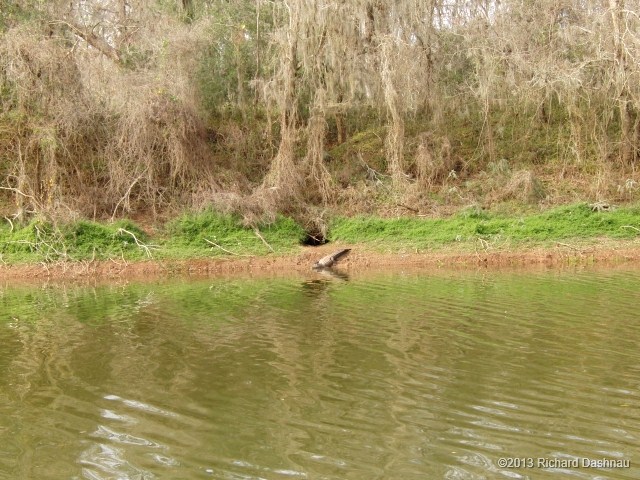 --
--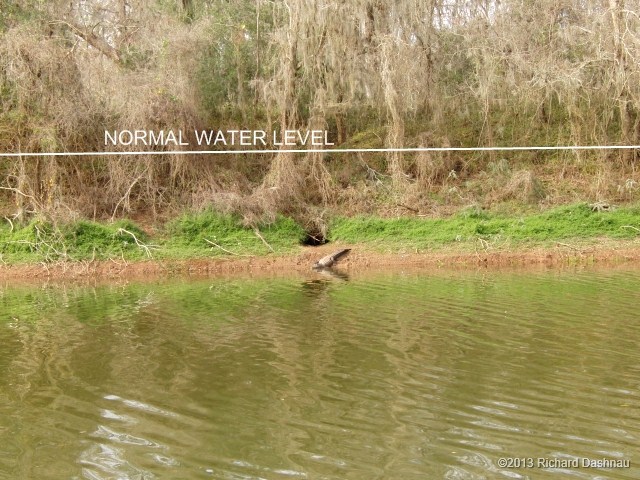 --
--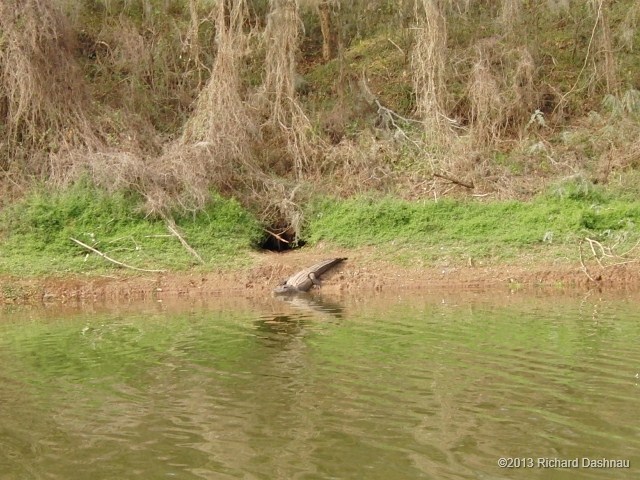 --
--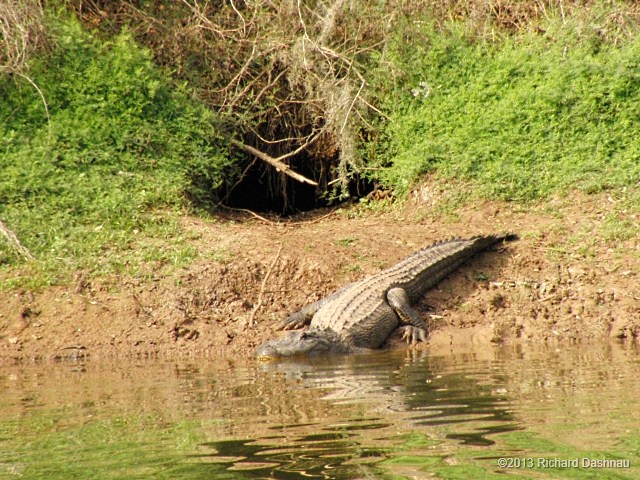
HALE
LAKE DEN WITH ALLIGATOR
NORMAL WATER LEVEL ABOVE DEN
SOMEWHAT CLOSER VIEW
LARGE DEN ENTRANCE
-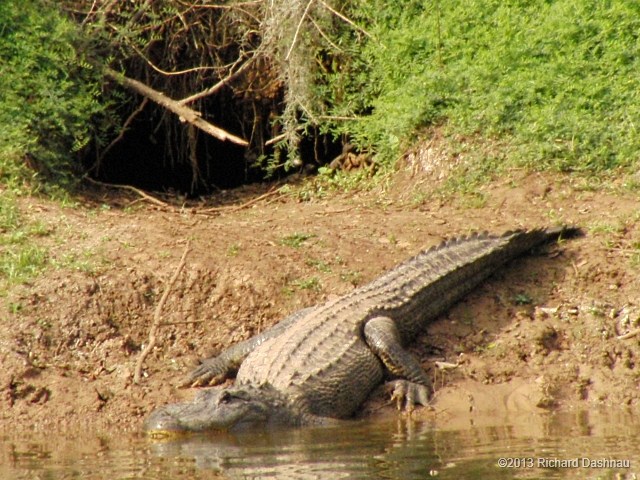
THIS
IS A LARGE ALLIGATOR
At
the end of 2011, water levels were low again. The low water caused two
dens to be exposed on an island in Elm Lake. A large pod of about 30
baby alligators was near the den.
The pod remained near the den into
the beginning of 2012. Starting in January of 2012, Elm Lake was filled
by pumping water from Pilant Lake. Finally, the water covered the
entrances to both dens; and the mother and baby alligators were gone.
The pictures below are from January of 2012.
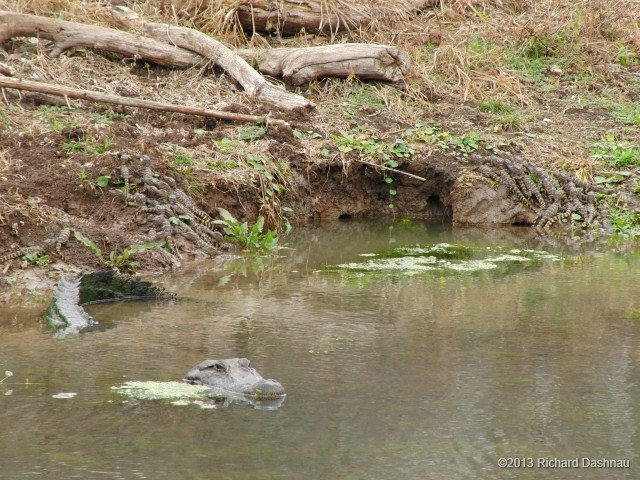 --
--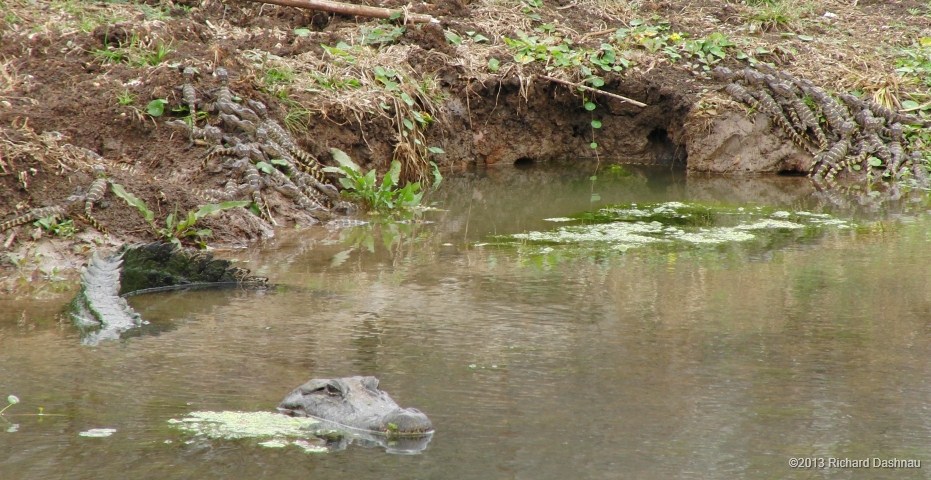 --
--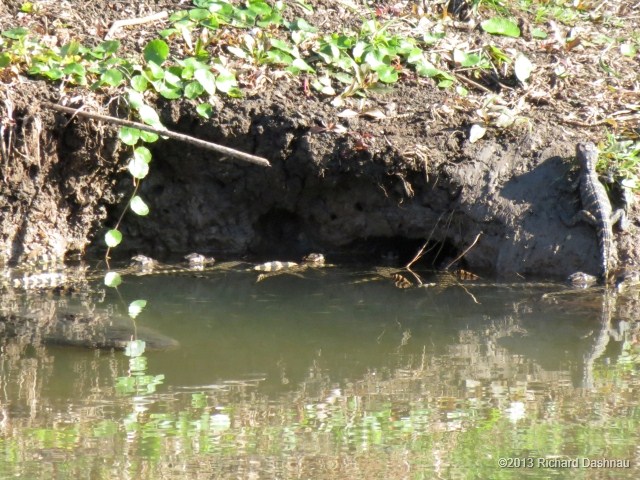 --
--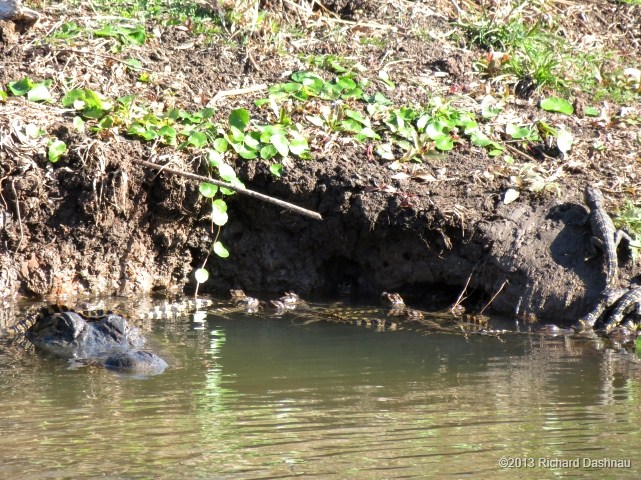
01/22/2012
ELM LAKE MOTHER, BABIES, DEN
01/22/2012
BABIES ARE ON EACH SIDE OF THE DEN OPENING
01/29/2012
MOTHER SUBMERGED
01/29/2012 MOTHER, SURFACED
7/26/2013 This
den was in Pilant Lake--actually visible from the North loop of the 40
Acre Lake trail. I
noticed some movement near the waterline. Something large was moving
under the
water, and I assumed that it was an alligator herding prey
(what I call "seining"). But, when no prey was flushed out, and the
alligator never caught anything, I knew otherwise. I believe the
alligator was digging a burrow.
All of the the images below are frame captures from video clips I shot
during this time. Clicking the links as I label them below the images
will
show the clip
that those images came from.
An
interesting point to consider is that although many people seem to know
that alligators make burrows (or dens), there seems to be very little
information about how they actually make
these burrows. An alligator's front feet (manus) barely reach to
the tip of its nose when its skull is in line with its spine. How does
it dig forward, and move the mud out of the way - and out -
of the
burrow?
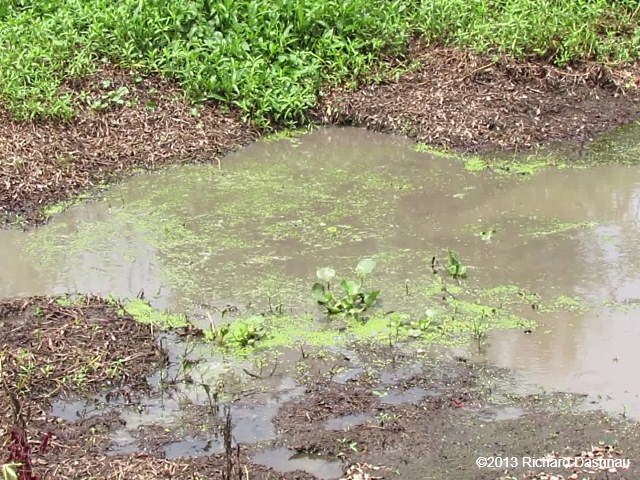 --
--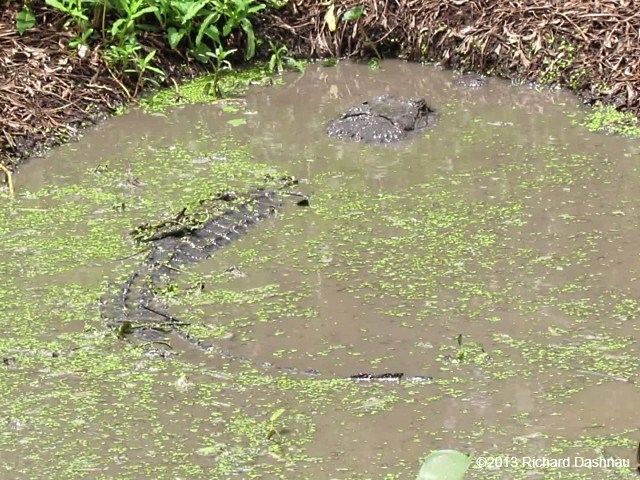 --
--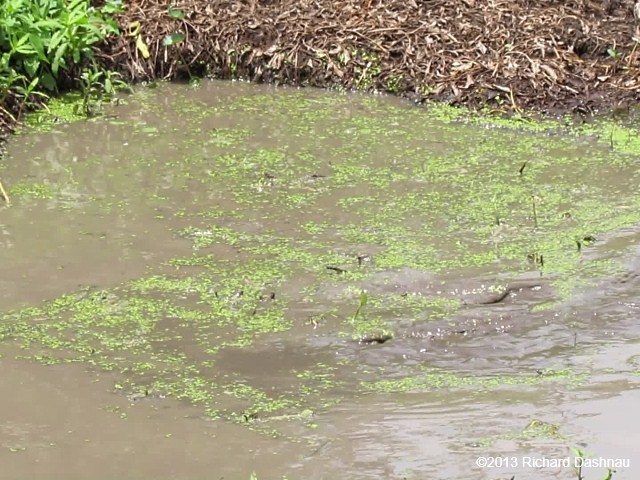 --
--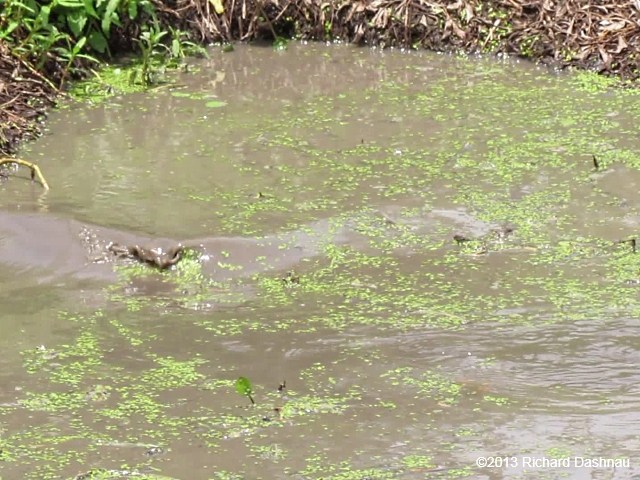 -
-
TWO
SWIRLING CURRENTS
ALLIGATOR SURFACES
UNDERWATER MOVEMENT
TURBULENCE
DEN DIGGING
WMV 28.6MB
DEN
DIGGING MP4 28.3MB
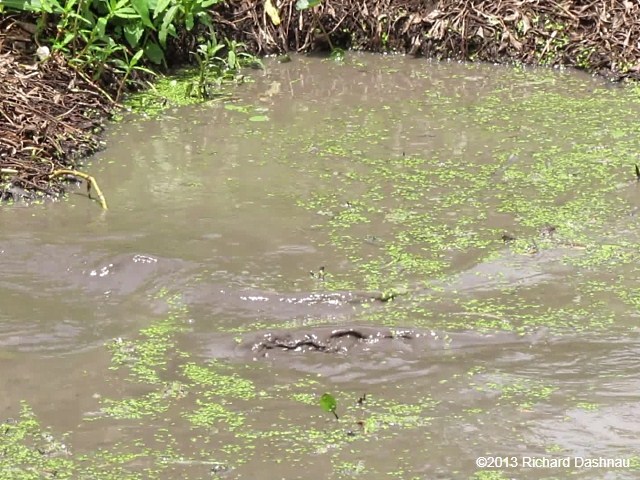 --
--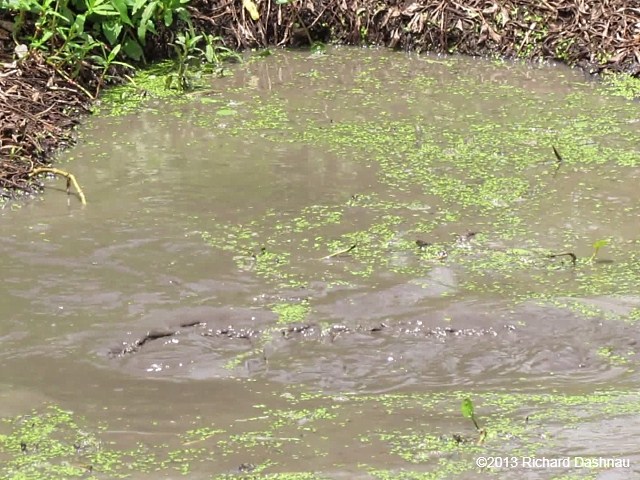 --
--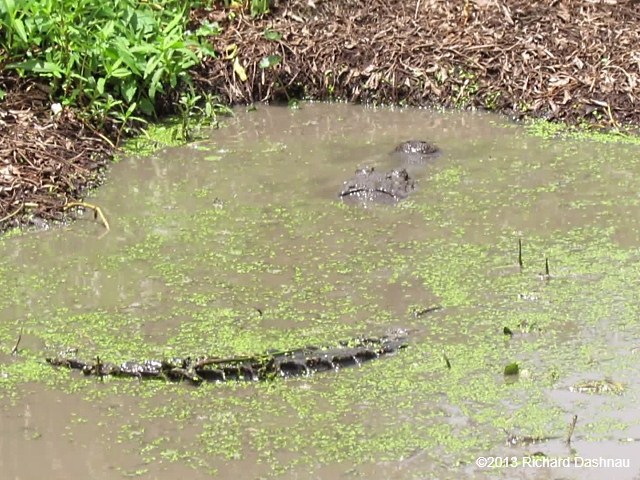 --
--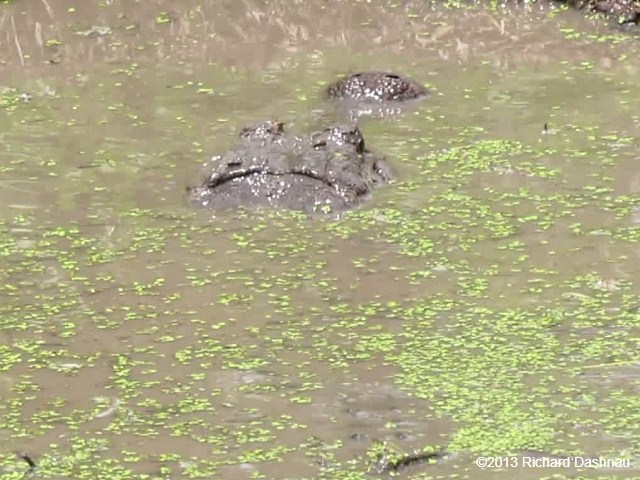 -
-
MORE TURBULENCE
EVEN
MORE TURBULENCE
SURFACING AGAIN
HEAD COVERED
WITH MUD
By 8/11/2013,
the water had all but dried up, but there was some remaining
in the den.
And,
sharing the den (and the water) was at least one small frog. The first
3 pictures were taken in the morning. Later in the day, two vultures
were poking around the edge of the den.
The alligator did not
confront them. The vultures appeared to be picking at the
moist,
rotted wood in the mud. The last picture was taken after noon.
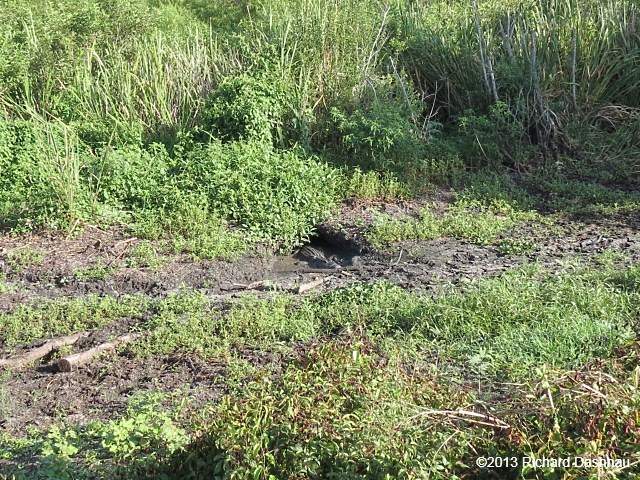 --
--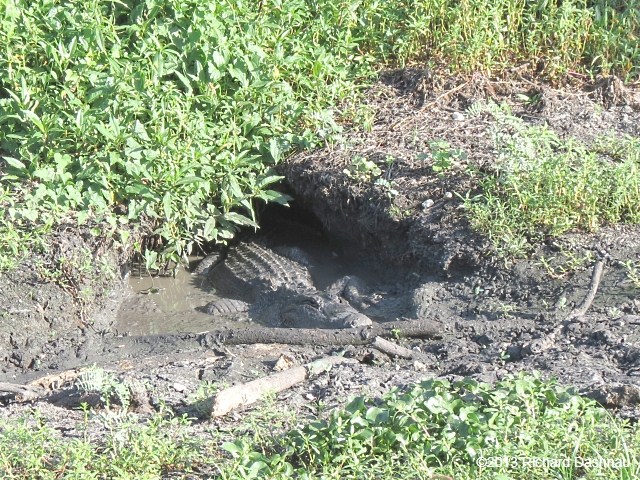 --
--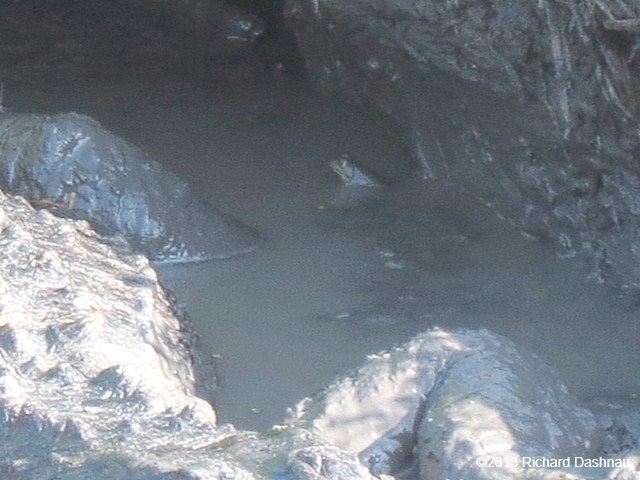 --
--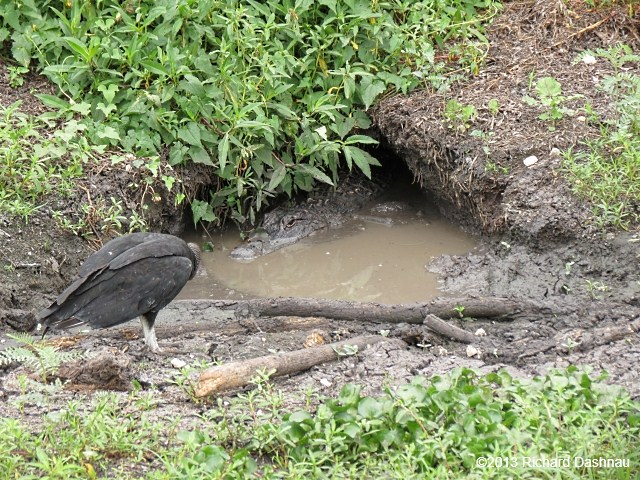
REALLY,
REALLY
DRY
ALLIGATOR
IN THE DEN ENTRANCE
A FROG
SHARING THE DEN
SPACE
VULTURE PAYS A VISIT
By 8/25/2013,
we'd gotten a little rain. But we also got some baby alligators!
If
there had been a nest near this den, then it wasn't easily visible from
the trail. But the baby alligators sure found the den! I think the
mother
alligator was under the water, but I
never saw her.
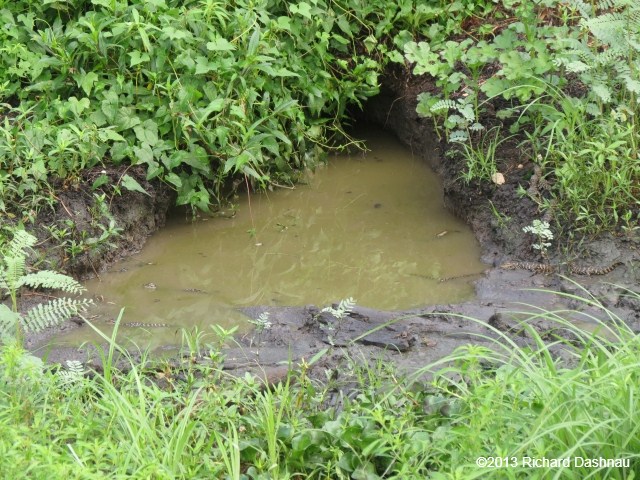 --
--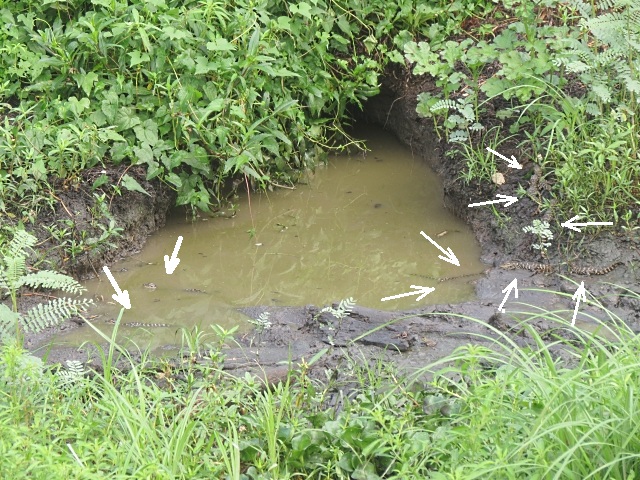 --
--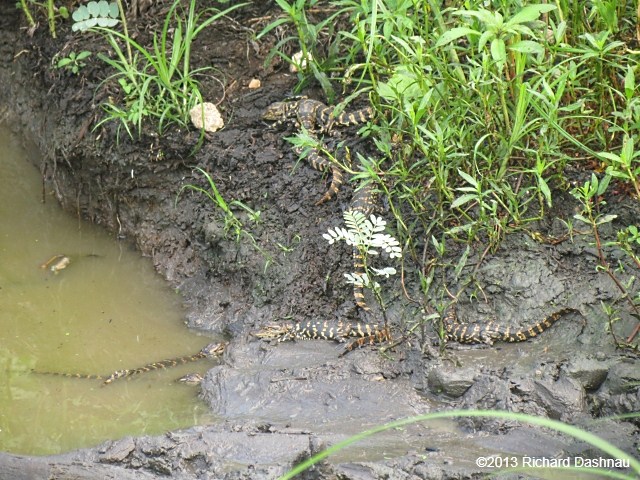 --
--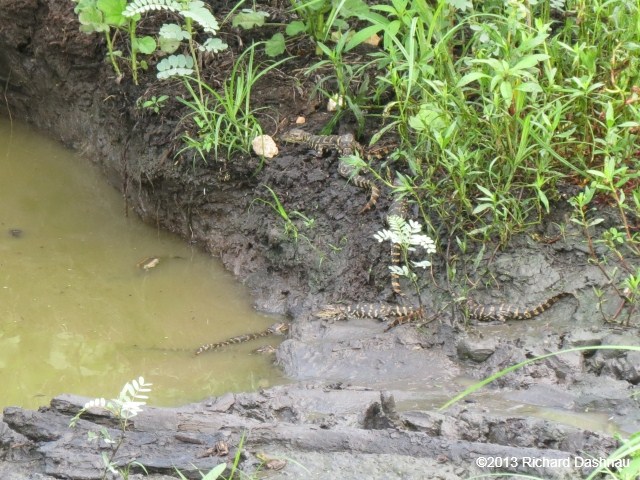
9 BABY ALLIGATORS NEAR THE DEN
9 BABIES POINTED
OUT
RELAXING
BABIES
THE
BABIES AGAIN
-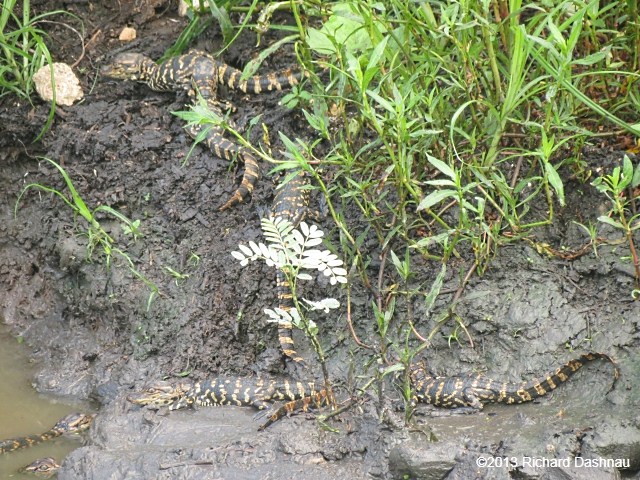
CLOSE-UP OF SOME BABIES
By
9/01/2013, we'd gotten a little MORE rain, as shown by the lush
greenery. Here's the den, apparently uninhabited by then.
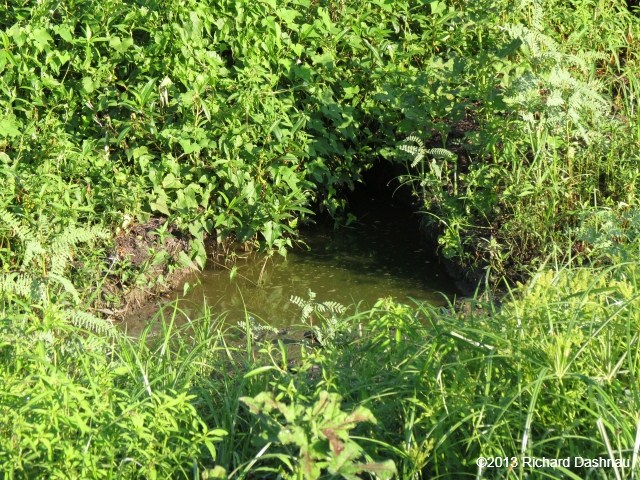 --
--
THE
DEN
12/25/2013--I
made the first 2 animated gifs below from screen shots of a model I
made of
an average alligator
den. I used the mid-range measurements, and
created this model
using FreeCad, a free, open-source 3D modeling software. It's my first model
using this software. Next,
I subtracted the first model from a
"block", and added some simulated
digital "alligators", to show the den inside substrate. The last 3
anigifs are different views of this model.
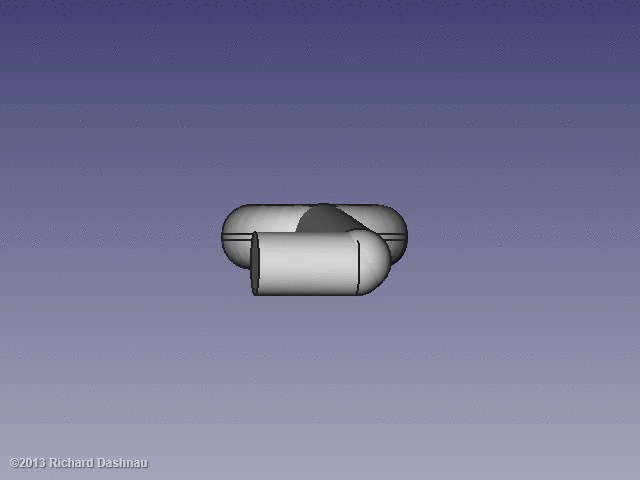
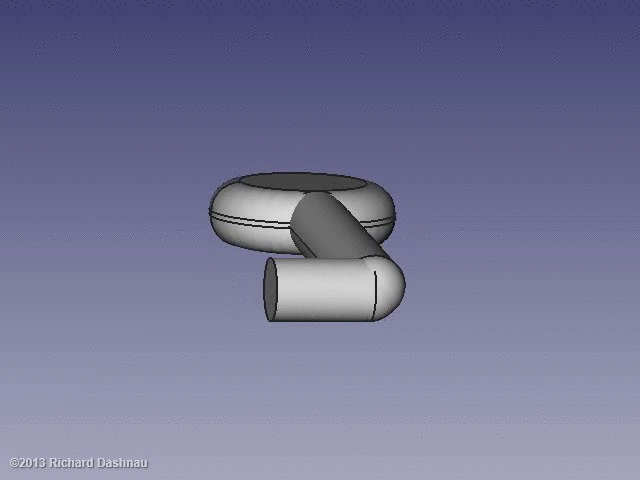
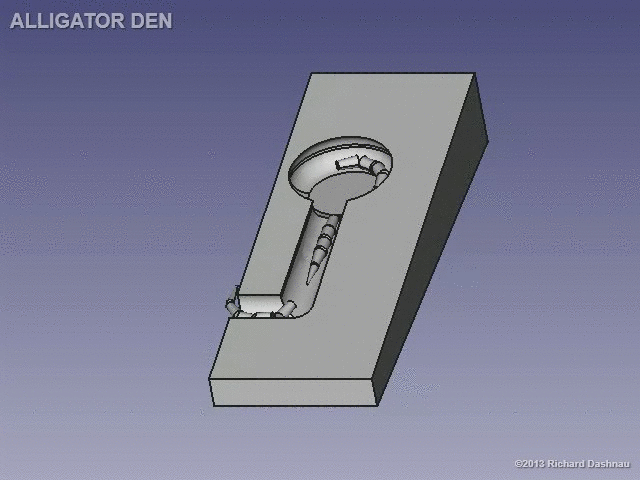
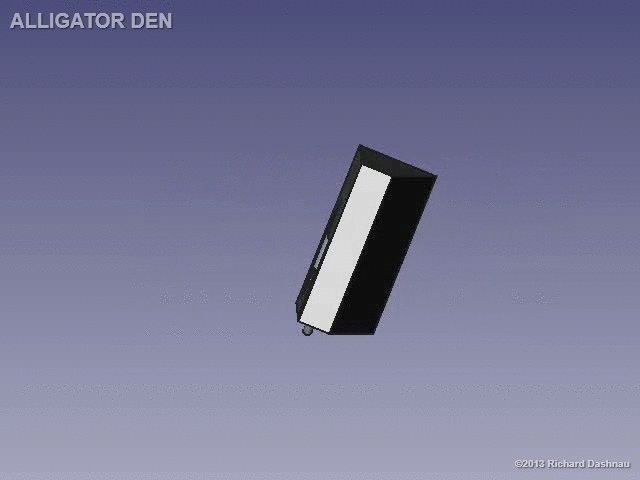
Alligator Den FLAT
Alligator
Den TILTED
Alligator
Den in Block
Alligator
Den in Block
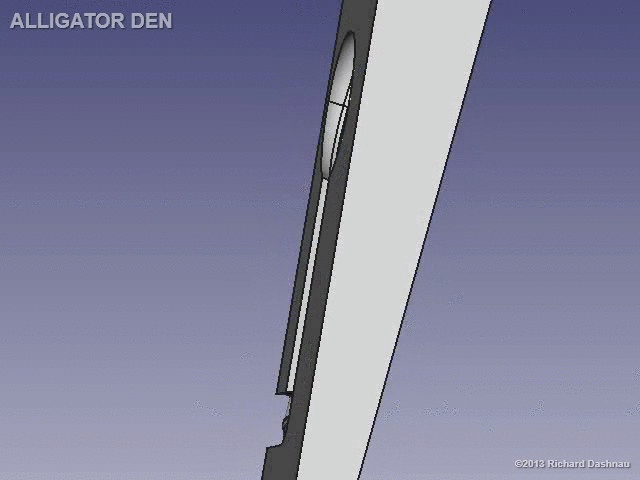
Alligator
Den in Block
This 3D PDF should allow for
real time rotation of the model. Instructions are shown on the sheet.
Try the link here.
NOTE--this
file may not work when viewed in your
browser. Try downloading the file
and opening it with your pdf software (like the Adobe viewer).
According
to Dr. Martin's writings,alligators will sometimes nest near a den to
allow easy access to the shelter. This
would also explain how the small babies could survive
their first few
winters-the den would be an excellent temperature
buffer to prevent the worst cold from reaching them. I've
read that a den
can be used to shelter baby alligators, and I have seen this in
practice. One example: At the end of 2011, low water level revealed a
den on an island in Elm lake. During the winter, a mother alligator and
about 30 babies could be seen using the den
until rising water hid it
again. From the same sources, I have also read that
dens can be used over many years, and a single den may be the shelter for different
alligators over time.
12/29/2019 There
has been a female alligator with babies visible in 40-acre lake since
the summer. She has been in the same area, and I suspect that
she
has
dug a "gator hole"; a den, or both. She has also made an opening
in the vegetation in "her" area. I usually start my walk at 40 Acre
lake, and I've been looking for
her. I've usually seen her-at least
her head-even on the cold days of our fall/winter season.
Since
I usually pass her spot close to 8am, the day is certainly near
its
coolest point.
On
this morning, I didn't make it to her spot before a cold front came
through and it rained. I went back out to the lake at about
11am,
after the rain had stopped,
and after the temperature had dropped
from 70 F to 55 F (in about 2 hours). I returned to her spot
and
I did not see her head above the
surface, but I could make
out the shape of her body under the
water.
I carefully examined the plants there,and I eventually found
a few baby alligators. There seem to be at least 2
generations of
babies in her group. I spotted one of the larger ones (probably
over a year old) and some of this year's babies. The images below
(and the
RICKUBISCAM shot) show just one of these babies. I
waited to see if the mother would surface to get some air, and I was
finally rewarded when she did. She also
appears in the images
below. The
events here show some examples of how the alligators deal with cooler
temperatures. The largest one (mom) stayed underwater,
which allowed
the mass of the water above to shield her from the cooling air. The babies also
stayed in the water, but they did move closer to the bank.
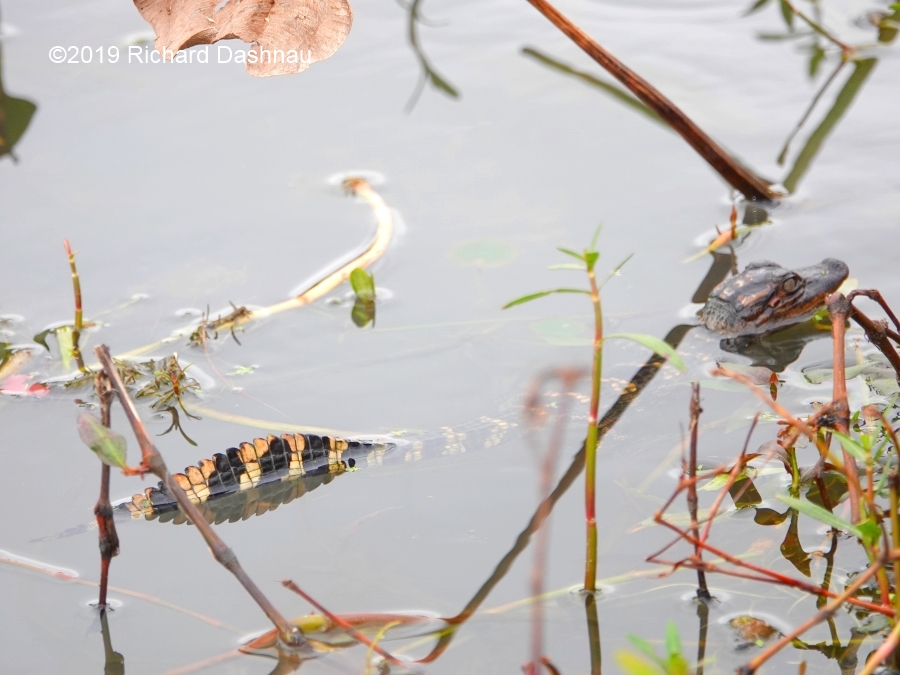
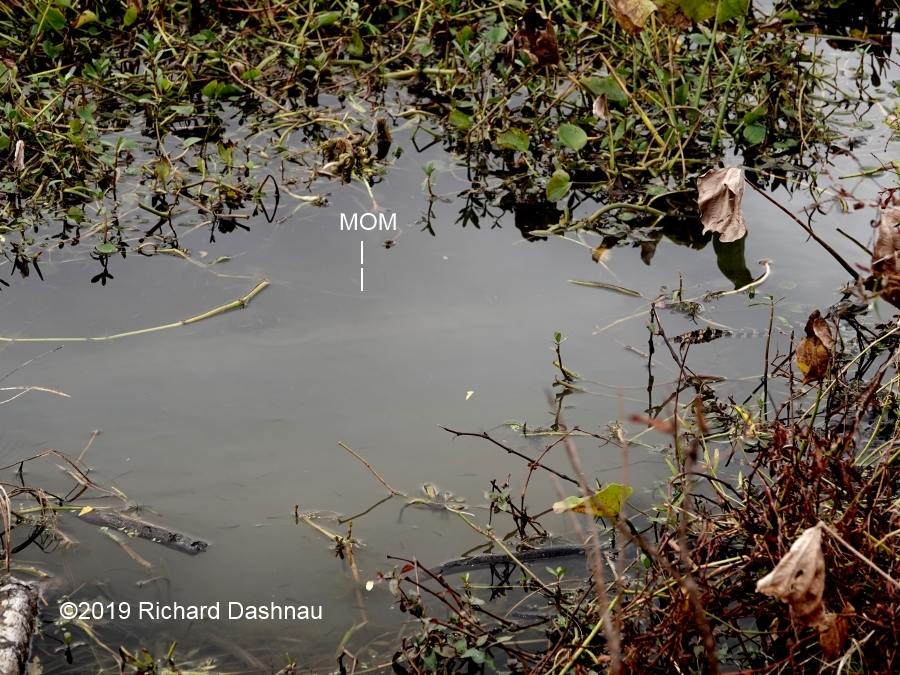
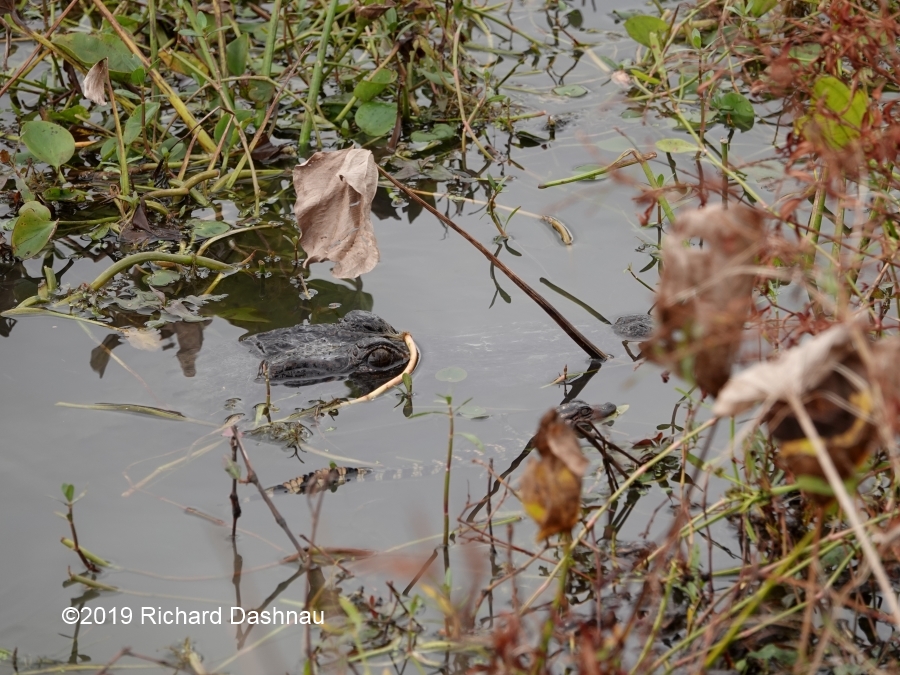
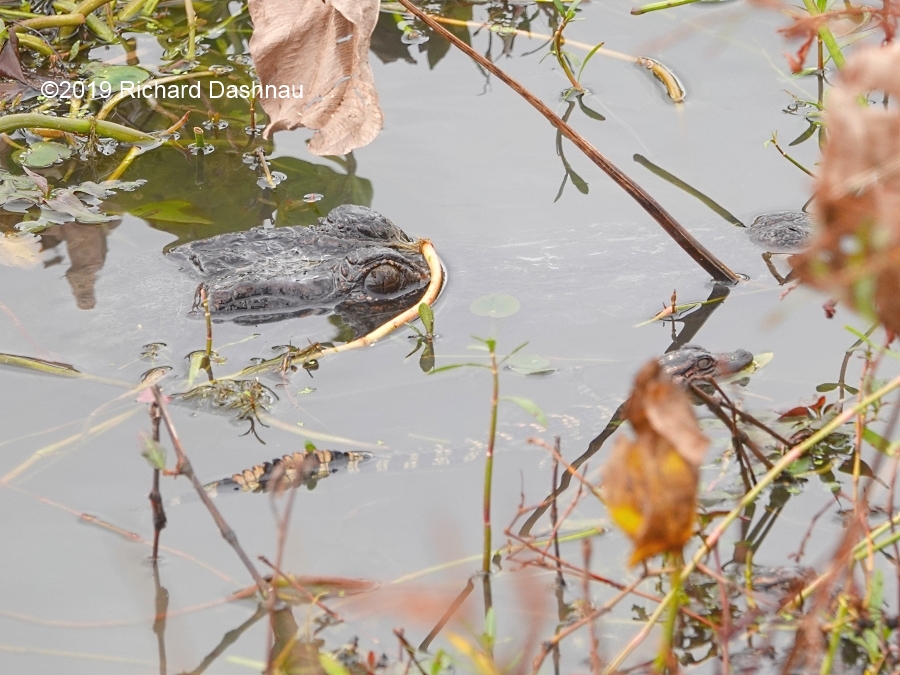
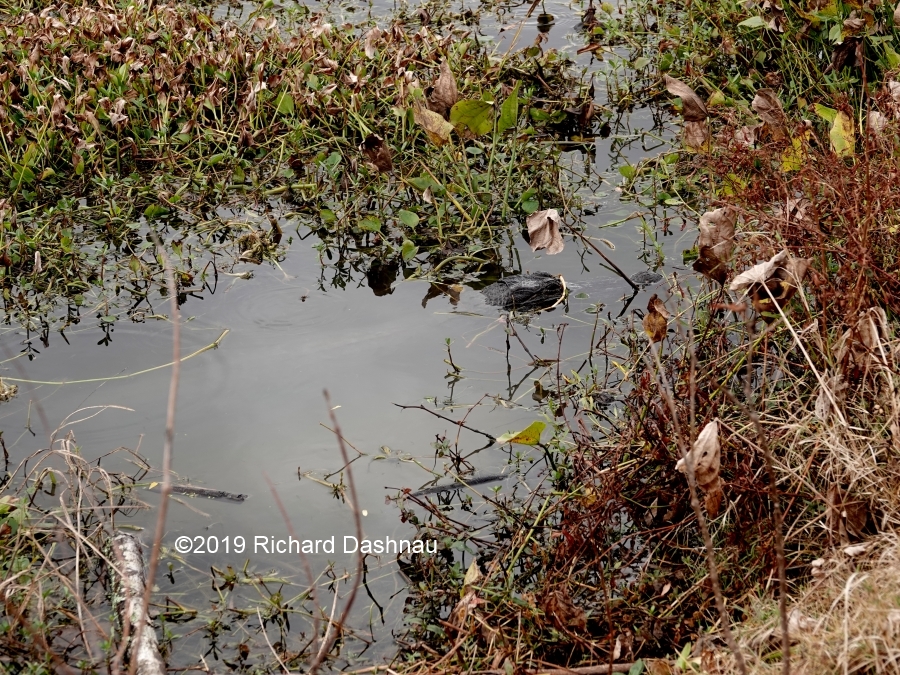
01/19/2020
The morning of 1/19, I found the mother alligator
in her spot. I
could see a cloud of silt suspended in the water around her.
Over
the previous weeks, I'd
guessed that she was digging in that
spot--either making a hole, or a den. When I looked at her
position near the bank, I realized that I'd been right. She had been
digging a burrow!
In the pictures, it's obvious that her body
is in a burrow under
the bank, with her head coming out of the
opening. (pic 2,1,3) I was able to find a few of the babies
hidden in the plants just behind her head (4). A closer look
shows that her snout has mud smeared on it, another indication that
she's
been digging(5). Alligators dig
burrows with their jaws, and probably widen them by digging with their claws.
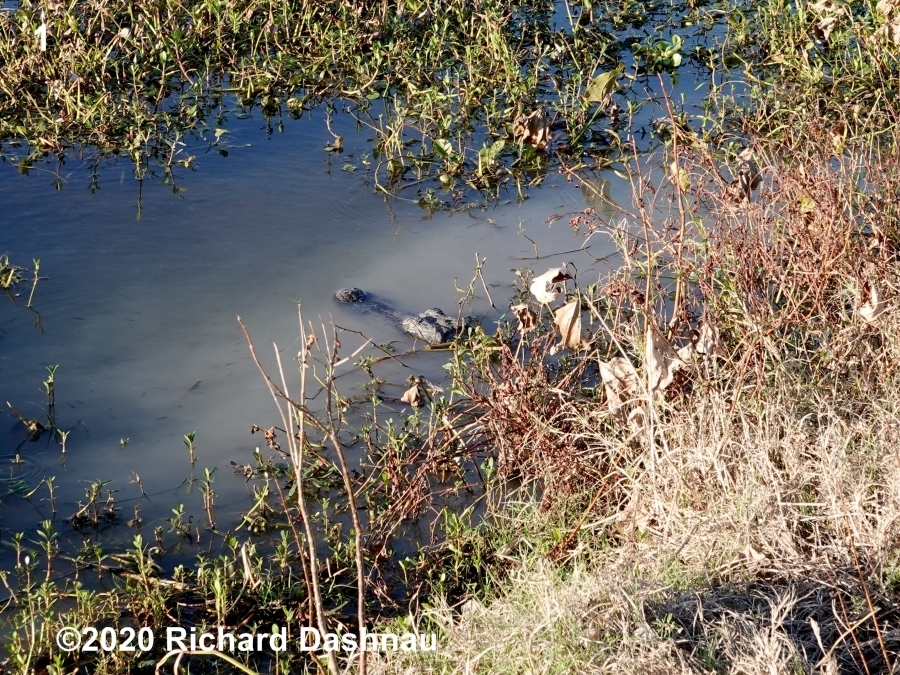
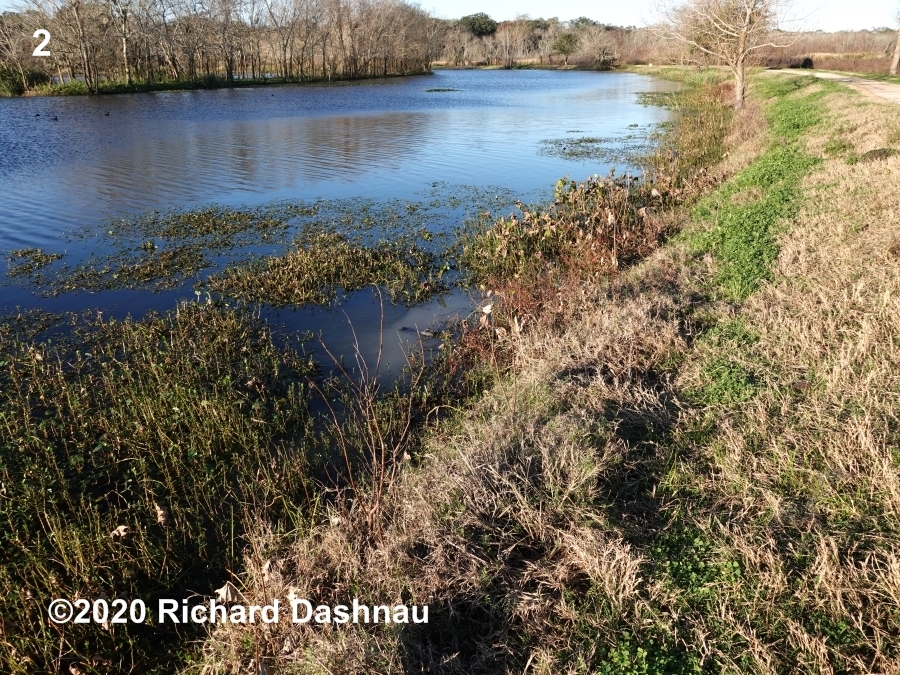
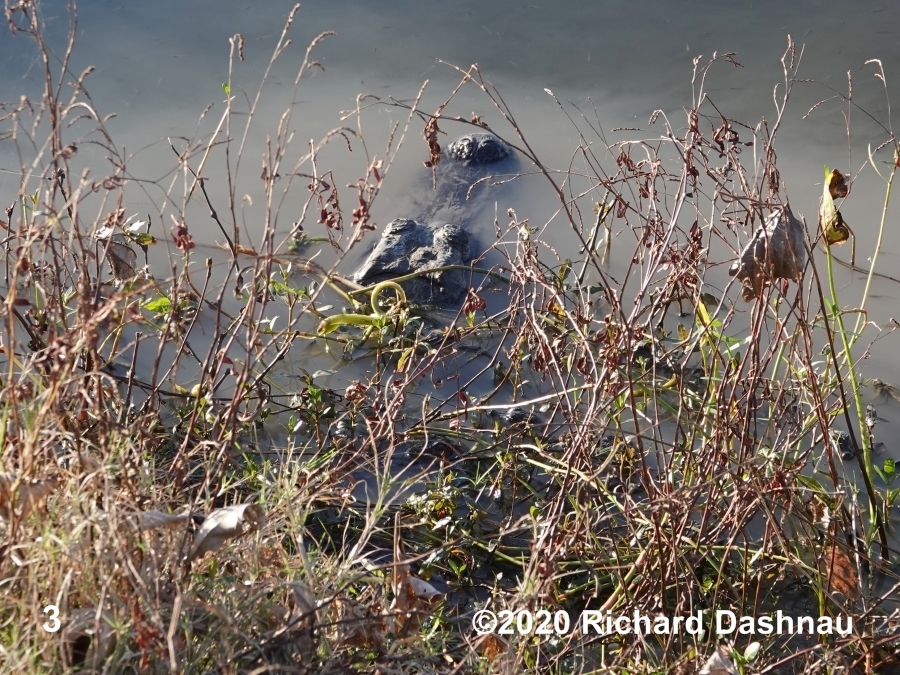
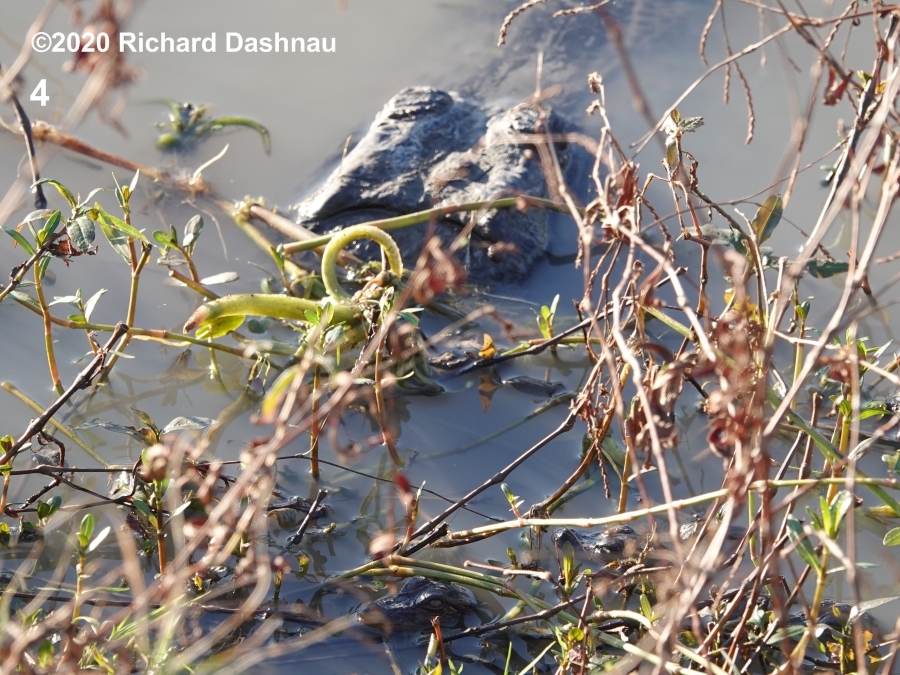
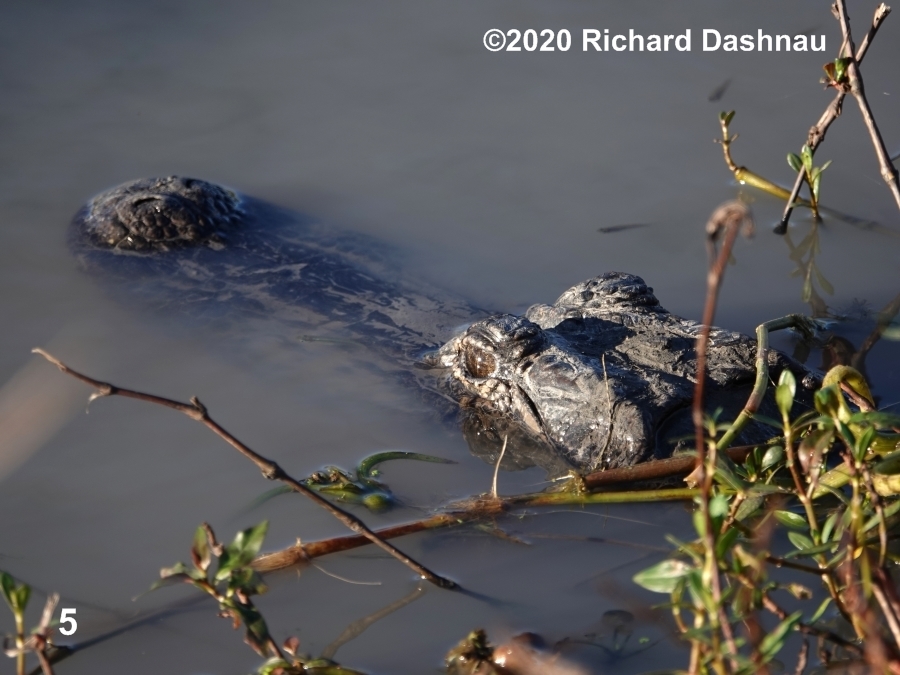
About
an hour later the baby alligators started showing themselves (6). I
left mom for a while while I searched for other animals--such as otters
(and I did catch a
glimpse of one on the Spillway Trail). When I
returned after an hour (about 10am), the baby alligators had started
getting out of the water, including this one on
mom's head (7). By
10:35, there was a pile of baby alligators on the bank (8). From
this time, I remained near them, and would point them out to visitors
passing by.
The
air was still cool (high 40's F), and I would catch visitors'
attention by asking if they were looking for gators. Then I'd
tell them that I could see 15 (at least
15).
Meanwhile,
where was mom? Mother alligator was sometimes visible, with her head at
the surface as before; but then she'd submerge; and slide BACK INTO HER
BURROW. So, sometimes she was visible when visitors came by, and
sometimes she wasn't. With all of this, I spent a lot of time doing
running commentary, so I
didn't get a chance to take many
pictures. But, I was alone one of the times she submerged and I was
able to mark the time: 11:25. She moved out of sight
underwater.
So there
was this pile of baby alligators on the bank, apparently unprotected
with no mom gator in sight. But, she was just a foot or two away, and
UNDER them.
About 25 minutes later (11:50) mom's snout appeared
(9), but she did NOT surface. She remained under water, and went back
into the burrow. After 14 more
minutes, mom finally surfaced.
(10,11,12) She'd been under for 40 minutes! After that, when someone
asked how long an alligator could stay under water, I could
point to
the mom alligator (or, where I knew she was) and say "I know that
one can do it for 40 minutes." I had to leave at about 12:30
to
help with a program.
I returned at about 3, and spent another 30
minutes with the group of gators. The babies were still there, and I
lost count at 20, since they were tangled together,
and moving around. (13) But, mother was still nearby (14).
That was my day, but it's not the end of the story.
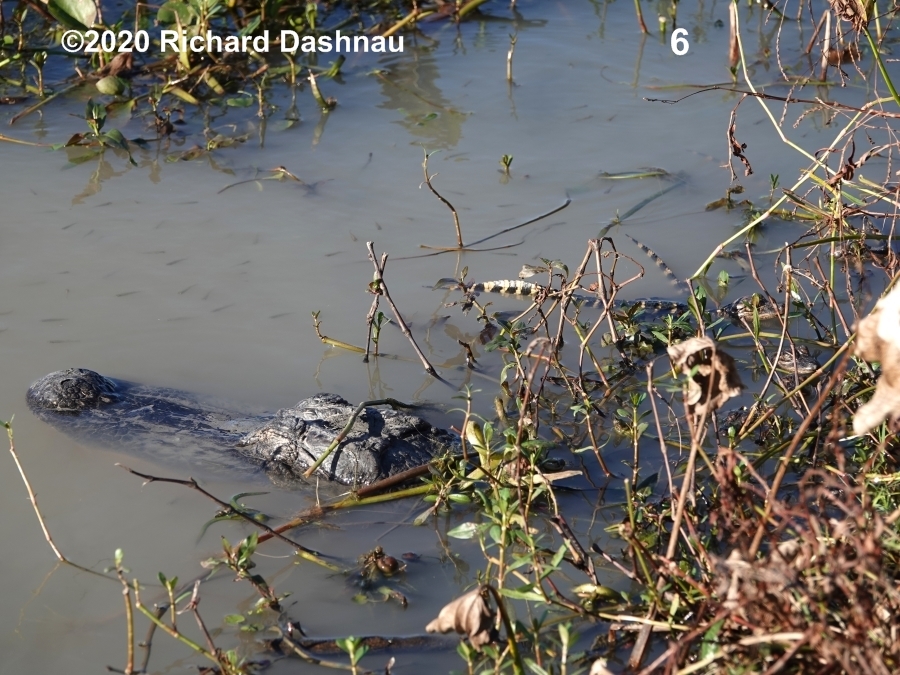
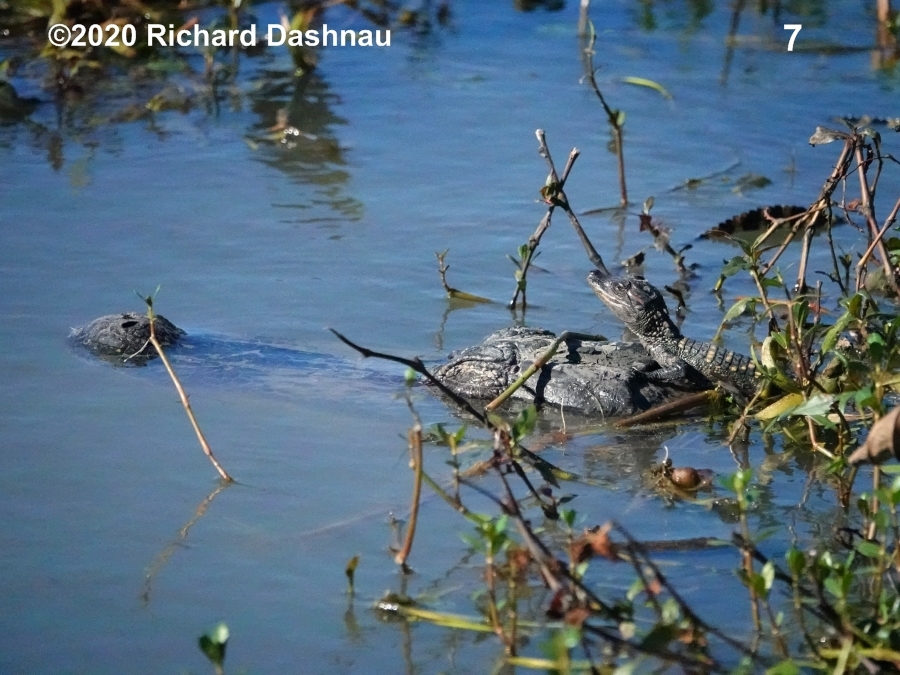
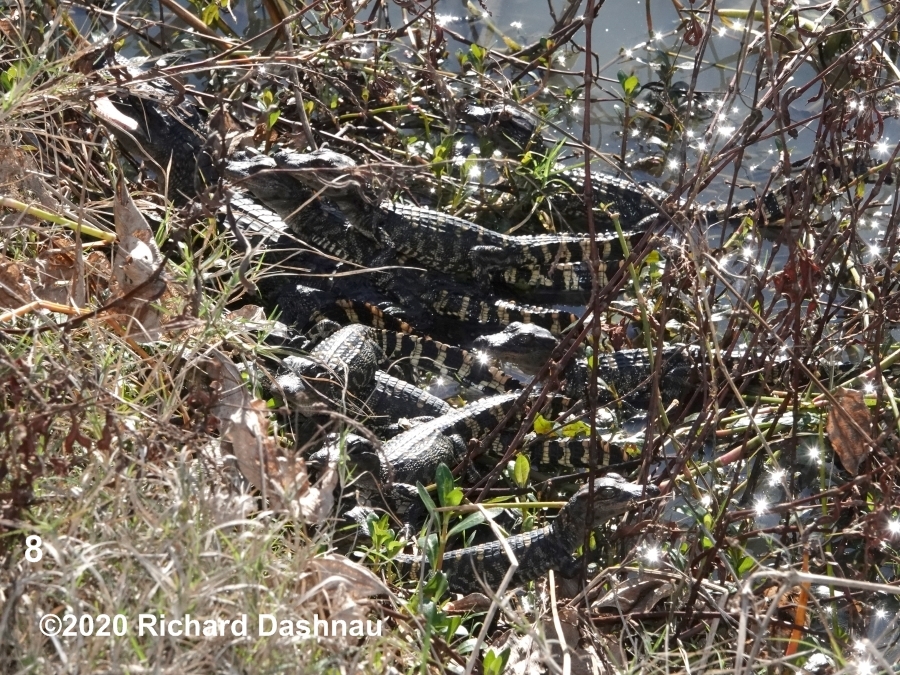
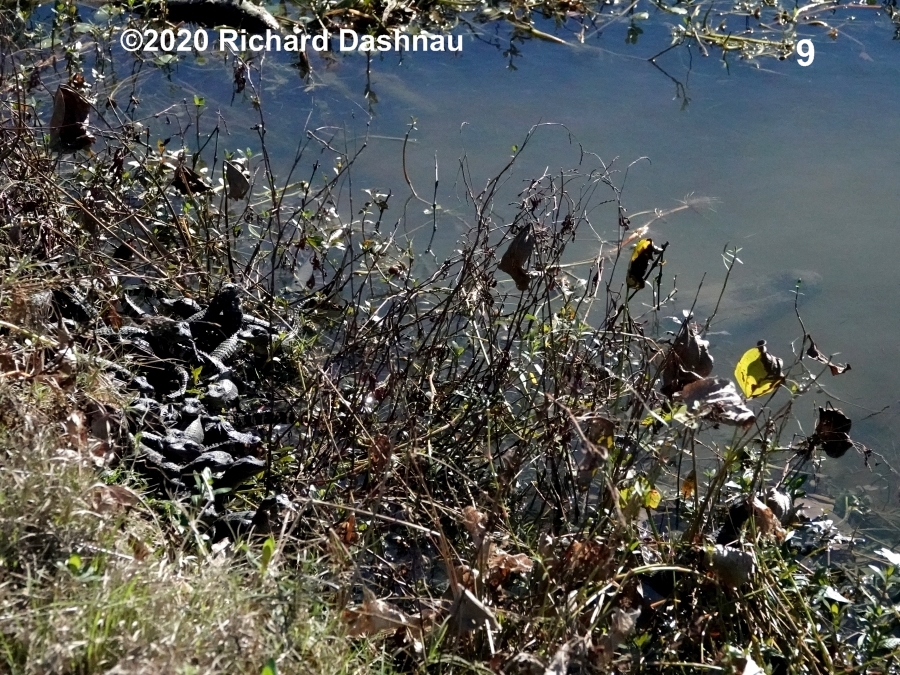
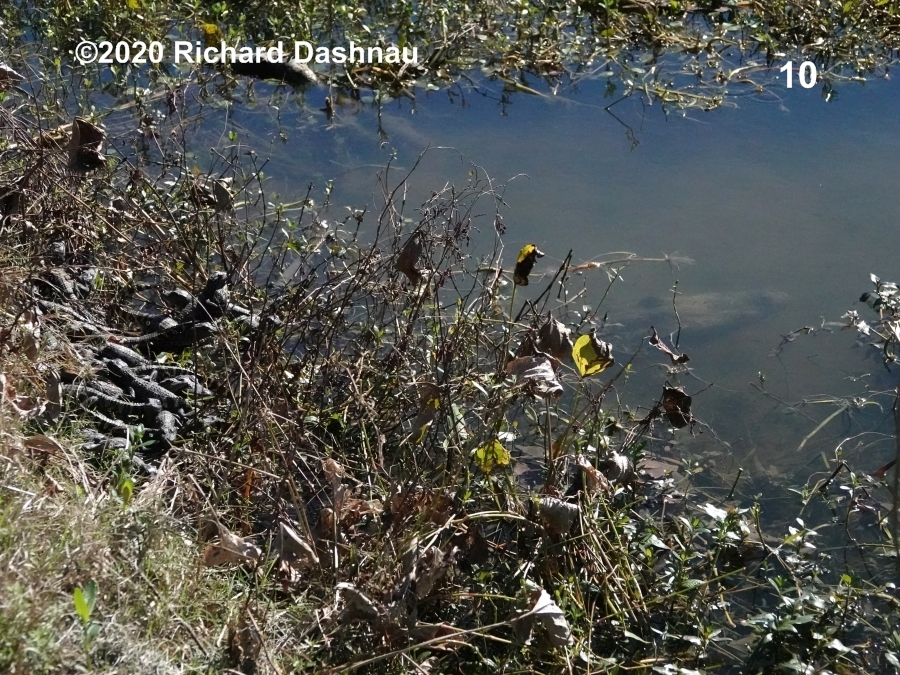
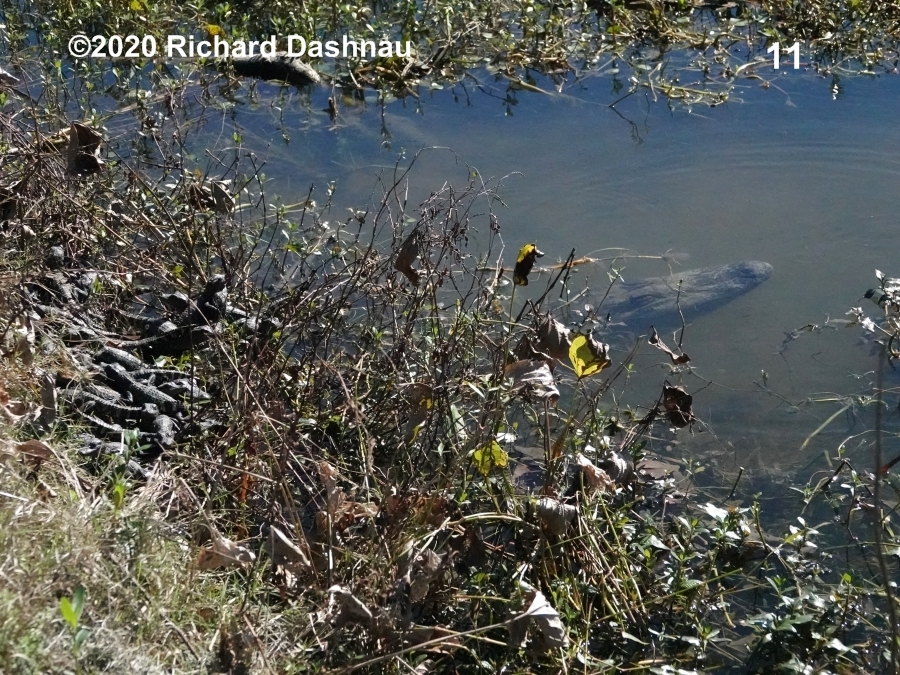
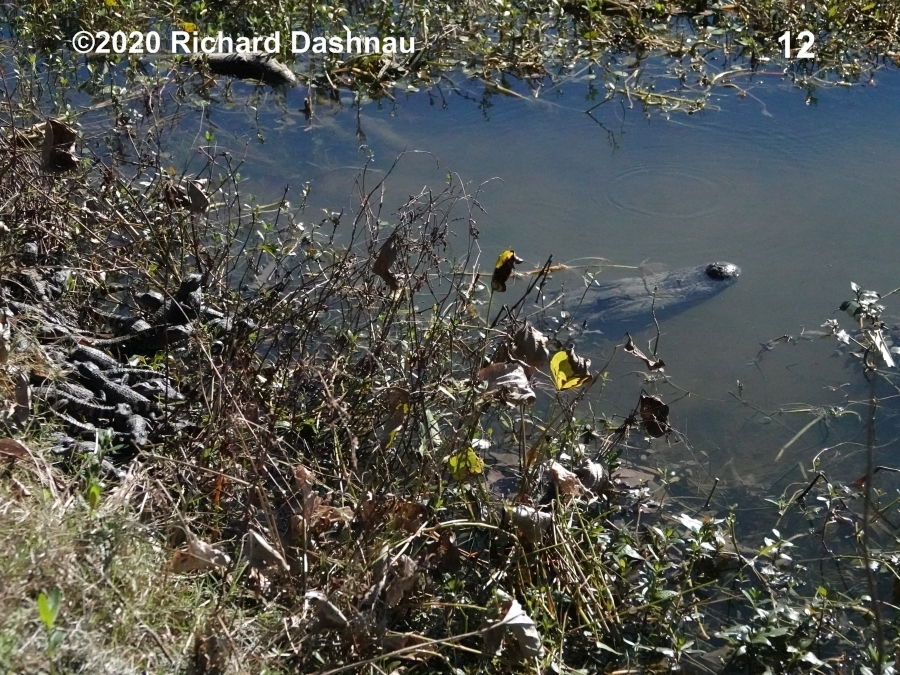
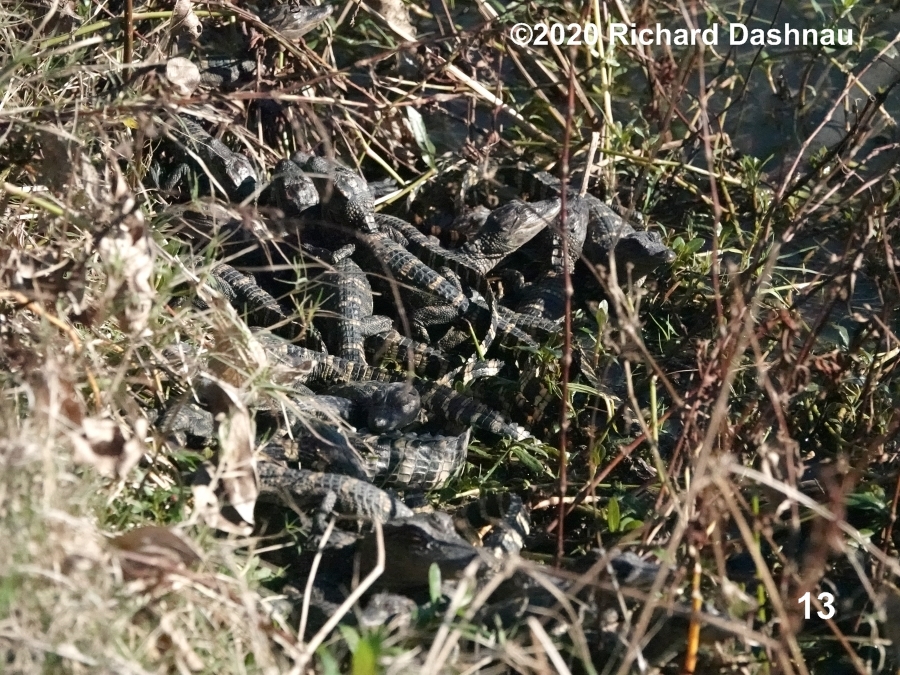
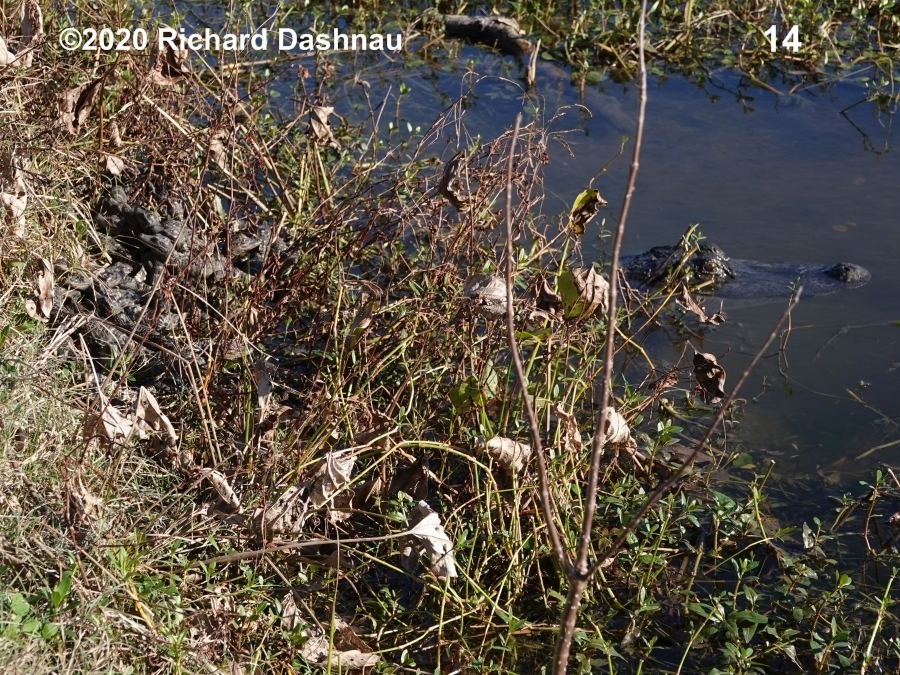
There
was a lot going on here, some of which I was able to share with the
park visitors. First, there was the burrow. Alligators are burrowing
animals (although they
don't all burrow all the time). Whatever that
hole is, at this time, it's long enough to hide most of a six-foot-long
alligator. From what I've read (see below) alligator
dens have a common
design. There's an opening passage (which is under water)
that's about 3 feet long. Then, a turn to the right or left, and a
longer section,
about the length of the alligator making the burrow
(and of course close to the thickness of the alligator). Finally it
should open into a "chamber" that will allow the
alligator inside to
turn around. The
entire construction could be about 12 feet long.
Second-The
babies gathered on the bank. Why? To warm themselves in the
sun
because they cannot generate their own heat. But, for the entire day,
the mother
never left the
water to get into the sun. Why not?
Thermoregulation in alligators (and many reptiles) is not as simple as
"When it's cold, get to the warm place and
heat up".
The air
was cool (high 40's in the morning, up to 50's during the day), but it
hadn't
been cold for very long. The water was probably warmer than the air.
The mom
gator was quite a bit larger than the babies. The
babies warm up and cool down much faster than the mother. But the
mother would cool
much slower. With the
difference in water
temperature, and her greater mass, and the way she can control
heat loss through blood flow (which-incidently-could have helped
conserve
oxygen)--mom may have been comfortable where she was. And
then, let's get back to the den. The den creates a
temperature-stable environment. Water that
entered that den a
day
or so
before (air temps near 70F !) could even be a bit warmer still. Another
factor is any "acclimatisation" that may have occurred. Many
animals that are adapted to seasonal change can acclimatize themselves.
Those of us that have dogs as pets see an example of this when
dogs shed their winter
coat of fur to prepare for hot weather. That's a
physiological change that allows them to survive warm weather. This is
a reversible change driven by the season
(because their fur gets thick for the next cold season).
But, when the reptile is
in "winter mode", although it may work more efficiently in the cooler
temperatures,
it will require
its body to stay near the cooler
temperatures, and may even avoid heating. This could be
another
reason the female alligator did not get out of the
water to sun itself.
While
reptiles can't put on or shed a winter coat, they can alter their blood
chemistry and metabolism so they can function more efficiently at
seasonal temperature.
Studies of alligators have shown that they can
adapt to a large temperature drop and still perform normal bodily
functions. I've made reference to this on
another page, but I'll repeat some
sources here. The
book Biology and Evolution of Crocodylians by Grigg and Kirshner talks
a lot about this (there's an entire
chapter on "thermal relations").
Here are two studies on gator thermoregulation which can be found on line (at least one of which is cited in the
book--see links
on page).
"Body
Temperature Null Distributions in Reptiles with Nonzero Heat Capacity:
Seasonal Thermoregulation in the American Alligator"
" Seasonal acclimatisation of muscle metabolic
enzymes in a reptile (Alligator mississippiensis) ".
I
first read about reptile acclimatization (with a z) in the book How
Snakes Work by Harvey B. Lillywhite (page 110). In both books, the term
"acclimation" is used
for the same concept , but when the changes
are caused by experimental
means. There are many ways alligators
can control their body temperature. In this case,
the biggest
clue is the temperature over the 4 days preceding.
These are
charts I made from temperature data I got from Weather Underground for
Rosharon, Texas. Note how the temperature was
around 70F,
and that it had
only dropped the night before.
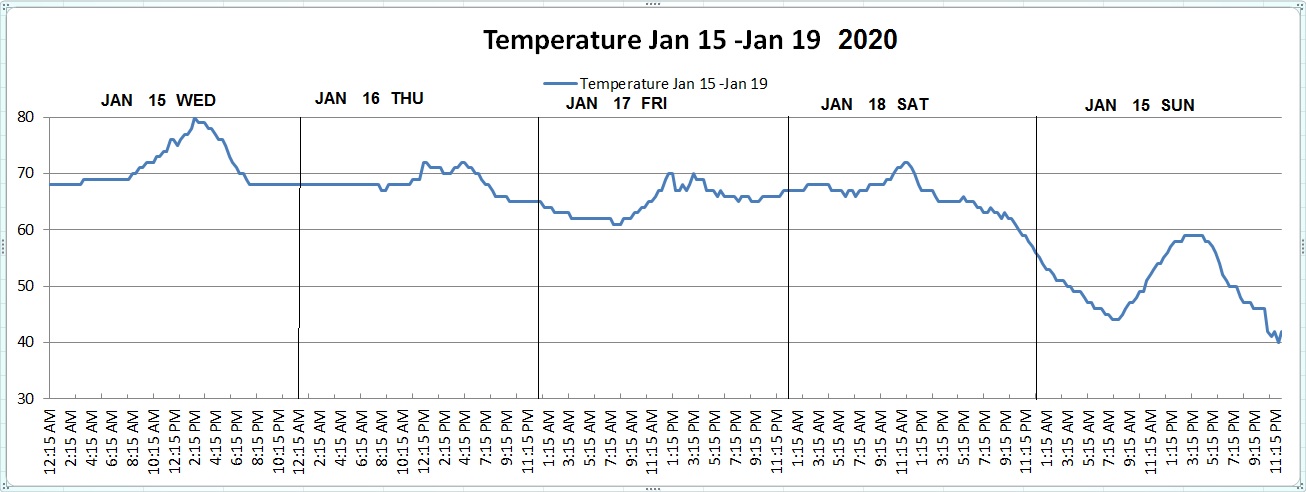
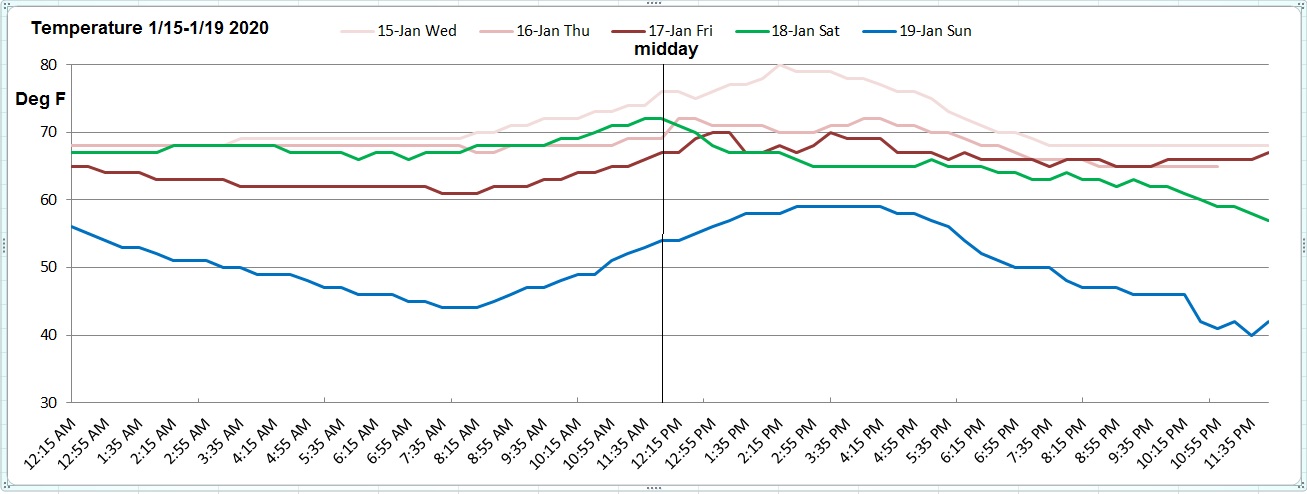
01/26/2020
I visited the baby gators and their mom a week
later. The morning
was cloudy, and the air temperature was about 60 F. Mother
gator
was not in her den,
but she remained submerged in the water. I used about 15
minutes to shoot some pictures, and this time, a short video
clip.
Then I moved off, once again looking for otters.
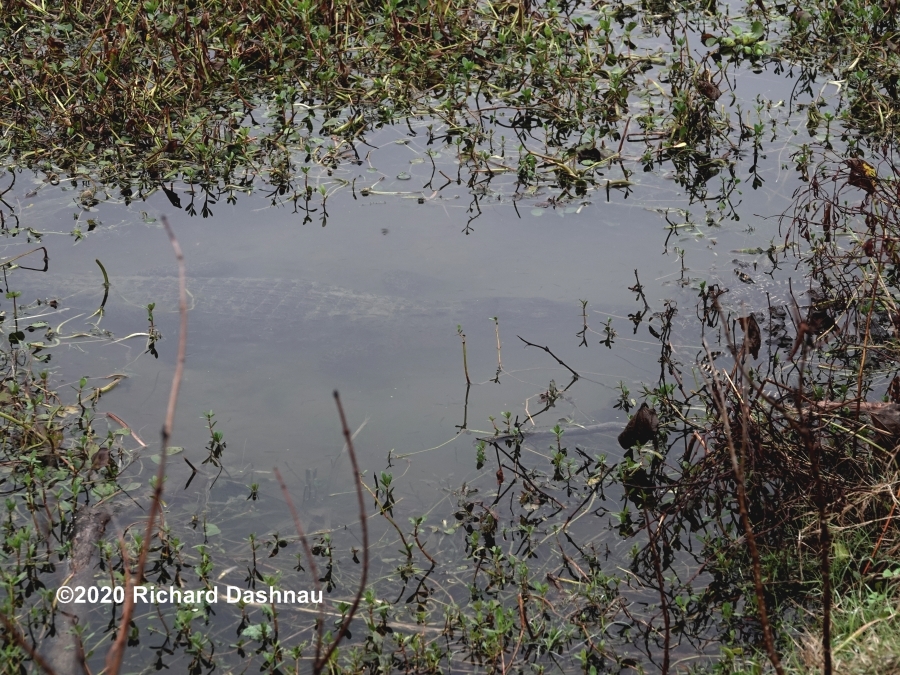
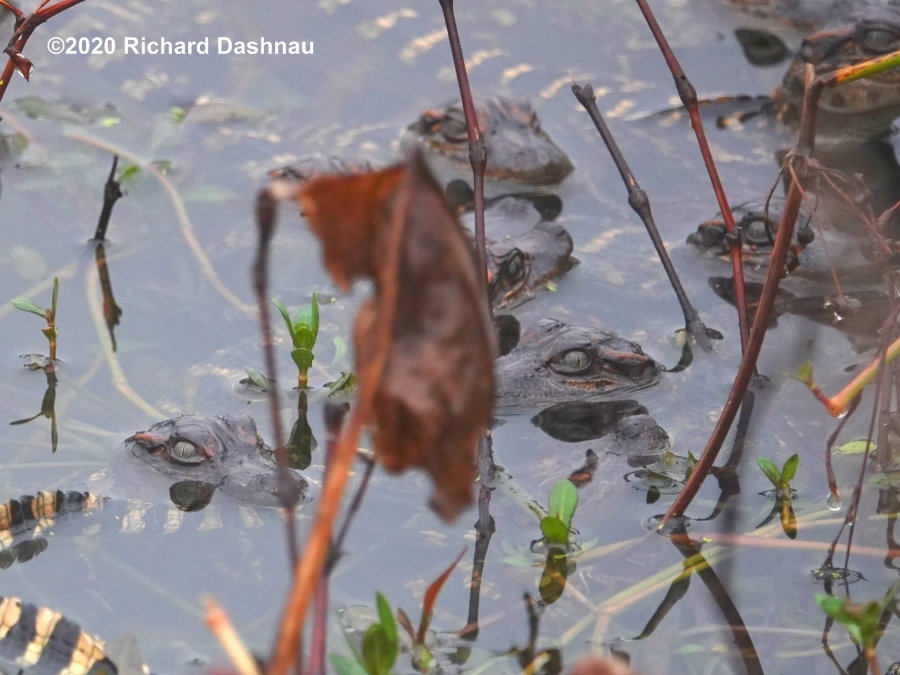
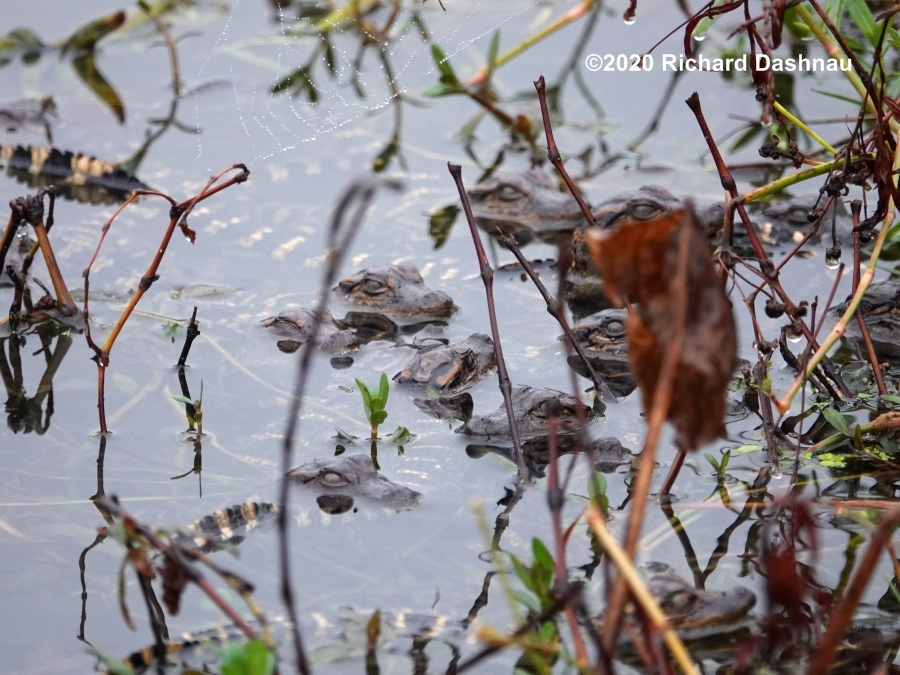
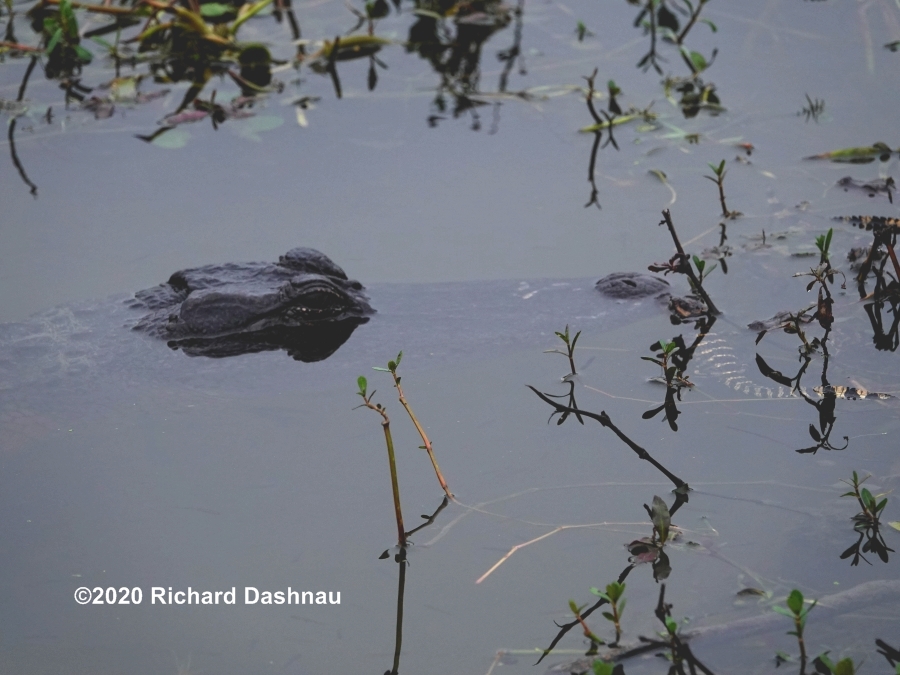
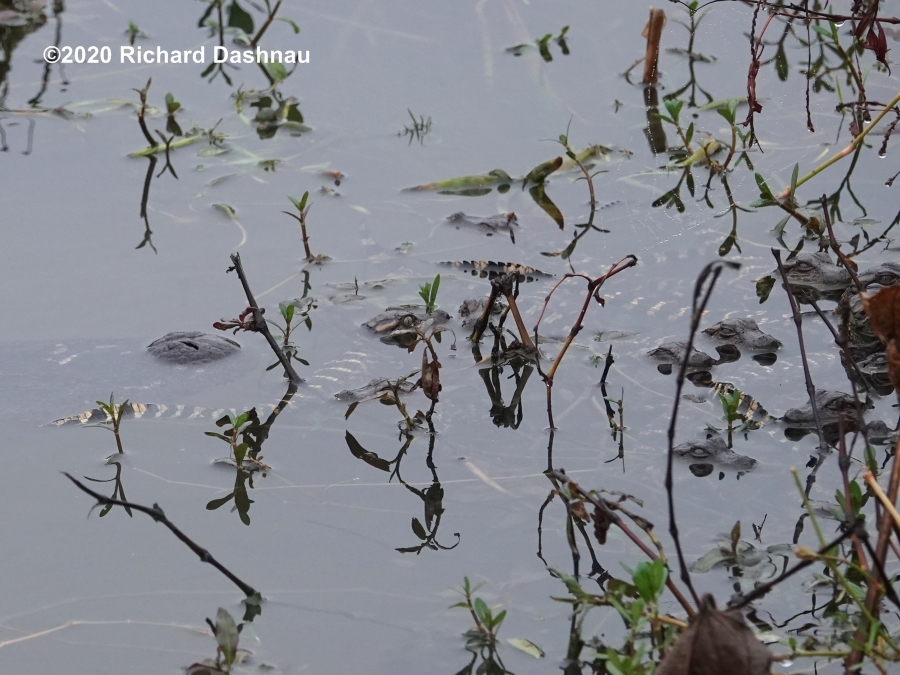
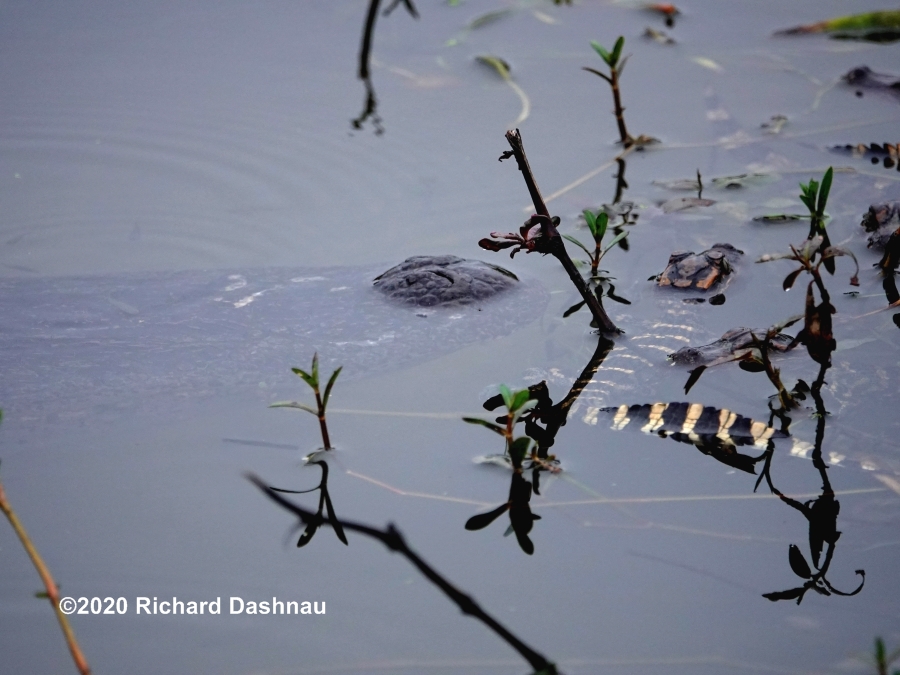
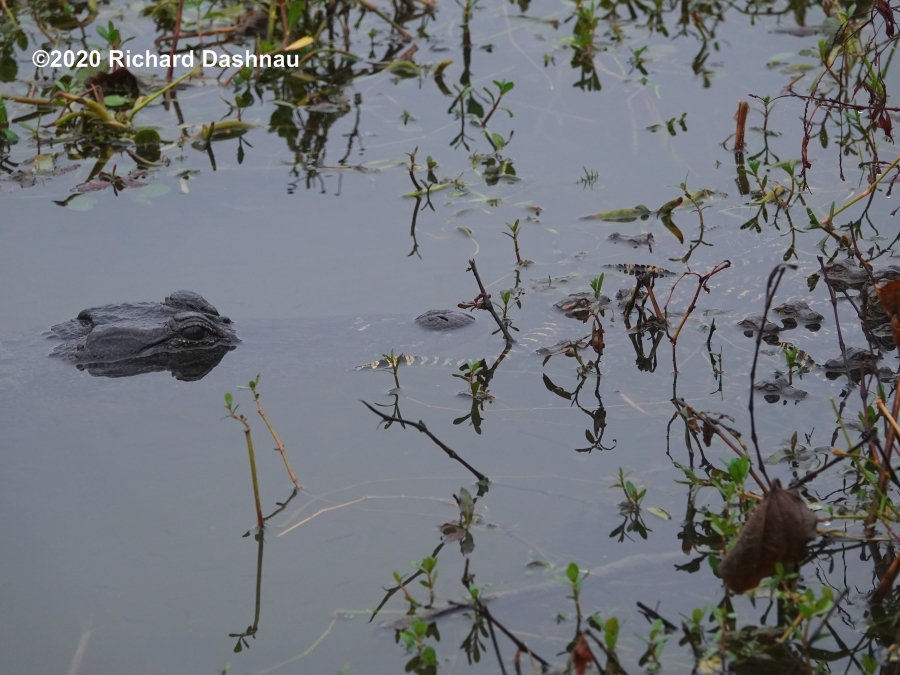
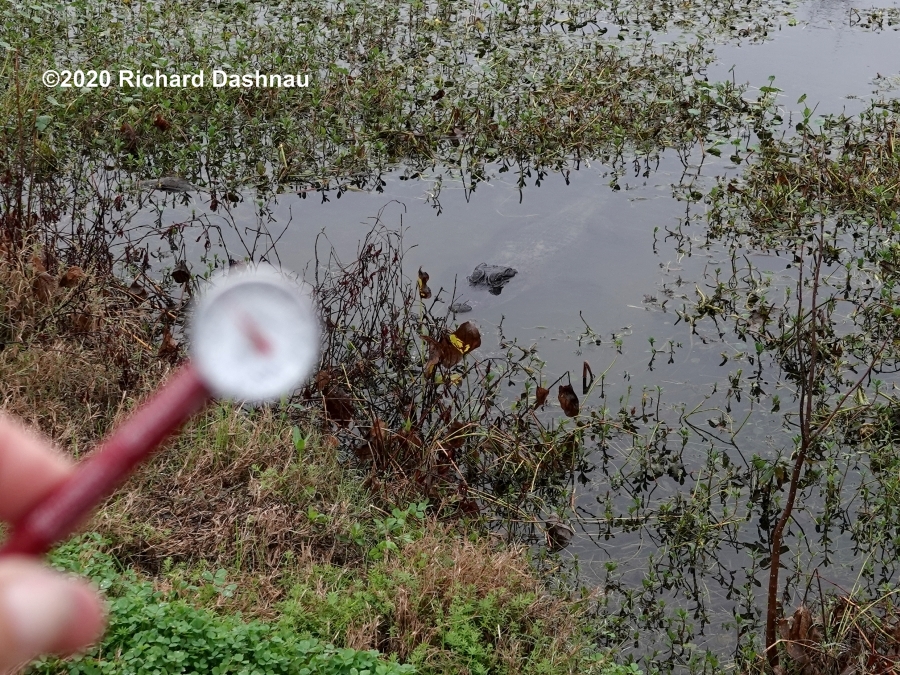
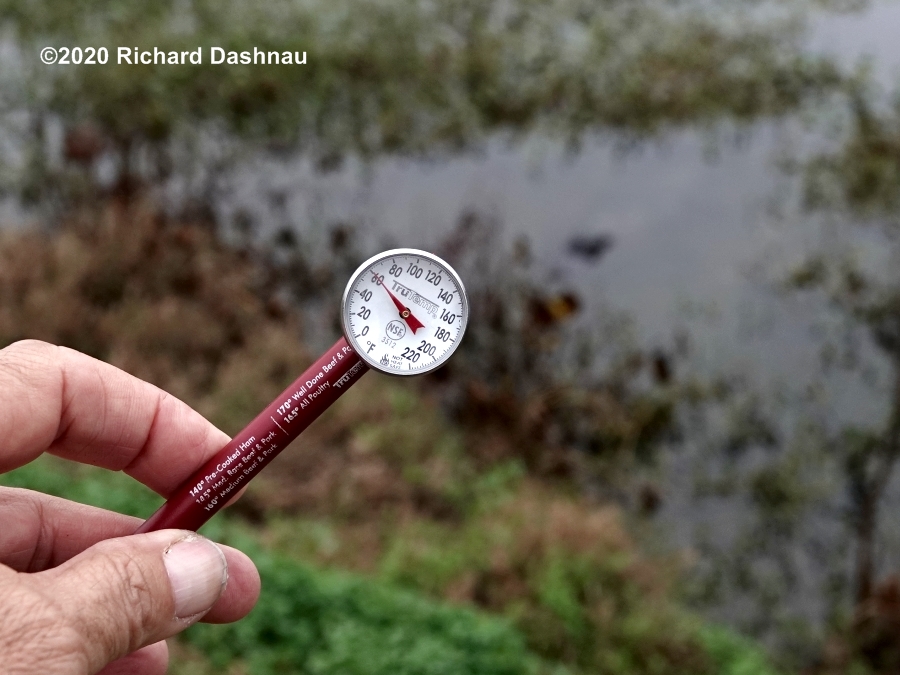
While
I didn't see an otter, I did get this picture of a nutria, before it
moved into the grass behind it. It's sitting on a small mat
of
vegetation that it had cut down.
When I returned later in the
day, the mother alligator had come out of the water to bask. I used about 15 minutes to
shoot some pictures, and this time, a short video clip.
Then I moved off, once again looking for otters.
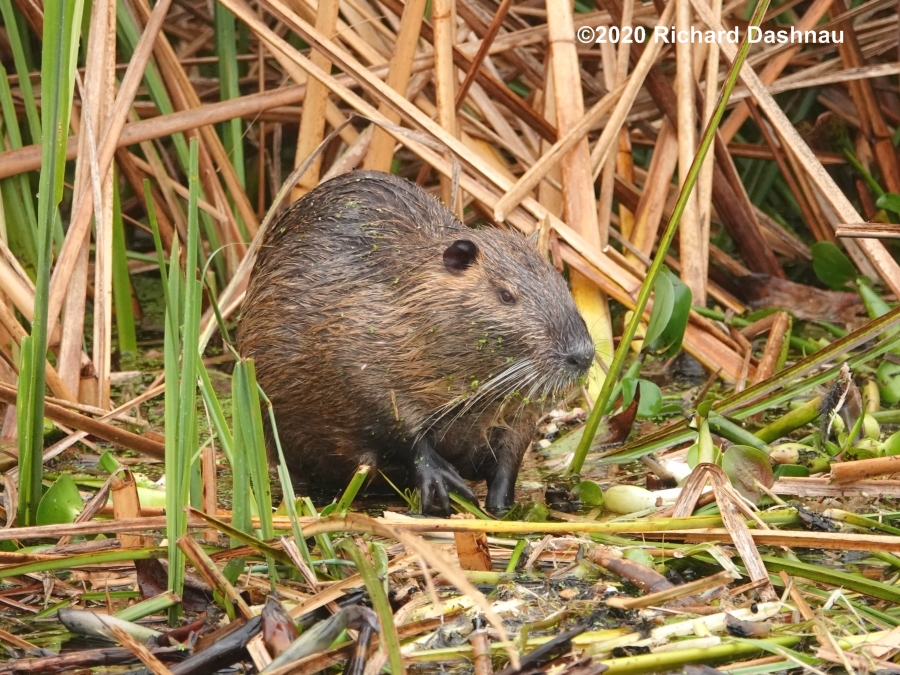
02/02/2020
More time with the alligator mother and her pod. I
was with her
for most of the day. At about 8:40, I measured 58 degrees F. (01,02).
The mother remained
submerged for most of the morning. The babies
didn't move around, either. (03,04)
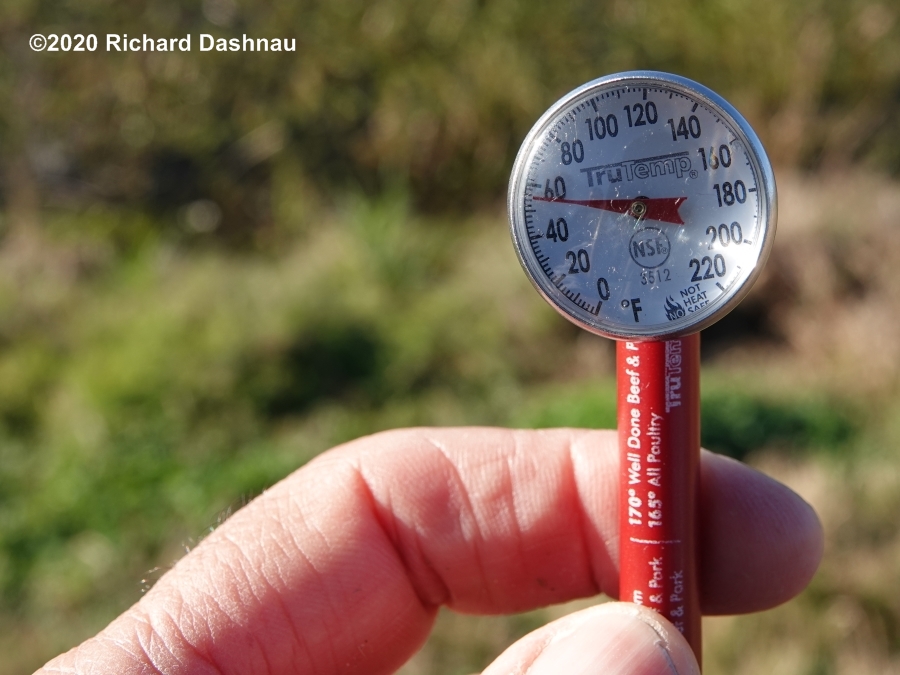
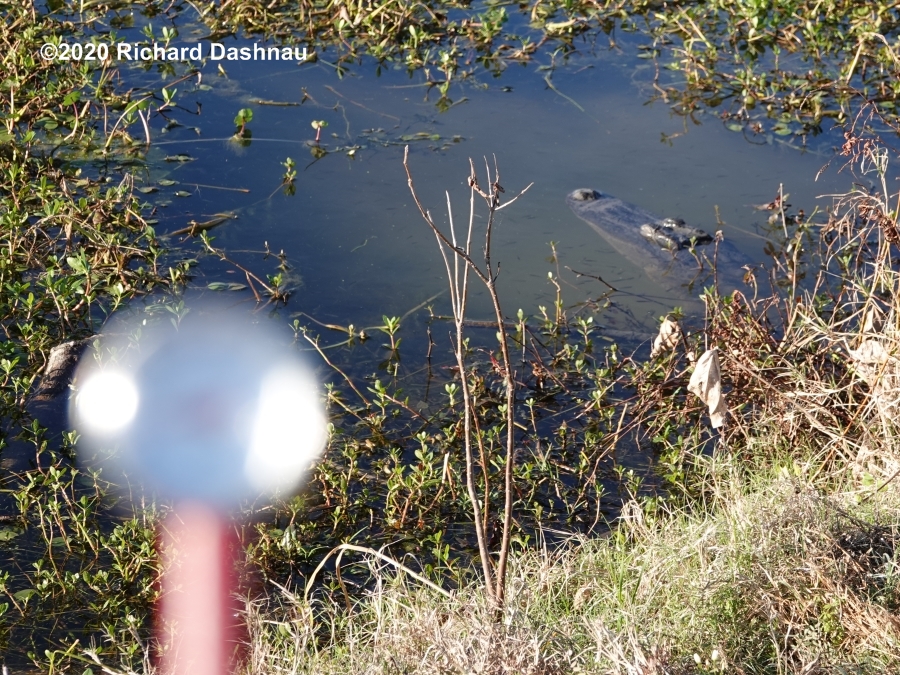
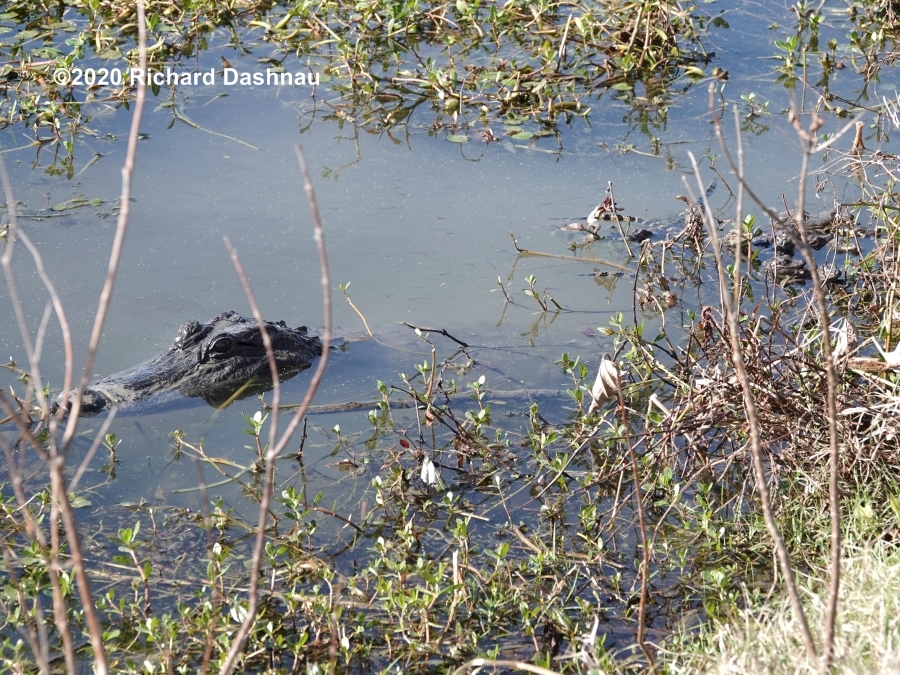
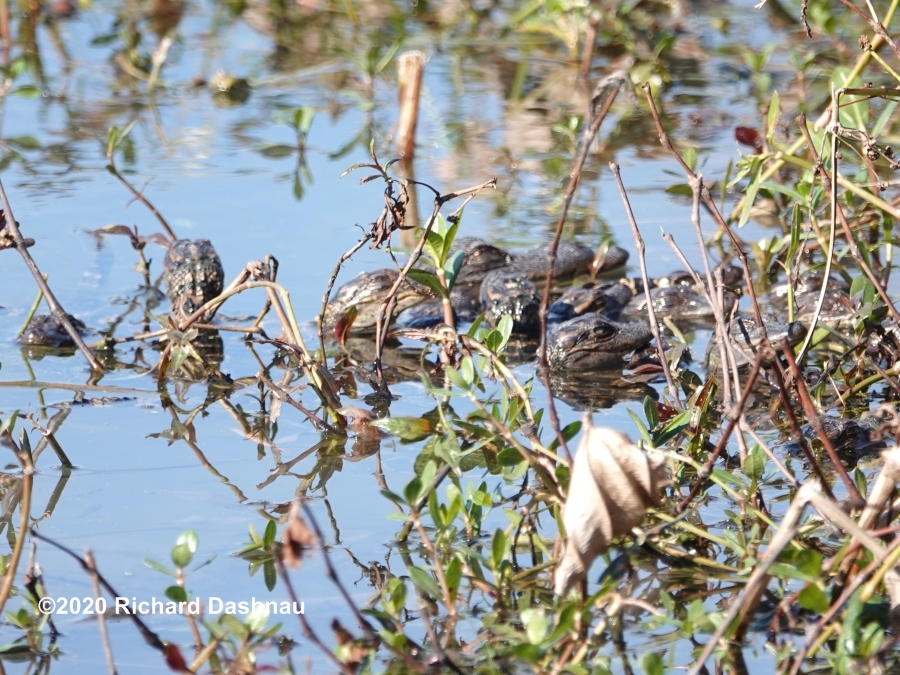
01
02
03
04
Mom
gator submerged at 10:30, then surfaced to breath at 10:50...about 20
minutes under water. Although mom moved around a little, the pod didn't
move much at all.
(5,6,7,8,9,11)
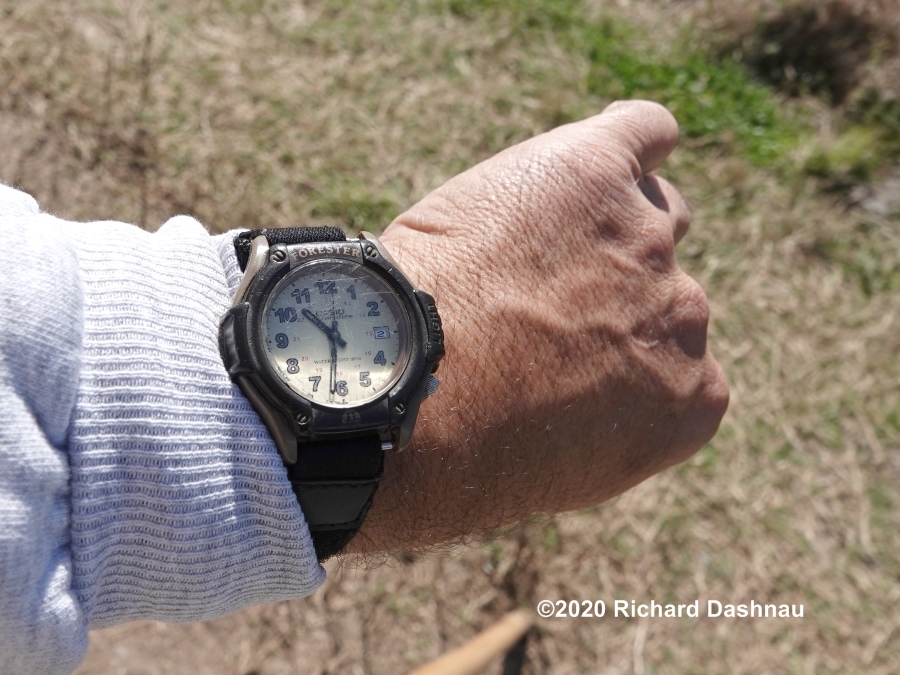
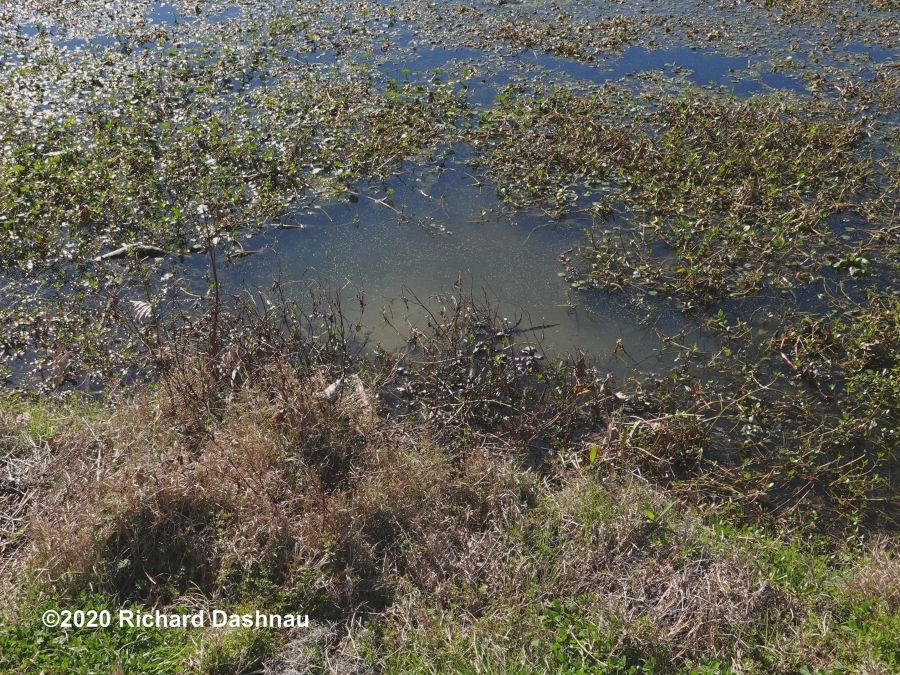
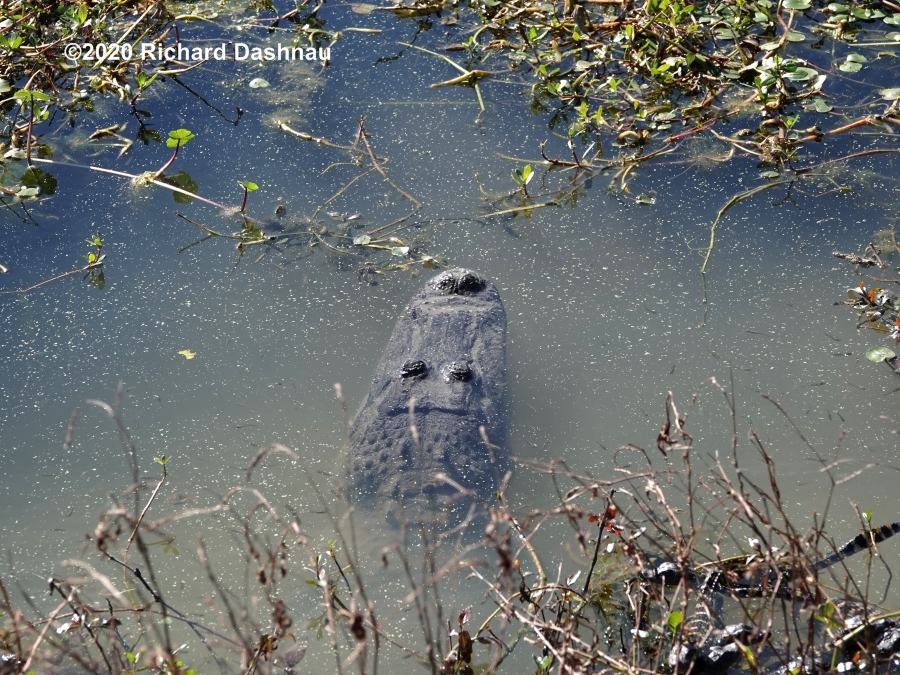
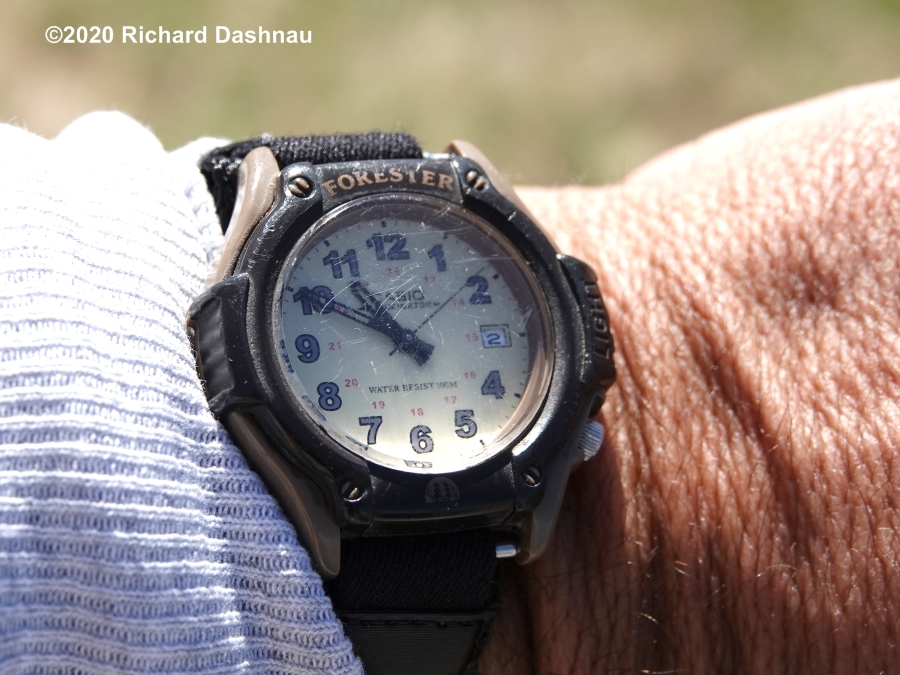
05
06
07
08
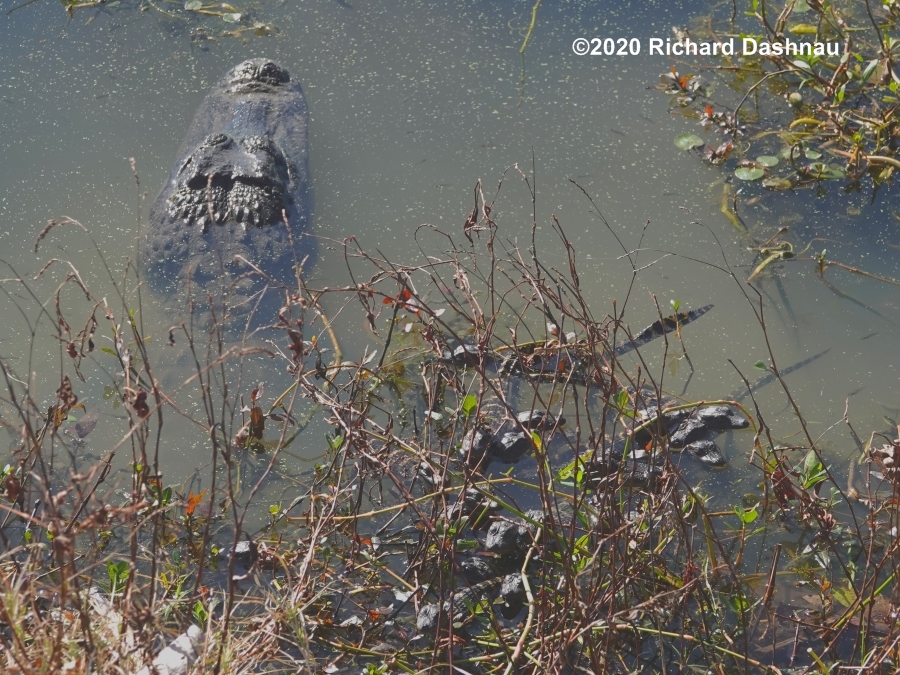
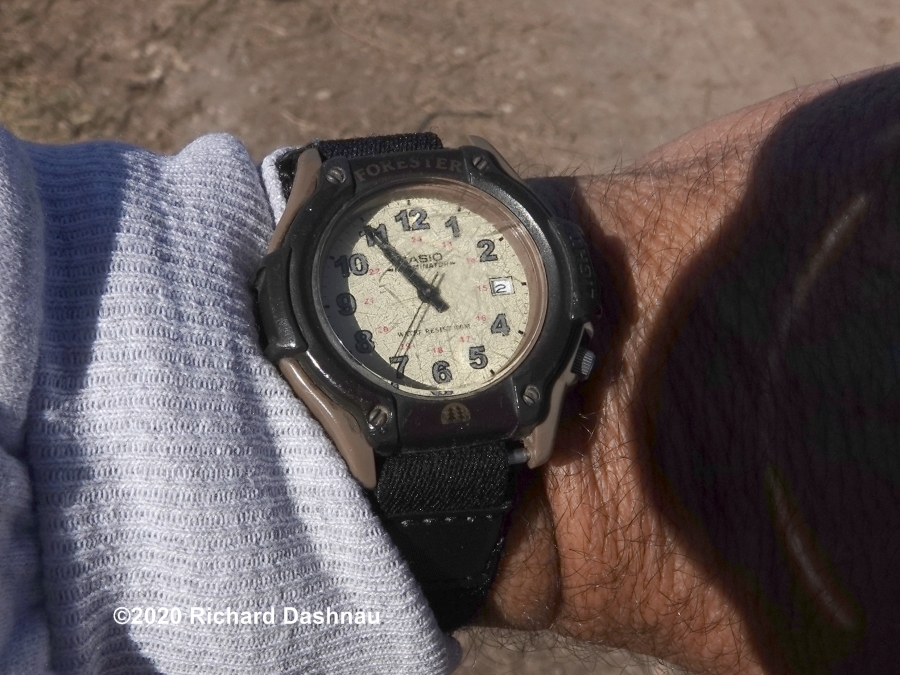
09
11
She
submerged again at 11:35 , surface at 11:48 (12,13,14,15)
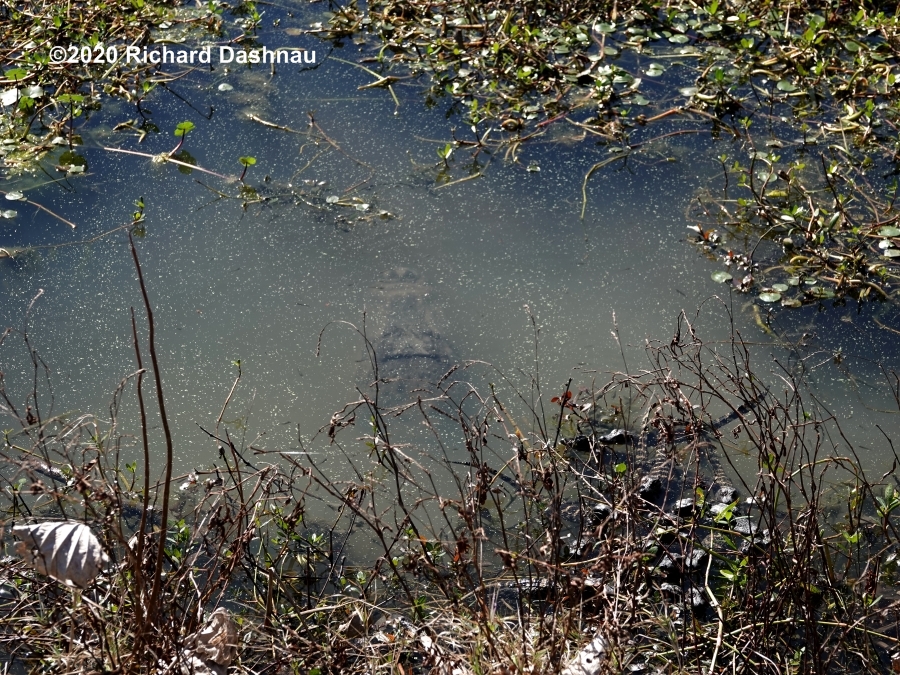
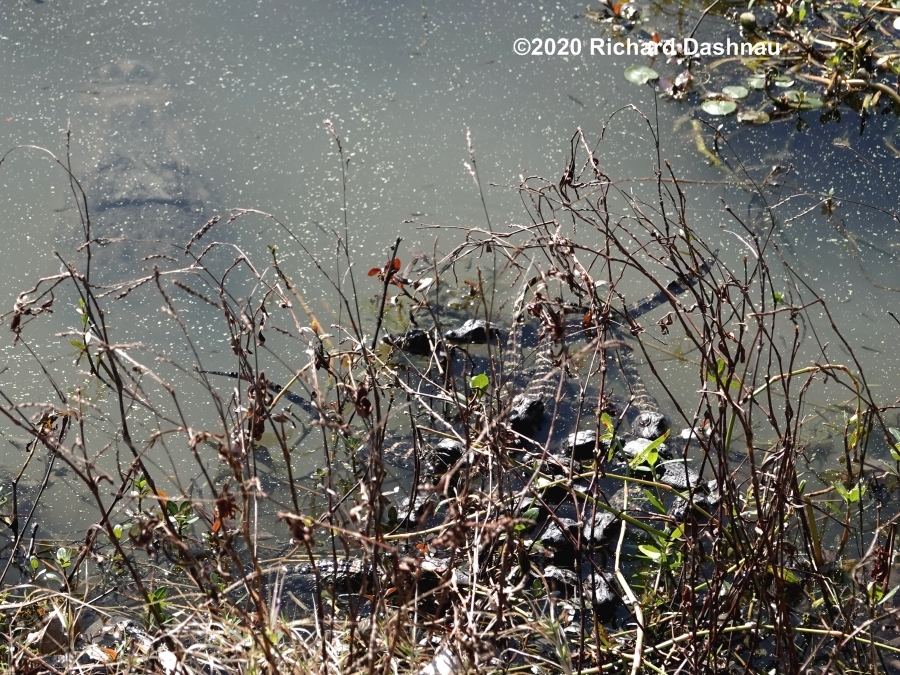
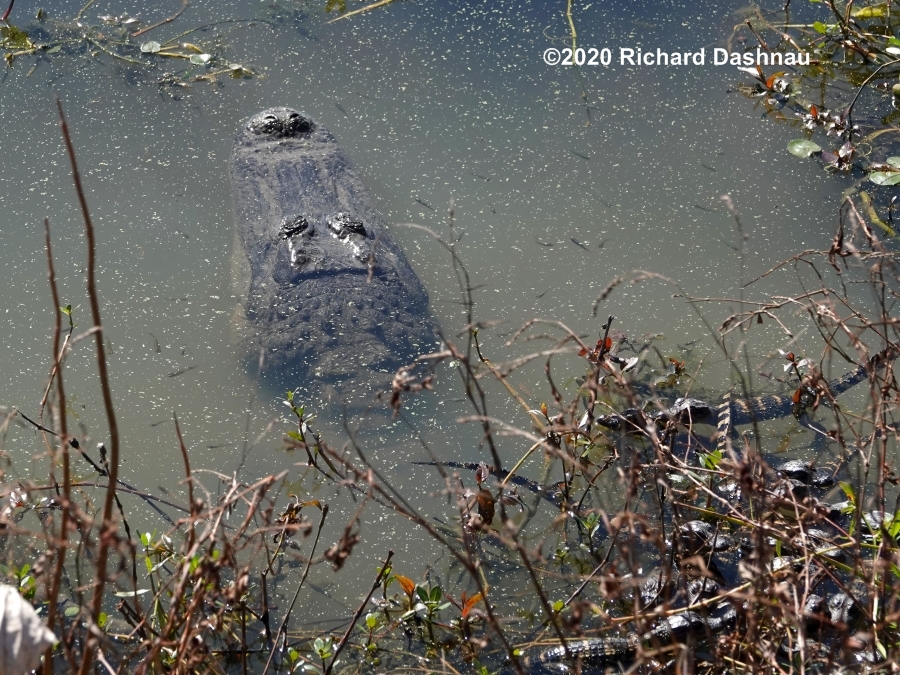
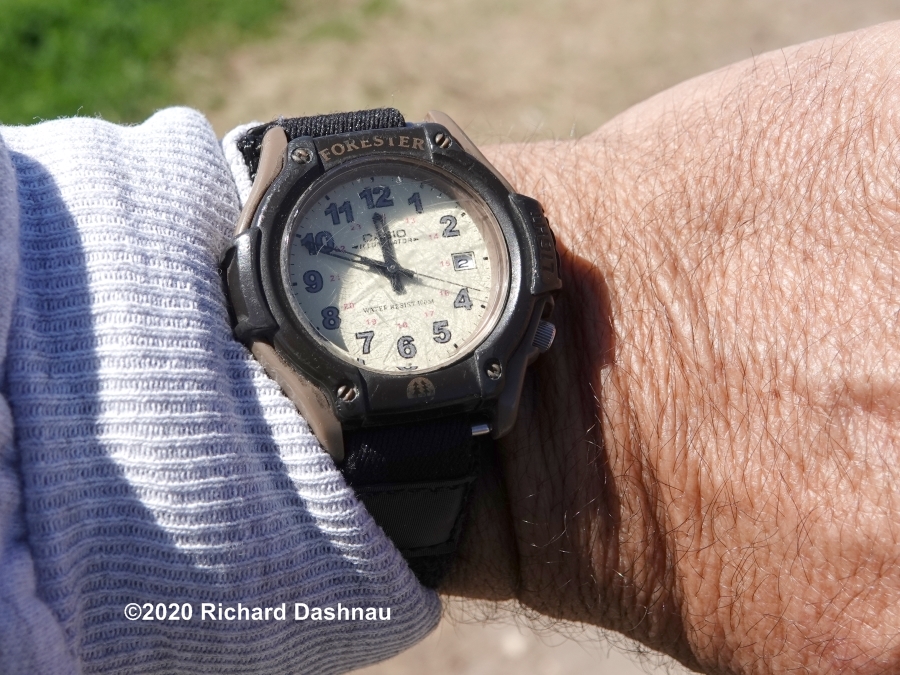
12
13
14
15
Submerged
at 11:50 surface 11:56 (16,17,18,19,20,21)
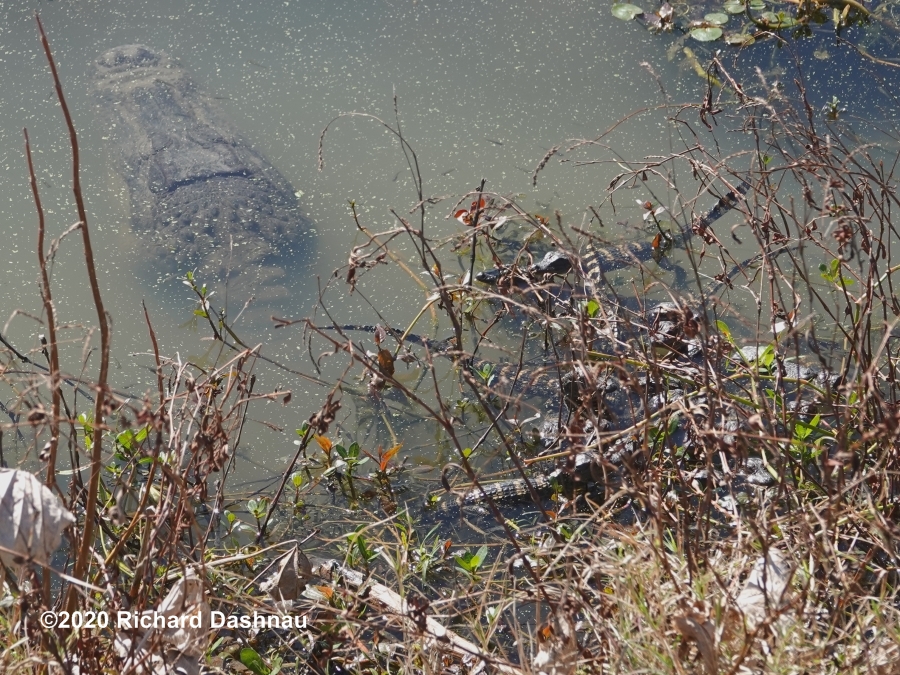
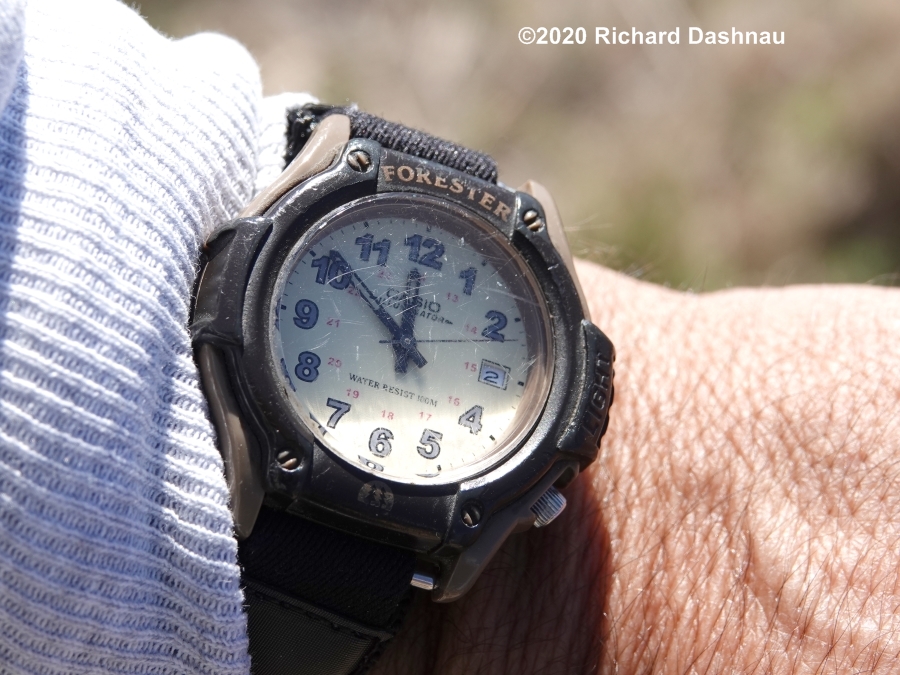
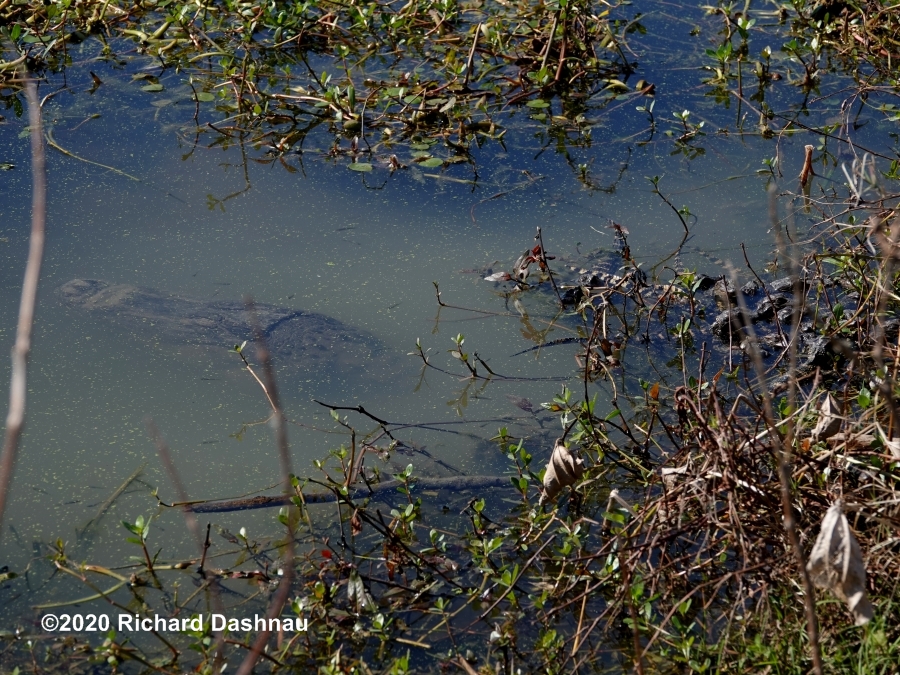
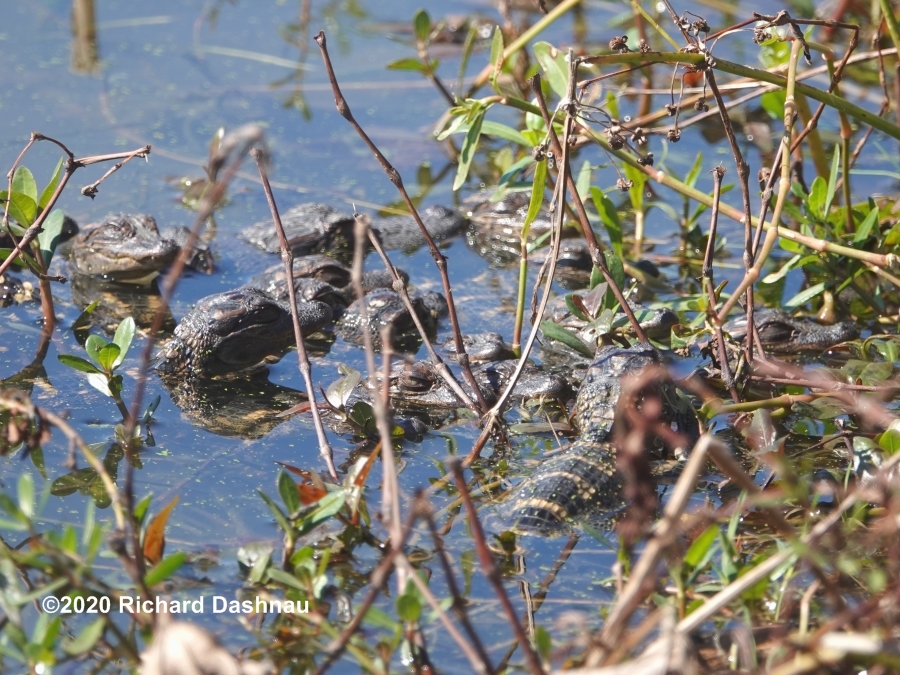
16
17
18
19
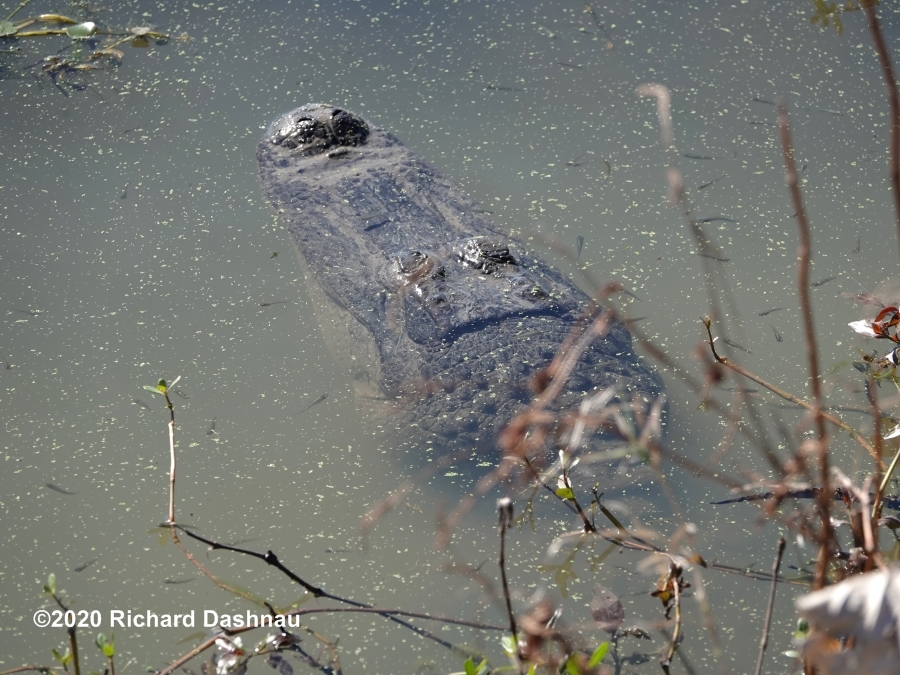
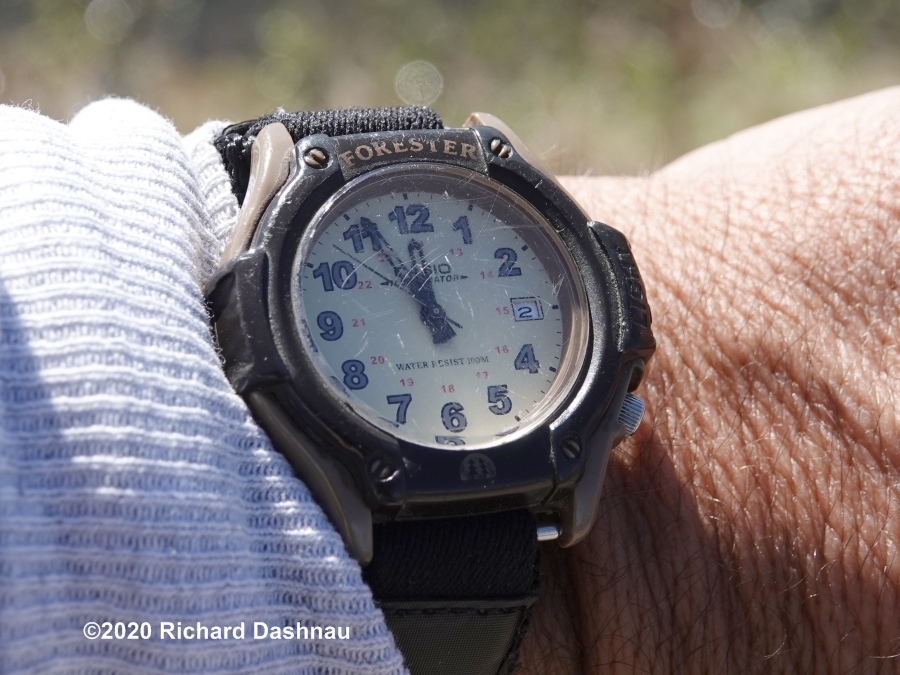
20
21
At
12:06, Mother submerged and backed into her burrow until she was
hidden. She remained hidden until surfacing at 1:05---about 1 full hour
under water!
(22,23,24,25,26,27)
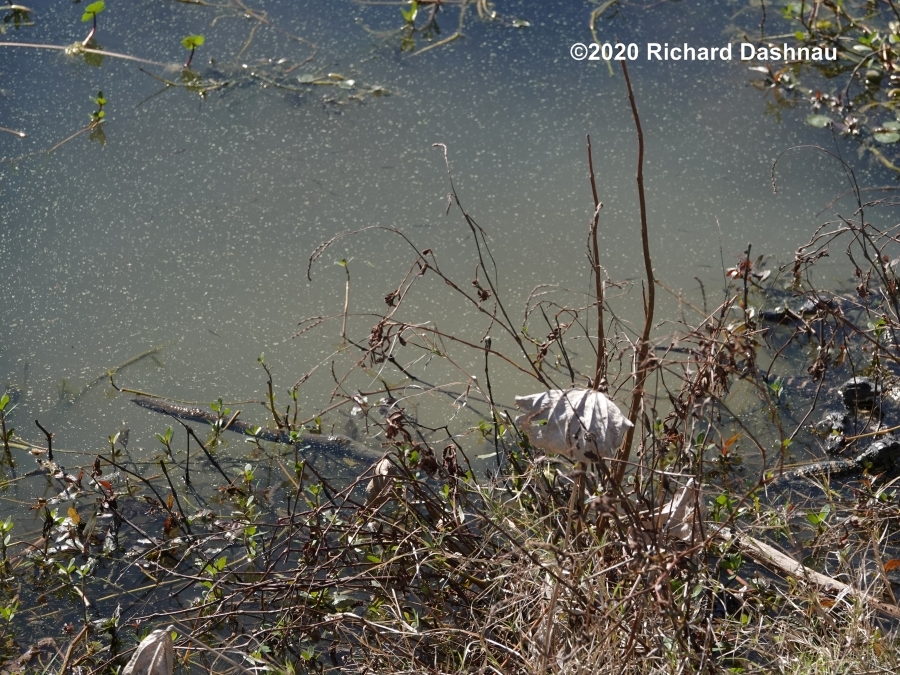
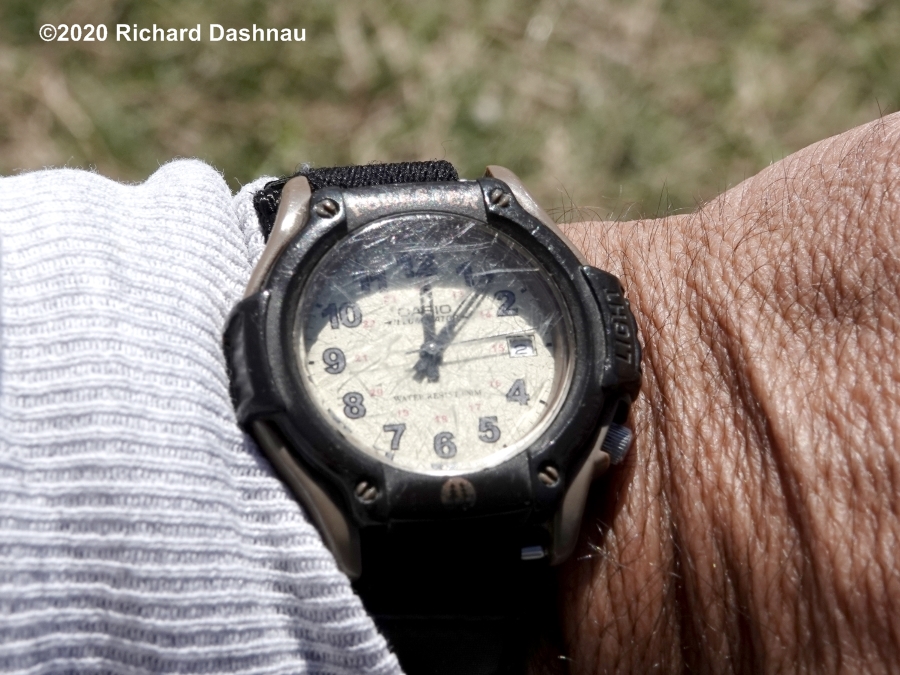
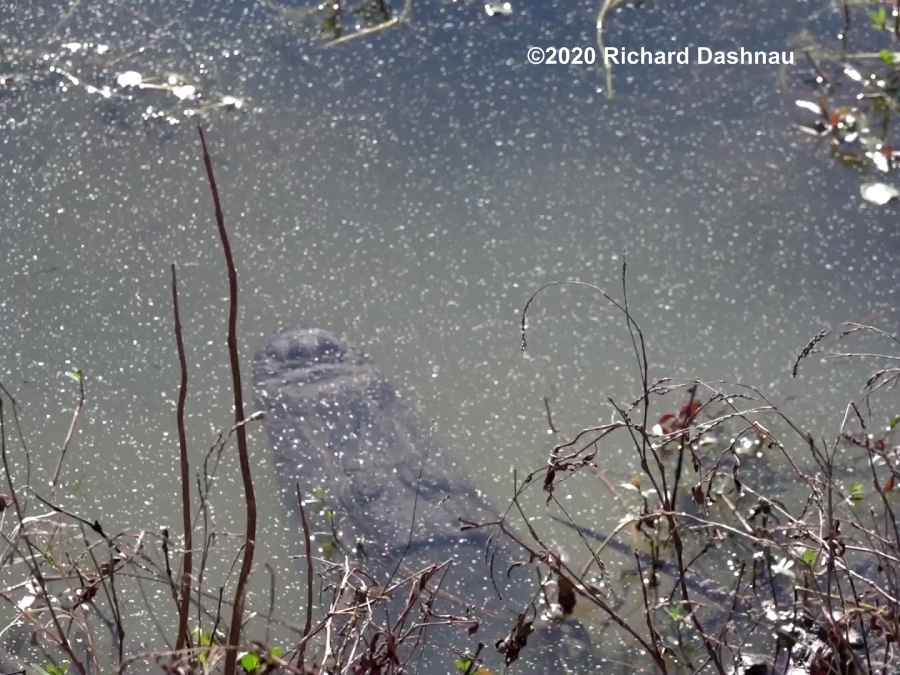
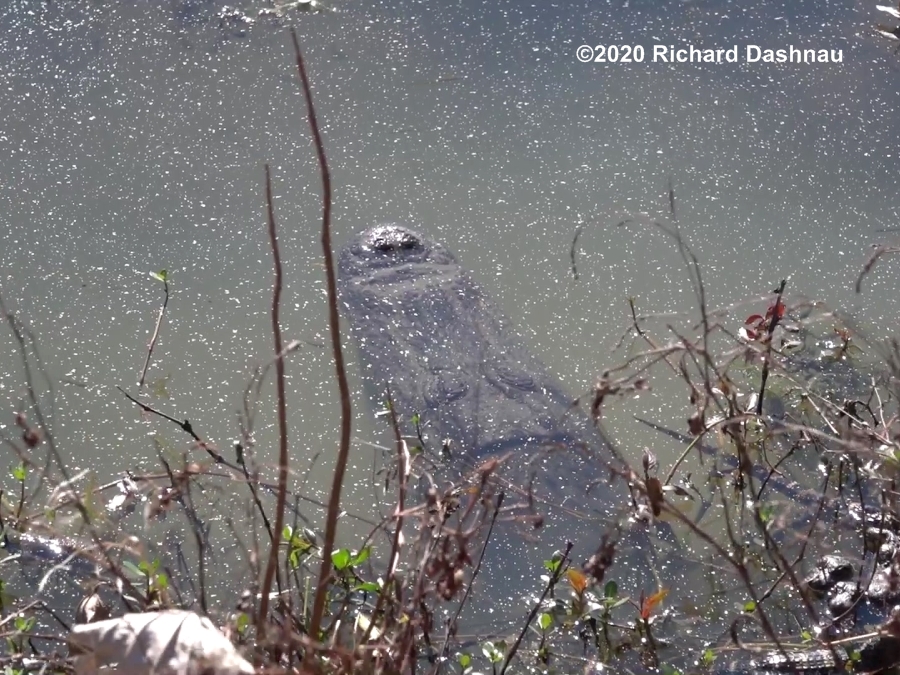
22
23
24
25
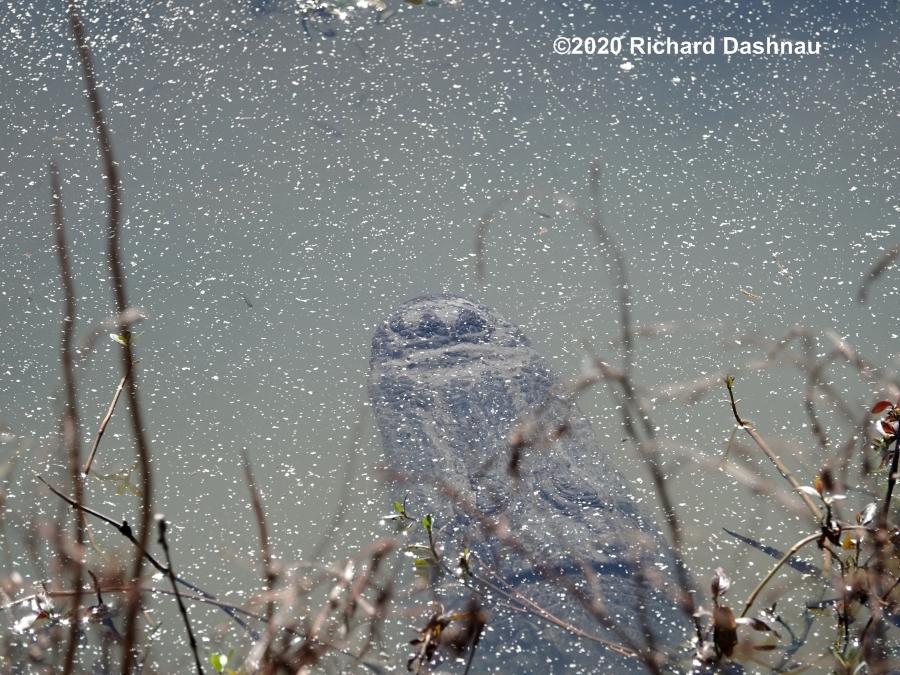
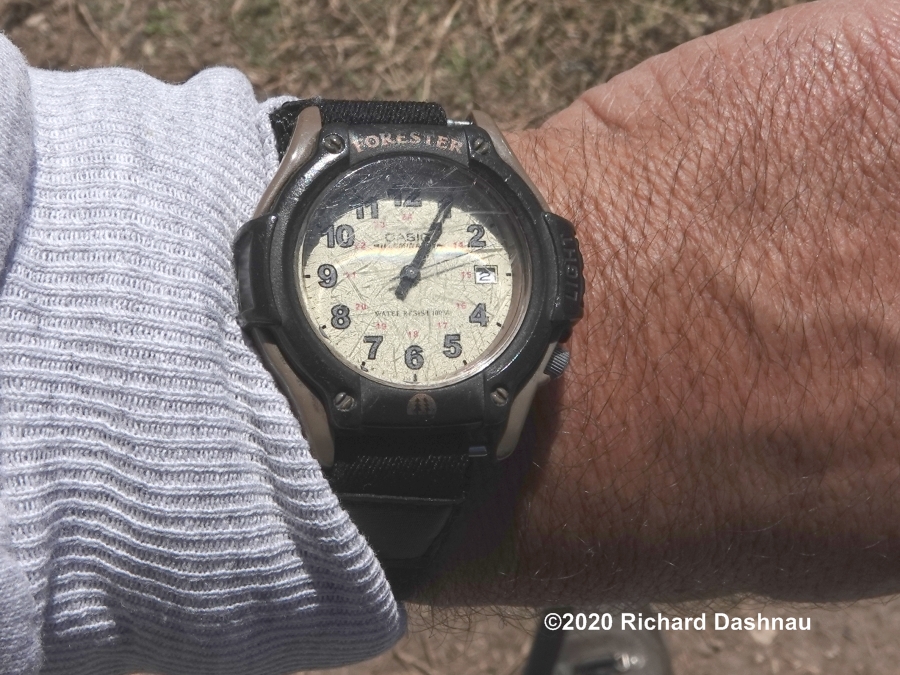
26
27
Mom
extended herself from the burrow about 20 minutes later. She surfaced
enough to expose her head and neck, and the babies started moving
around. One
climbed onto her head at about 1:30. Mother
shifted her position by submerging and turning side to side, but she
didn't move too much. (28,29,30) Mother finally
left the
burrow
at about 2pm. Then she slowly turned until she was facing
the babies and the bank (and us). In the meantime, the some
of
the babies had move
away from the group, and seemed to be hunting.
(31,32) I left a little after that.
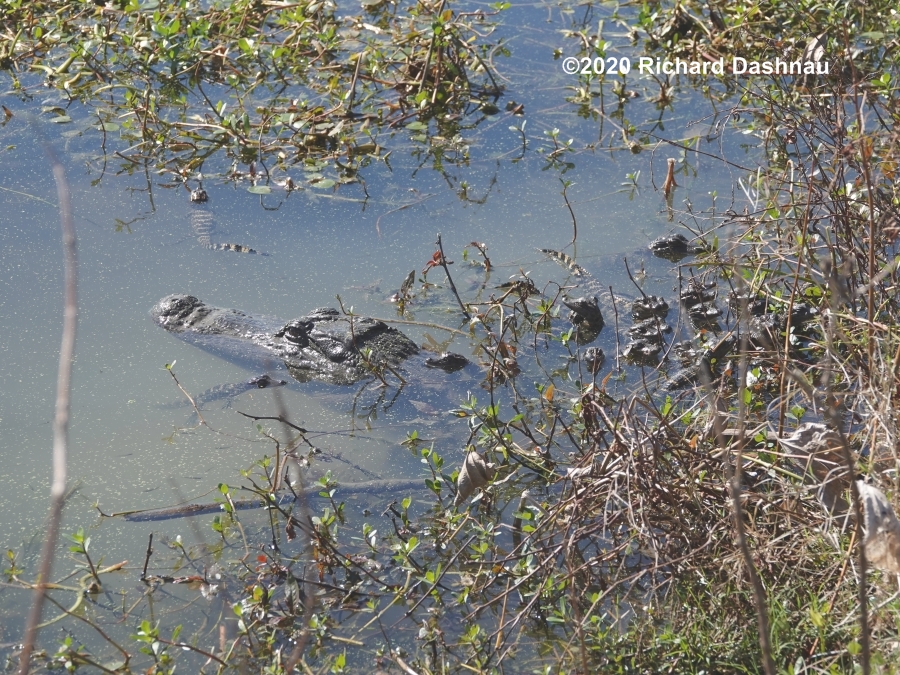
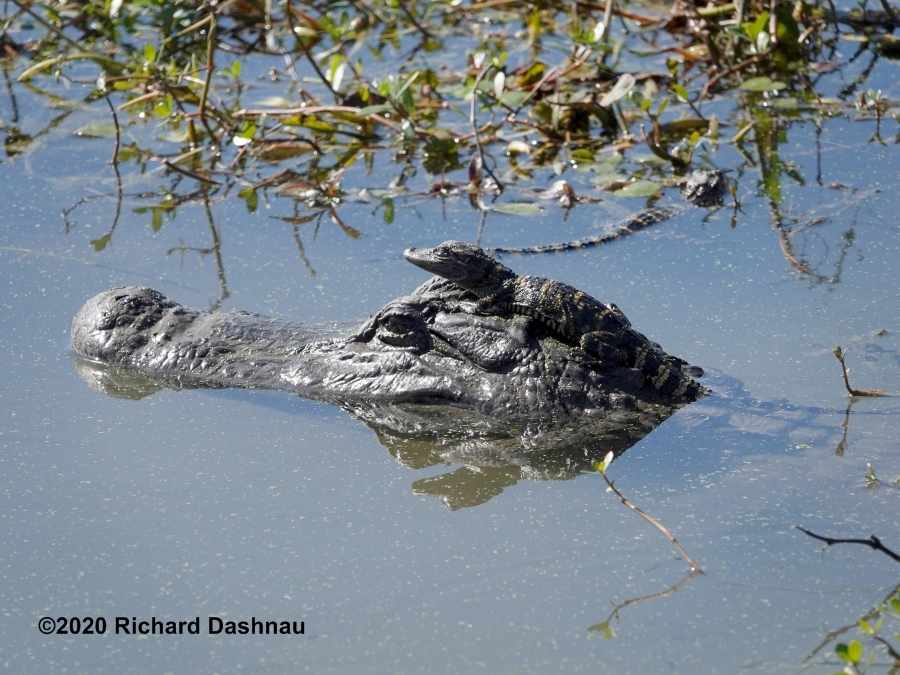
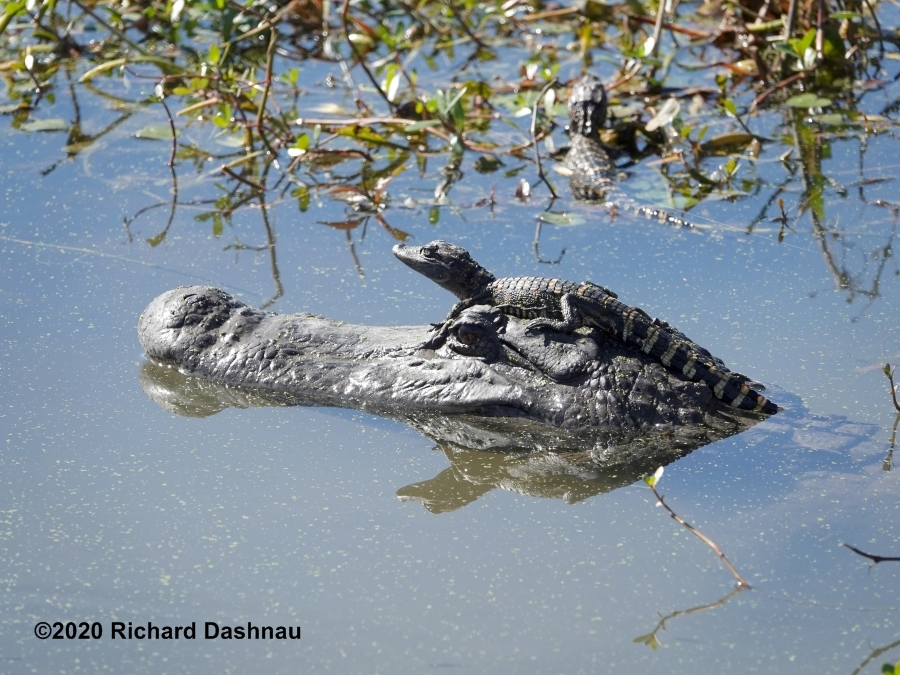
28
29
30
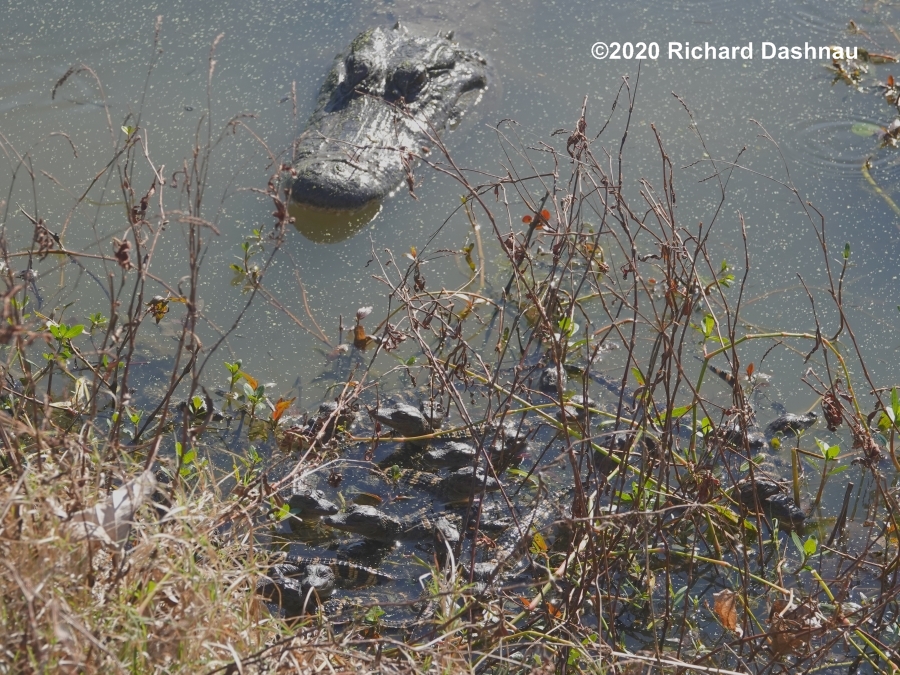
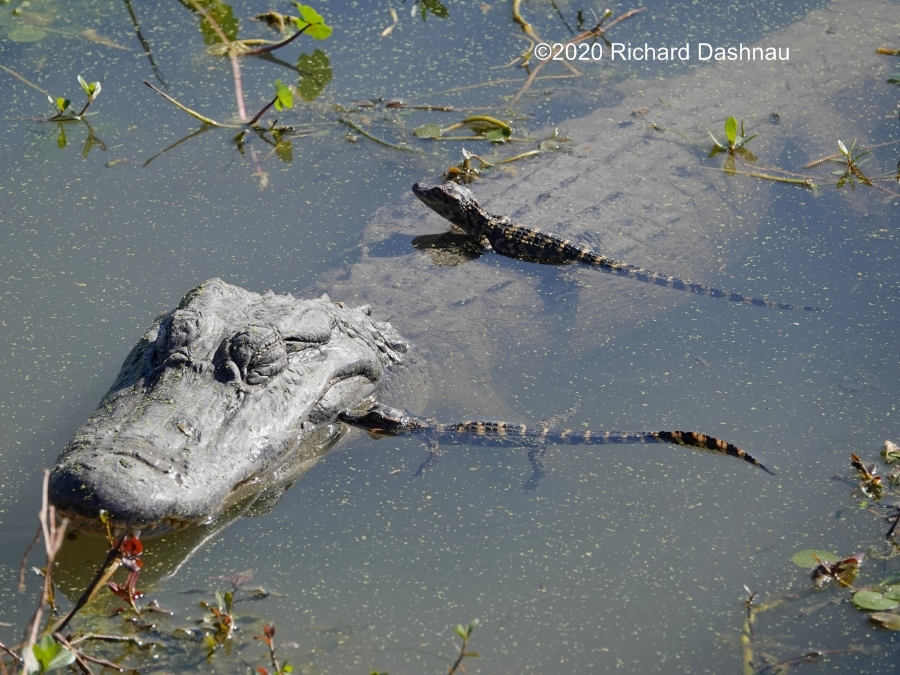
31
32
02/16/2020
More time with the alligator mother and her pod. I
was with her
for most of the day. And, I was surprised by her behavior again. Along with the
pictures
shown
here, I shot some video clips. I've put together a 5 minute
video
from those clips and some of these images. The video can be
seen here.
It was about 60 F
near the mother gator at 9 am (5970). She was underwater, but not in
her den. I could see the babies.
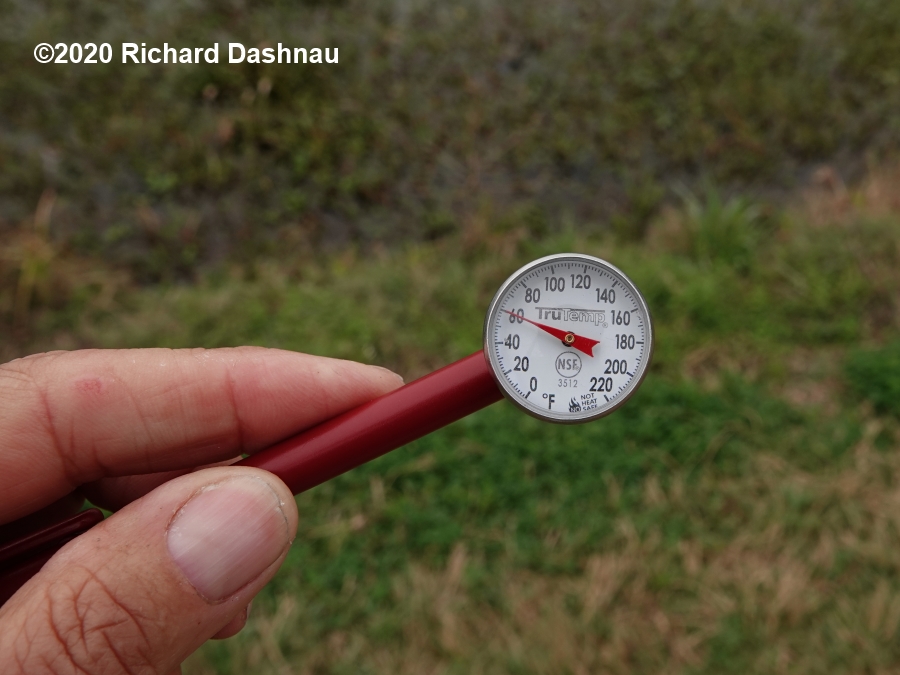
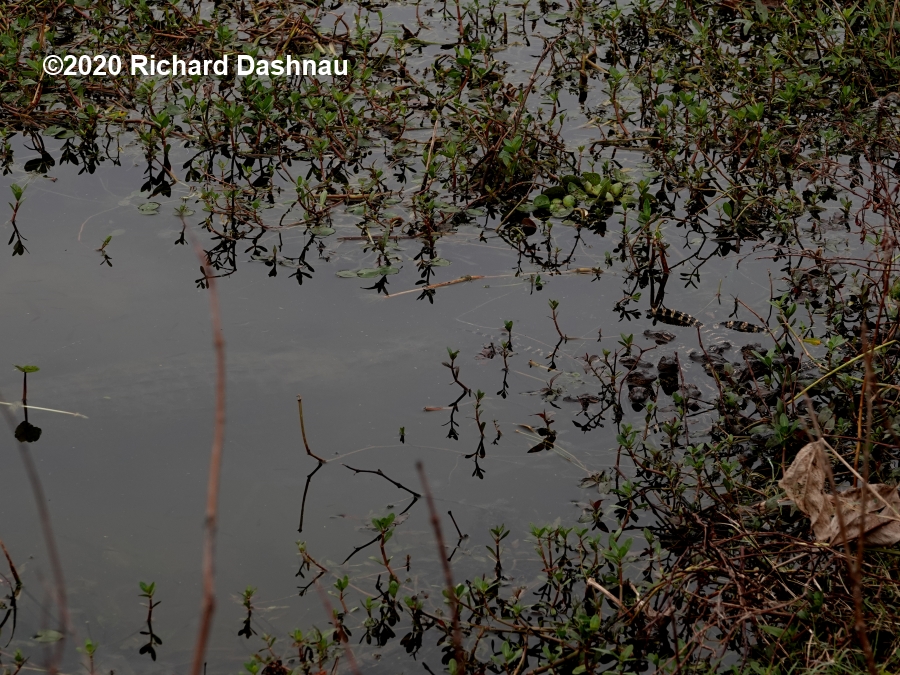
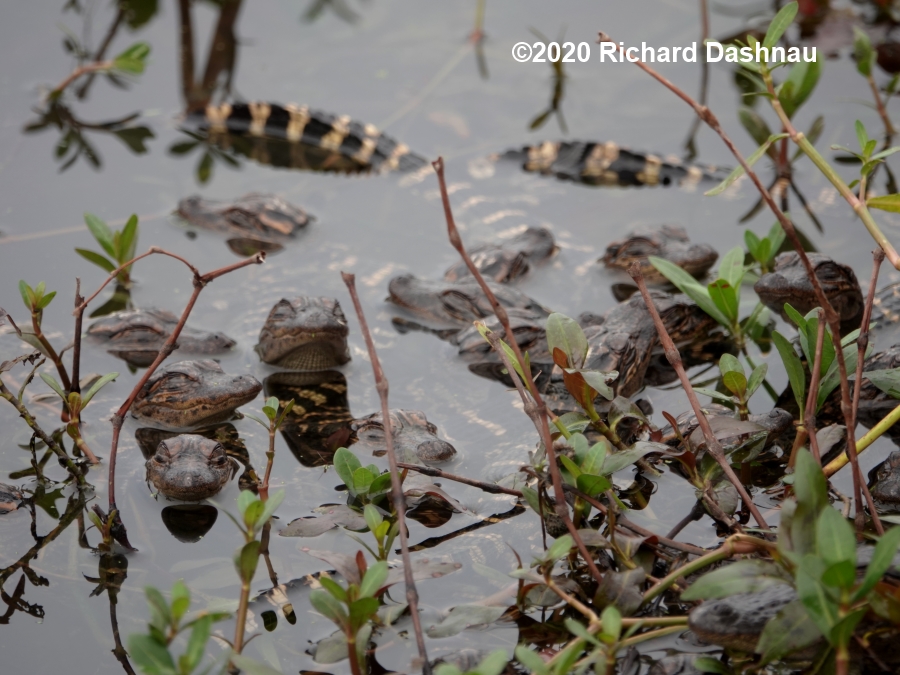
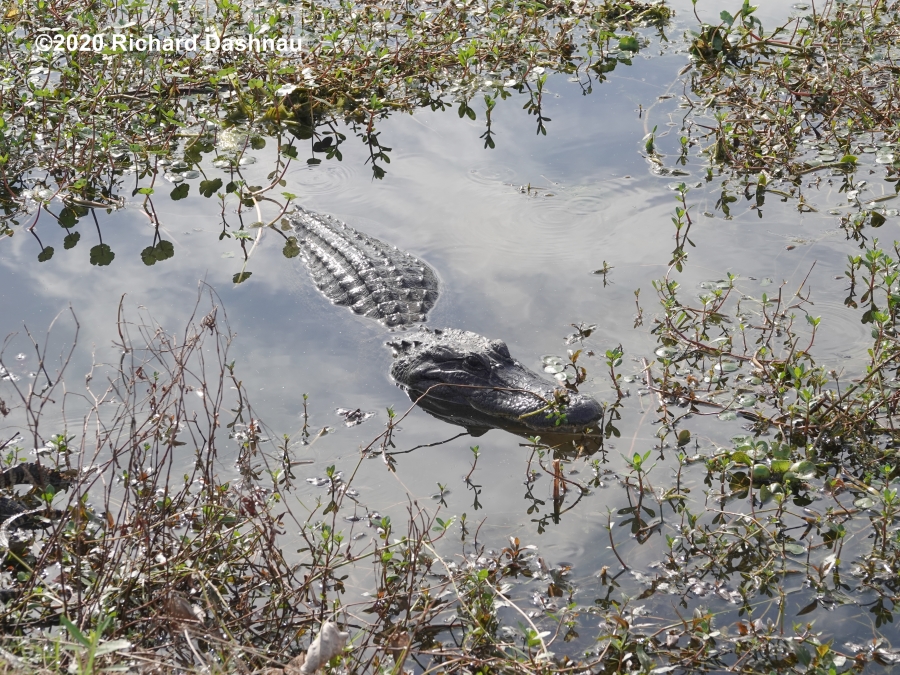
01
02
03
04
About
10am, the mom became attentive, and turned towards the island. I
wondered why, until I heard bellowing from that direction!
The mother
lifted her snout out
of the water, and I thought she might bellow;
but she never did the full head tilt with tail lift--the "Head Oblique
Tail Arched" posture (HOTA). Instead, at 10:12, mom
left her babies
and swam to the island. The island is about 60 yards
away.
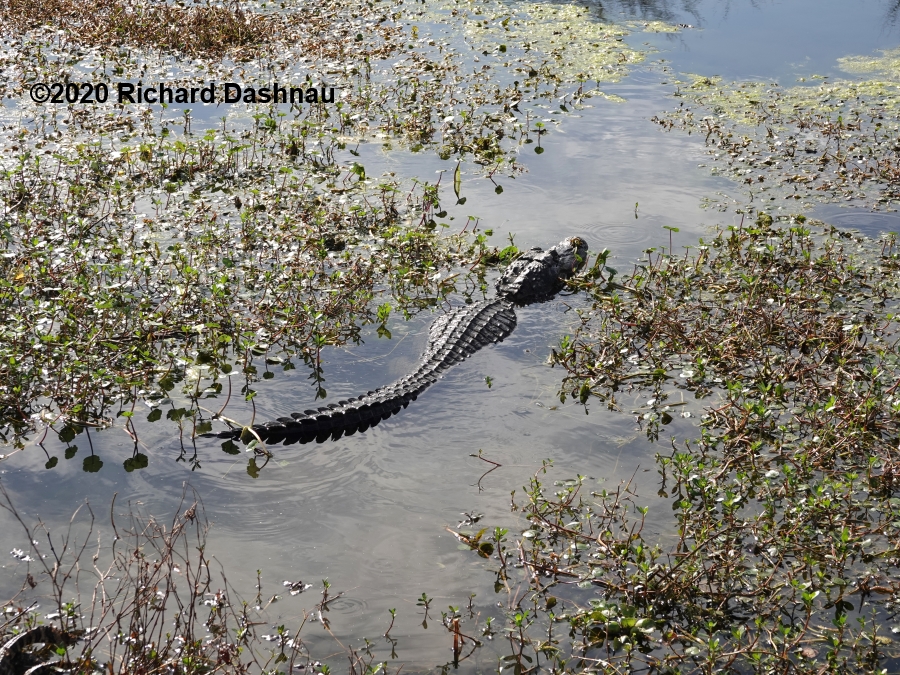
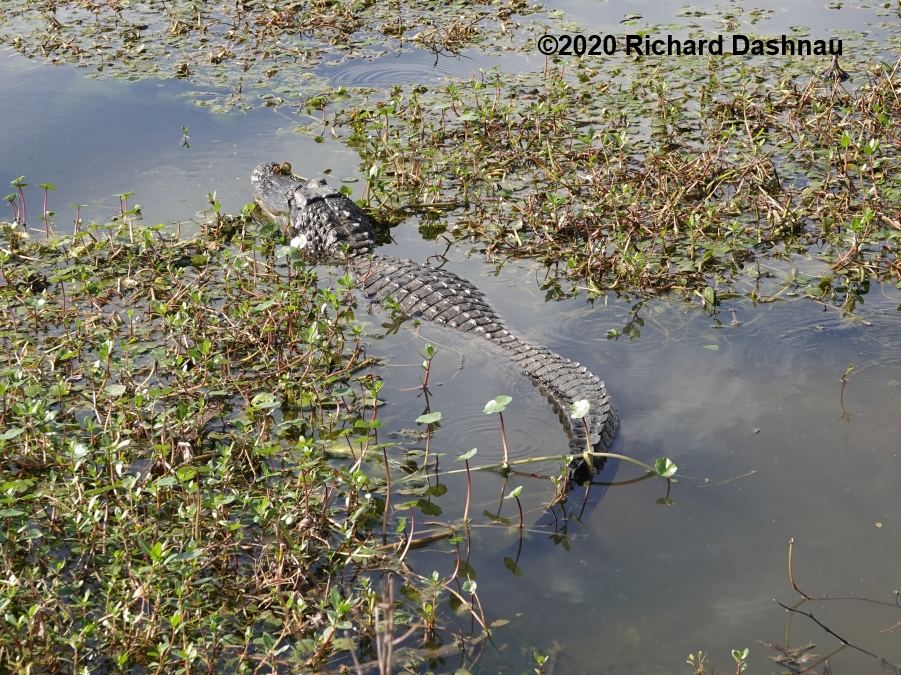
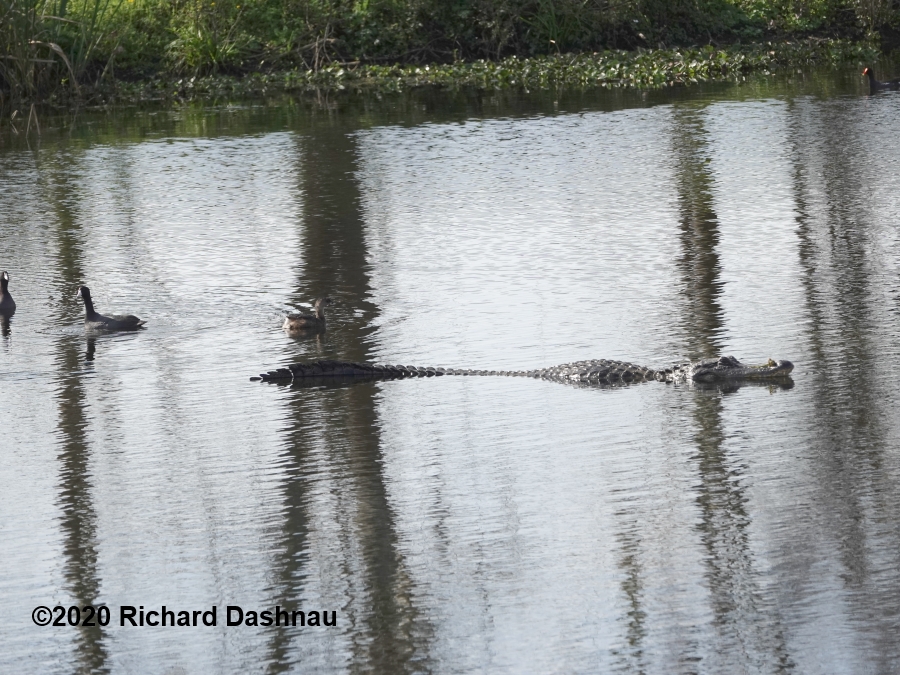
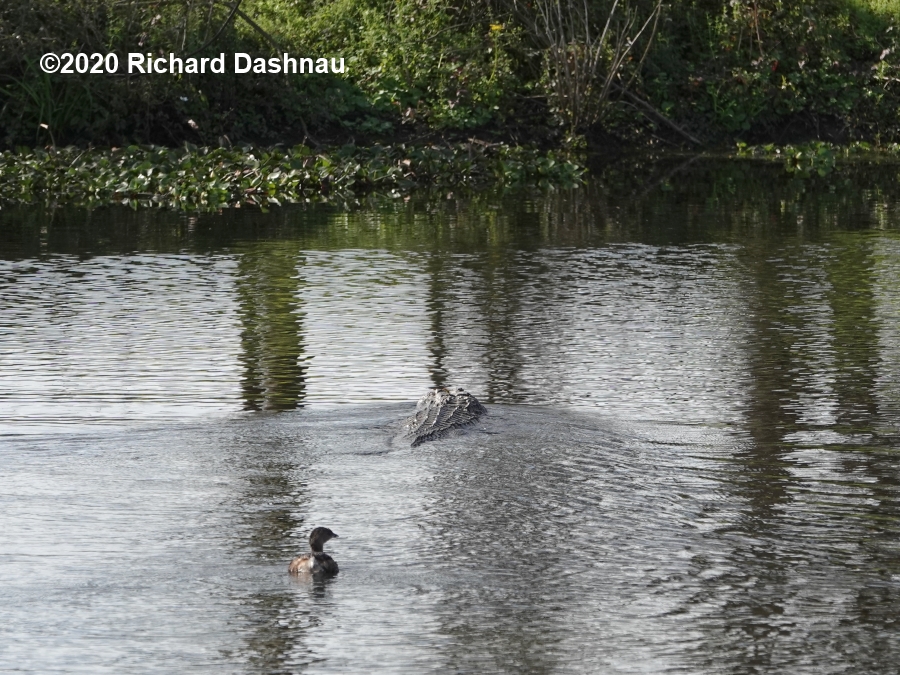
05
06
07
08
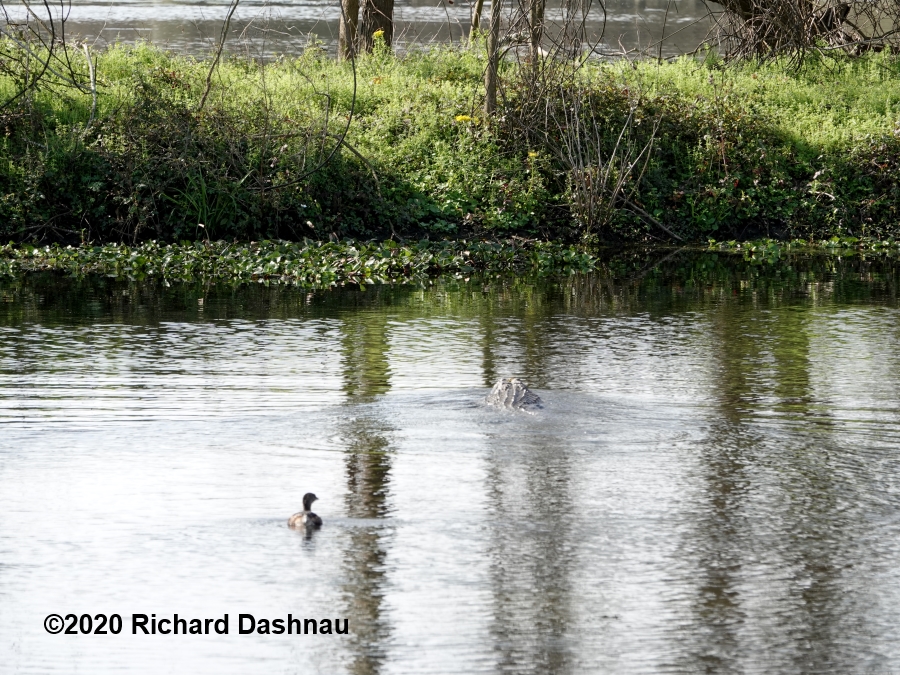
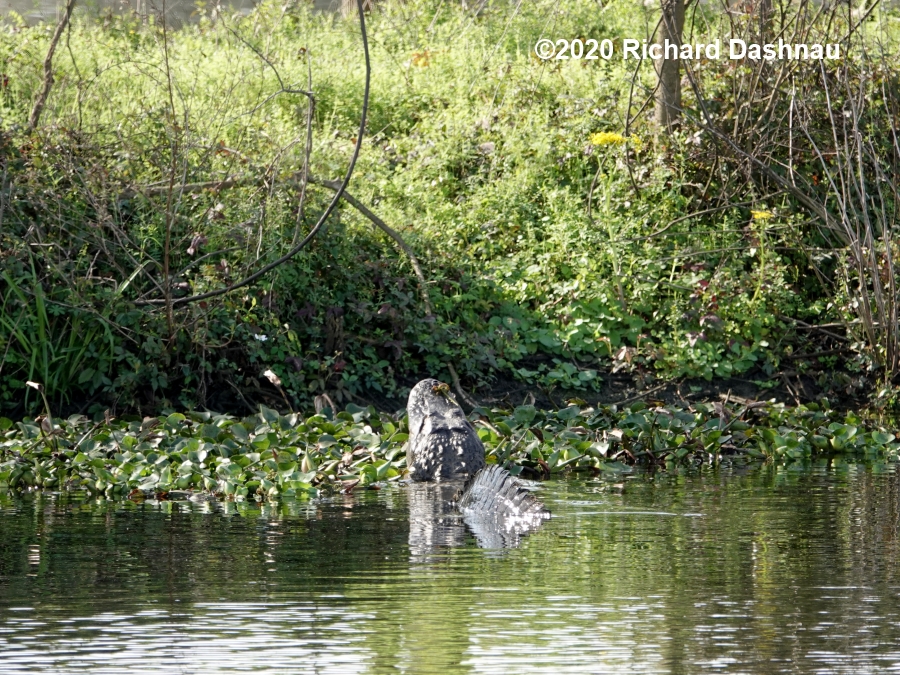
09
10
When
she got there, mom presented the HOTA posture--and bellowed!
At 10:16
mom *left the water* and climbed over the island to the other
side--leaving the pod
of babies out of her sight .
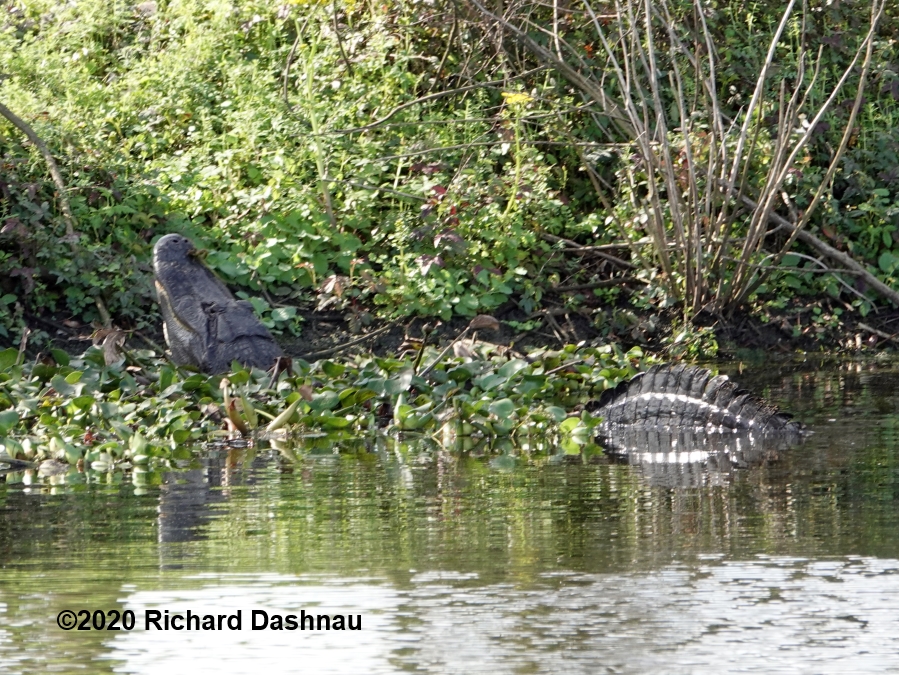
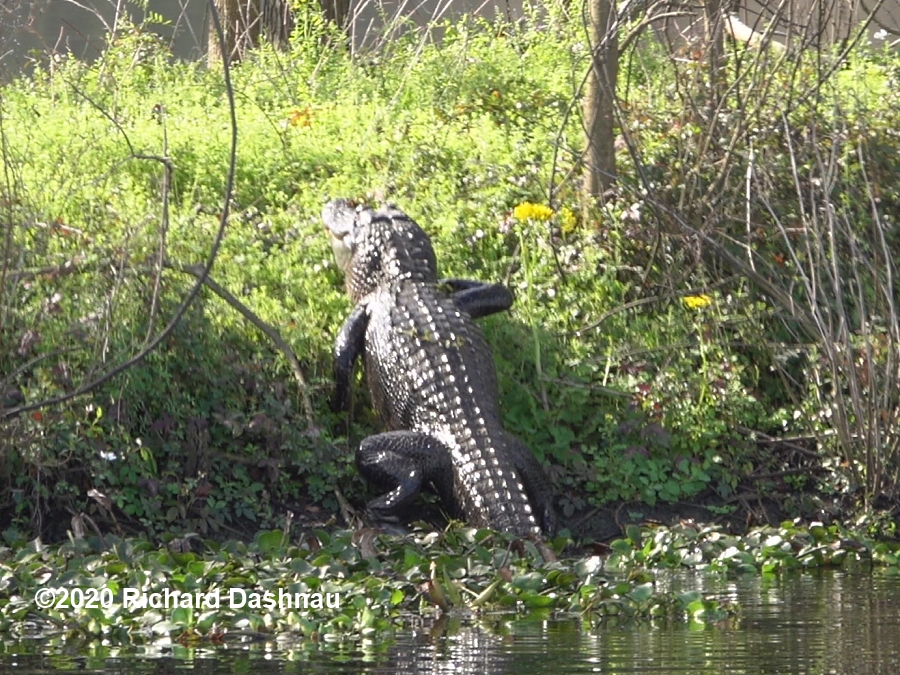
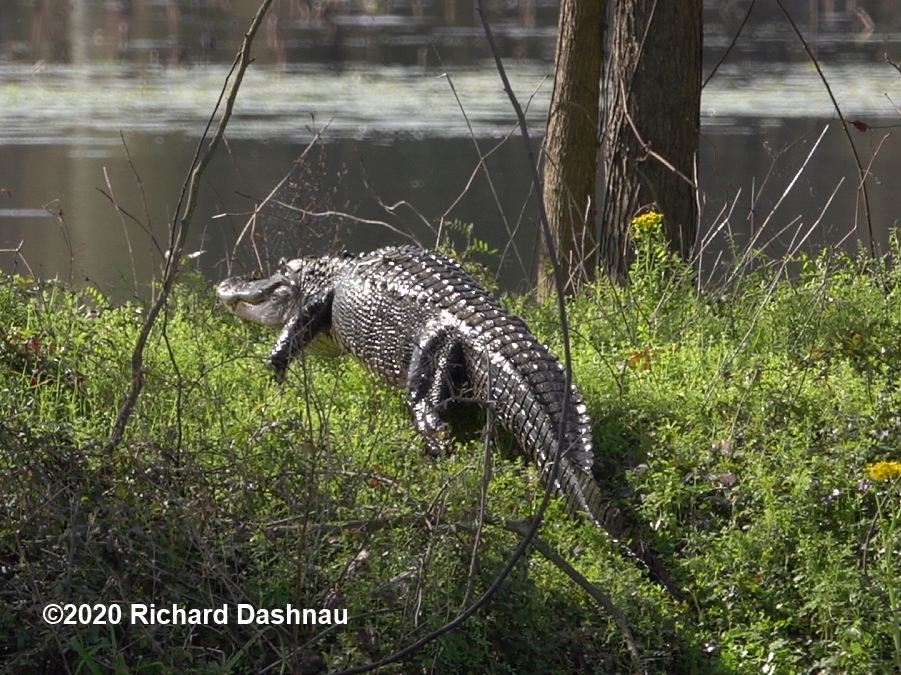
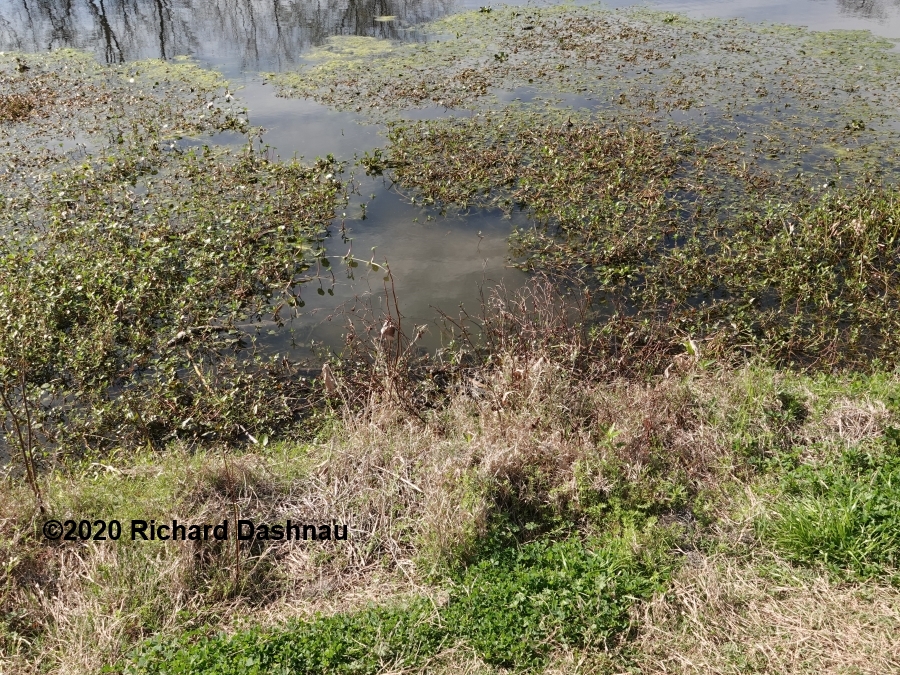
11
12
13
15
10:18
Mom was gone for a while At 10:52, I noticed mom's nose poking over the
top of the island.
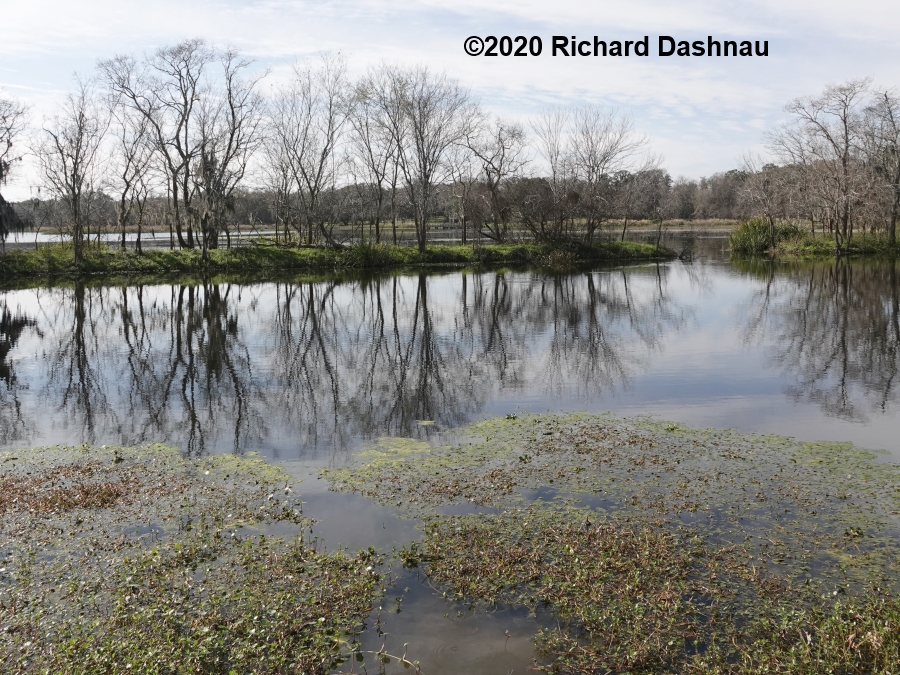
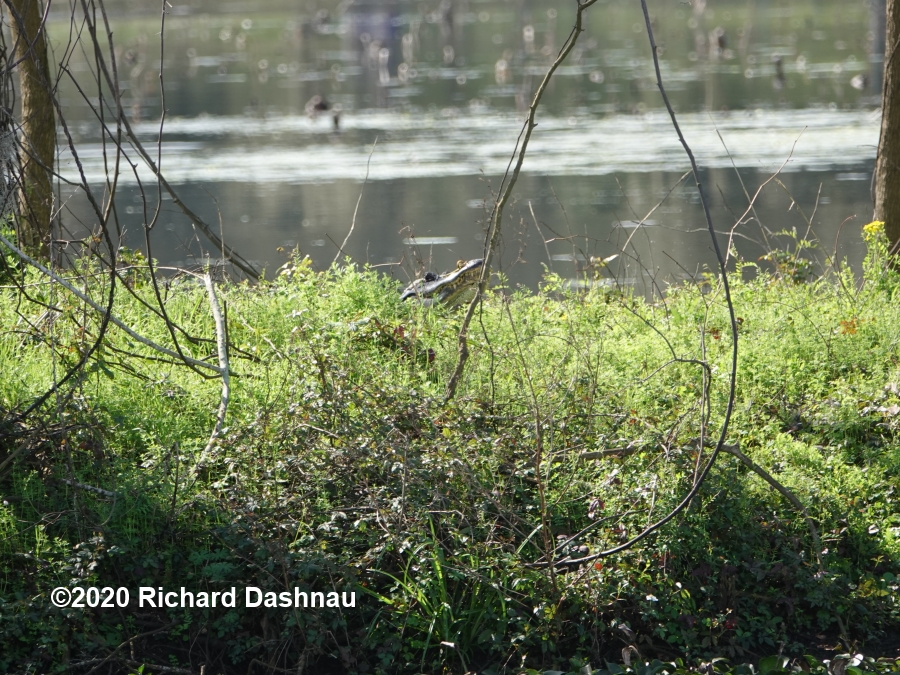
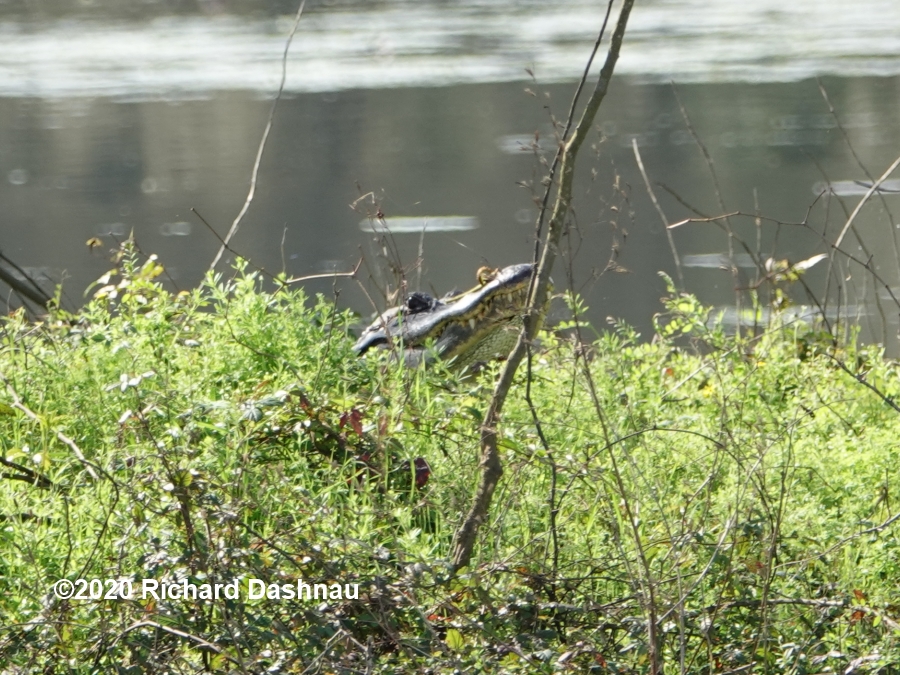
16
18
17
At 10:55, she
crossed back over the island
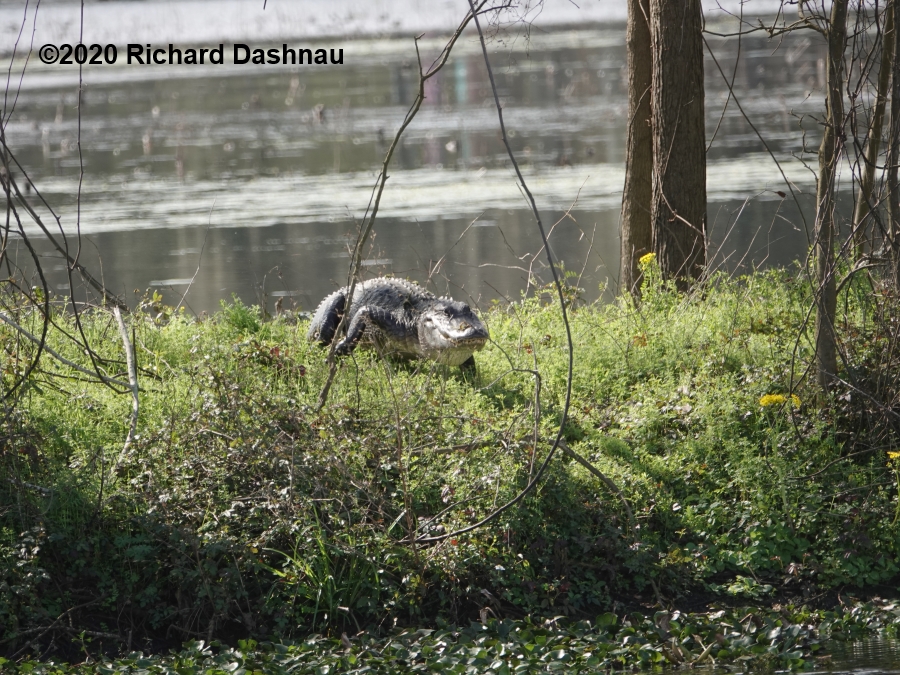
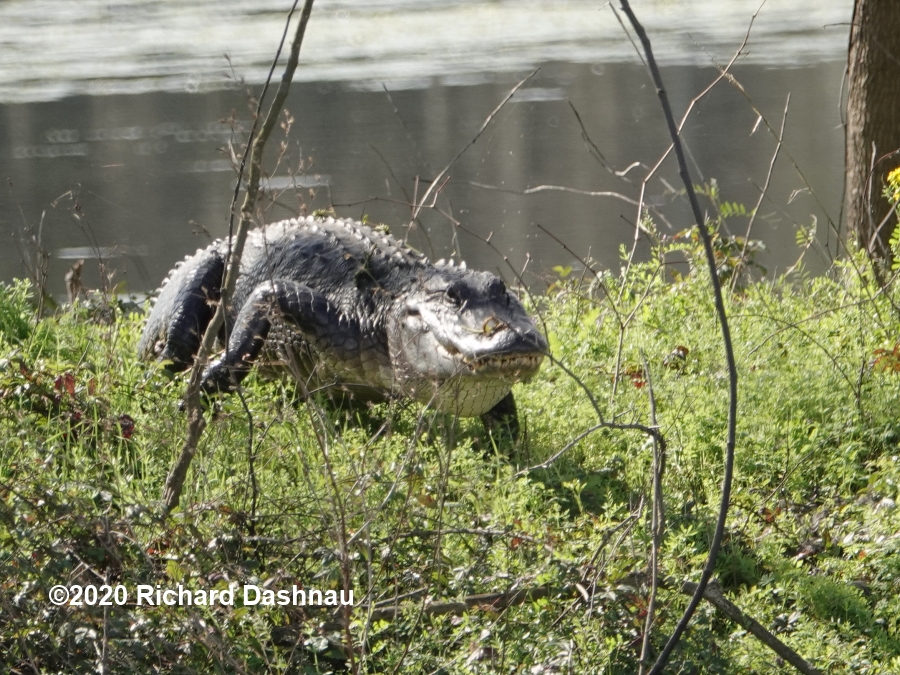
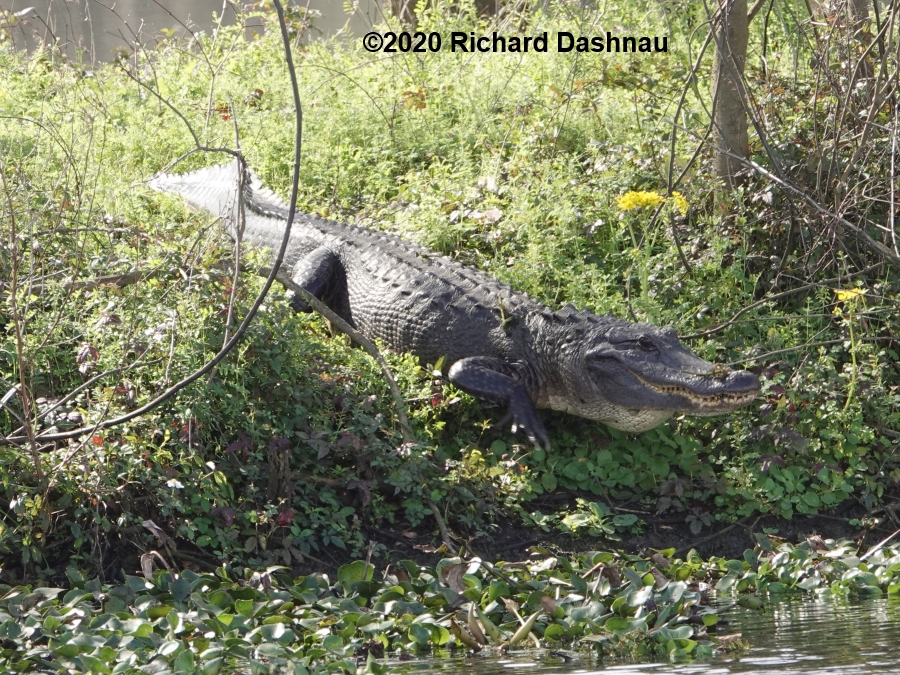
21
20
22
At
10:57 she swam back to
the pod From 11:01 - 11:05 mom moved back near the
pod. She had been gone for 45 minutes!
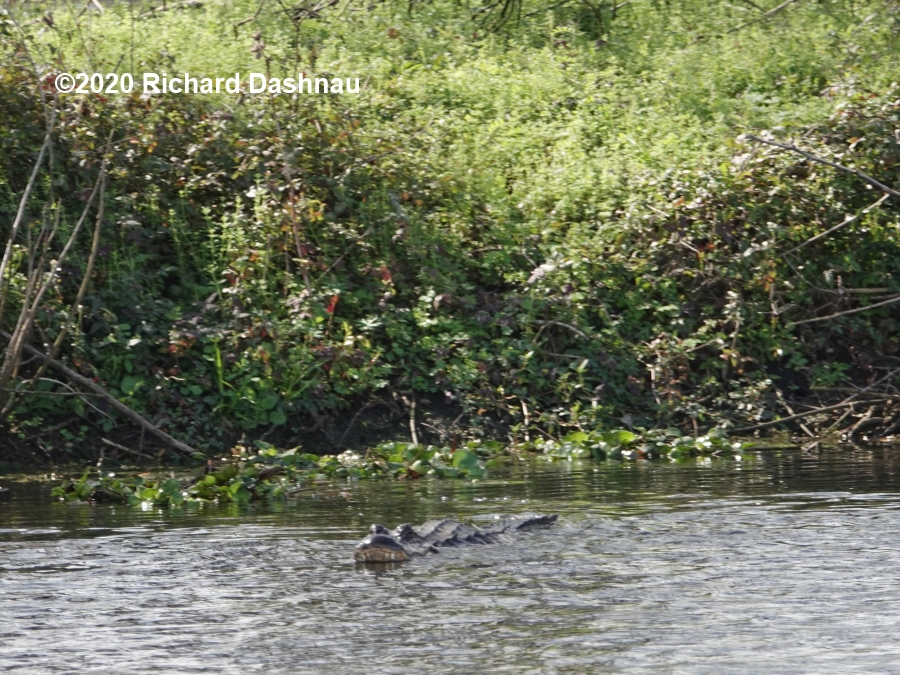
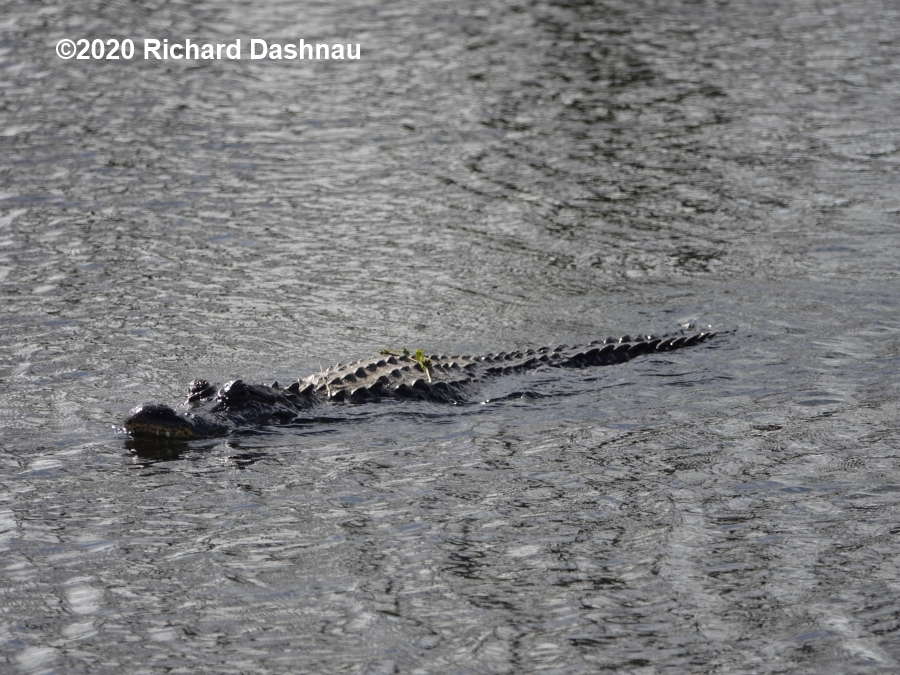
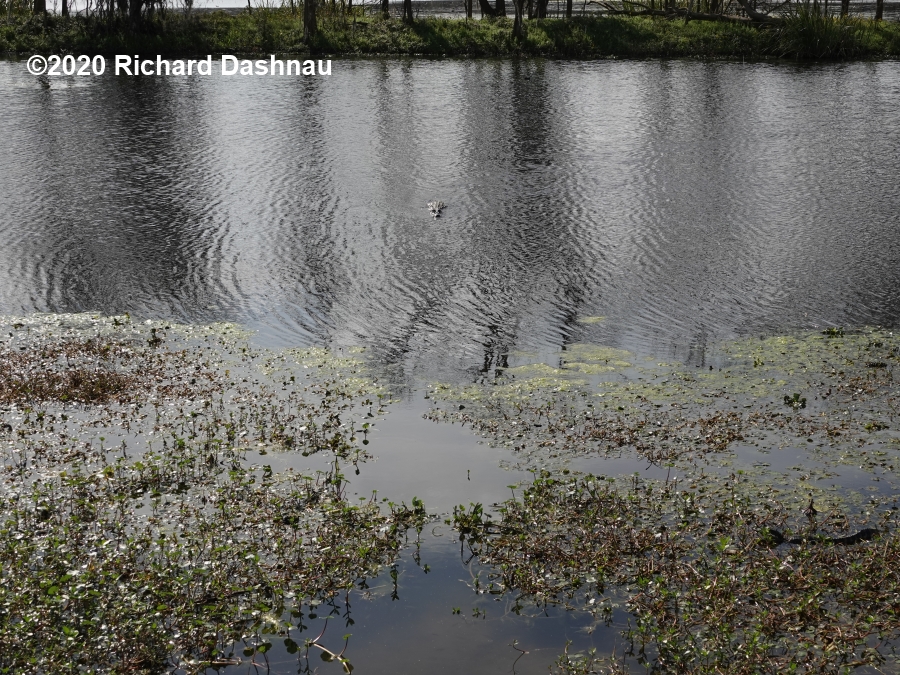
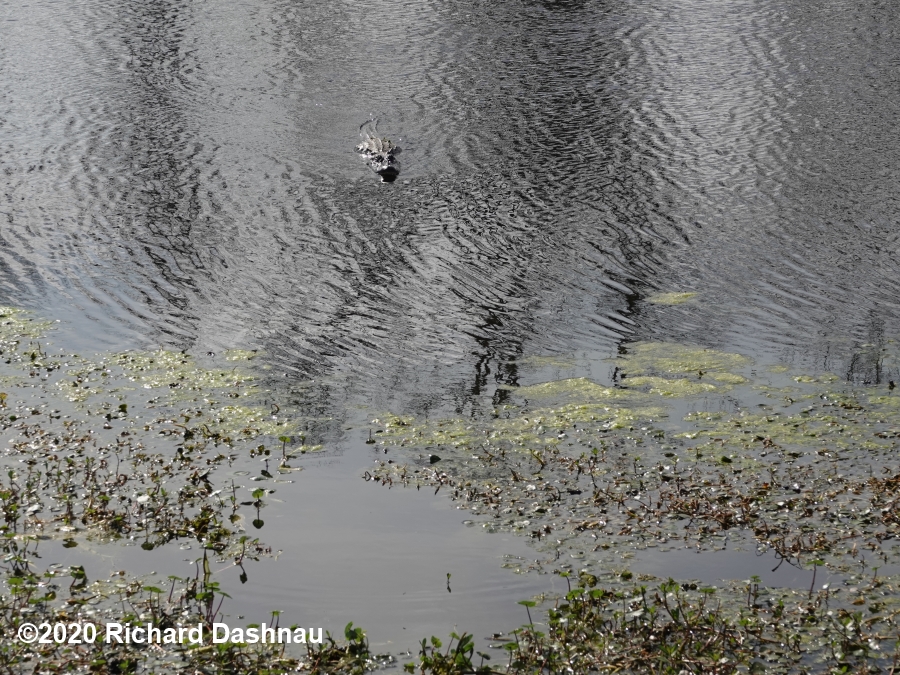
23
24
25
26
She looked at us
(I'd backed us further away from pod so mom wouldn't see us as a
threat), made a slight head lift (but no tail arch--and no headslap),
and moved
around a bit. At 11:11, she got on land
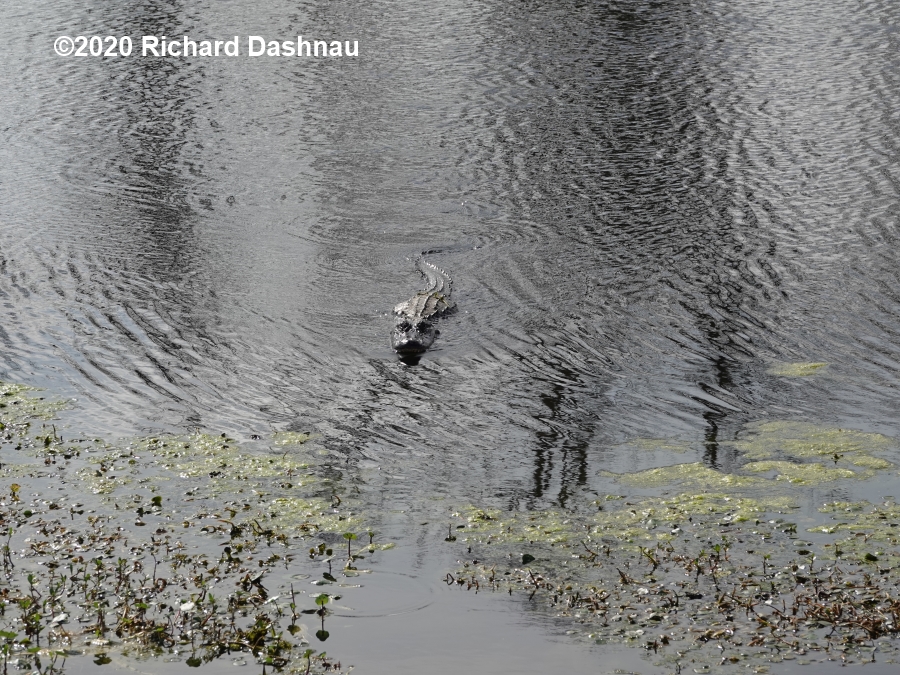
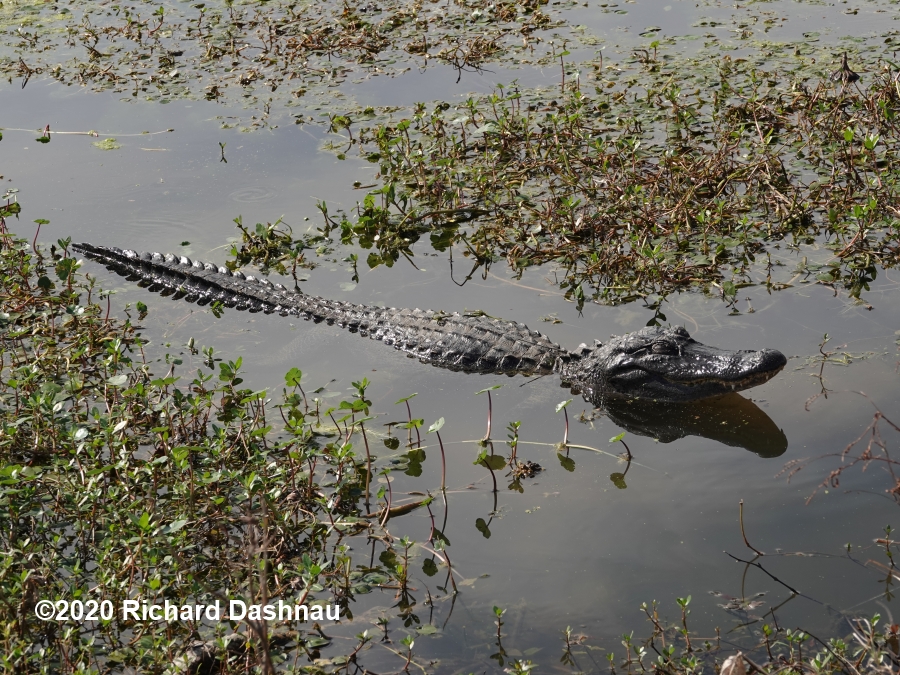
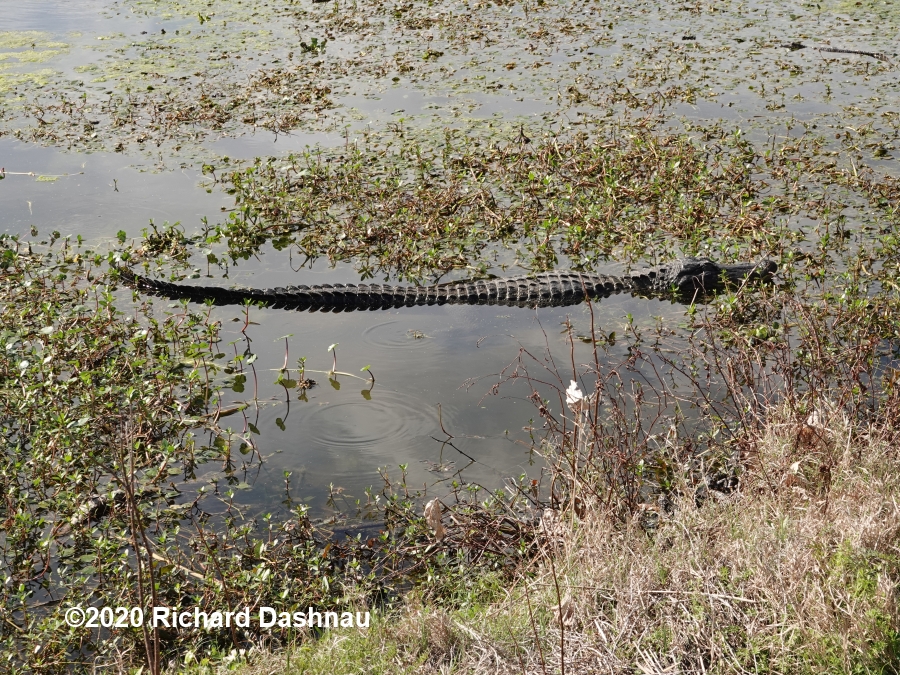
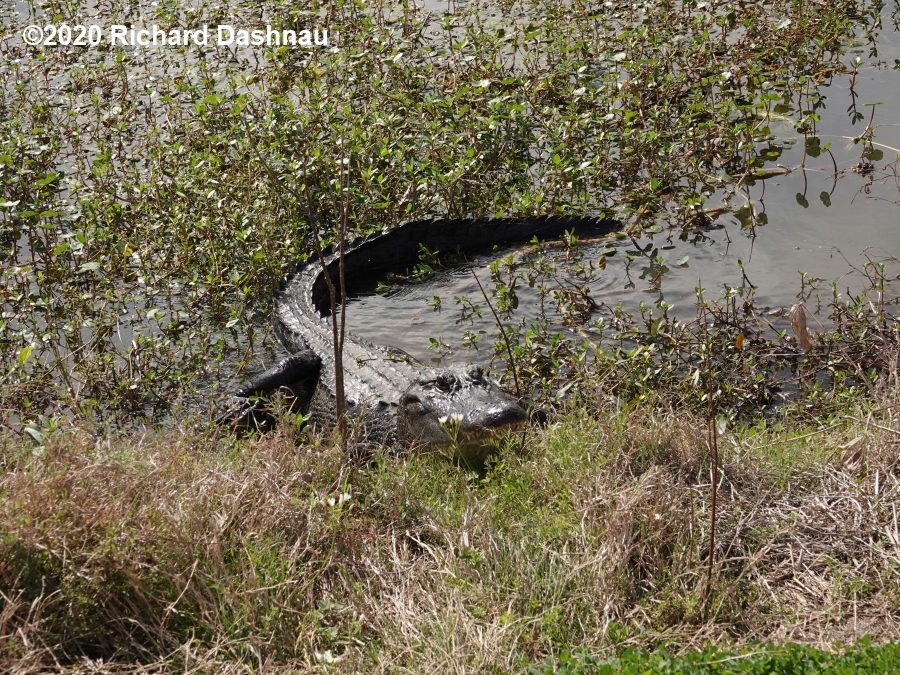
27
28
29
30
Finally,
she settled near the babies, and the babies started foraging around
their mom. I left them at about 2:00.
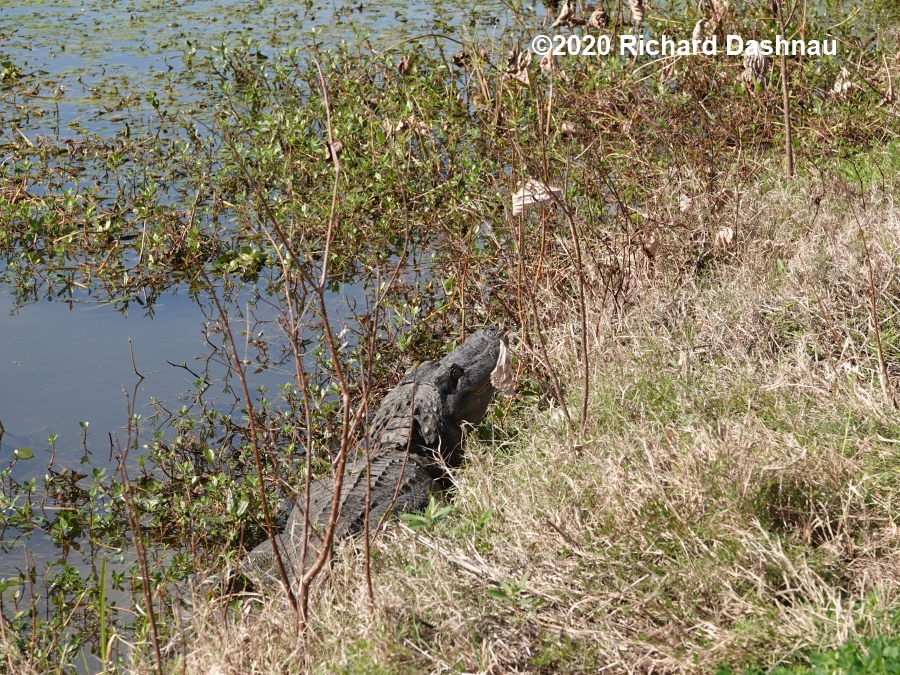
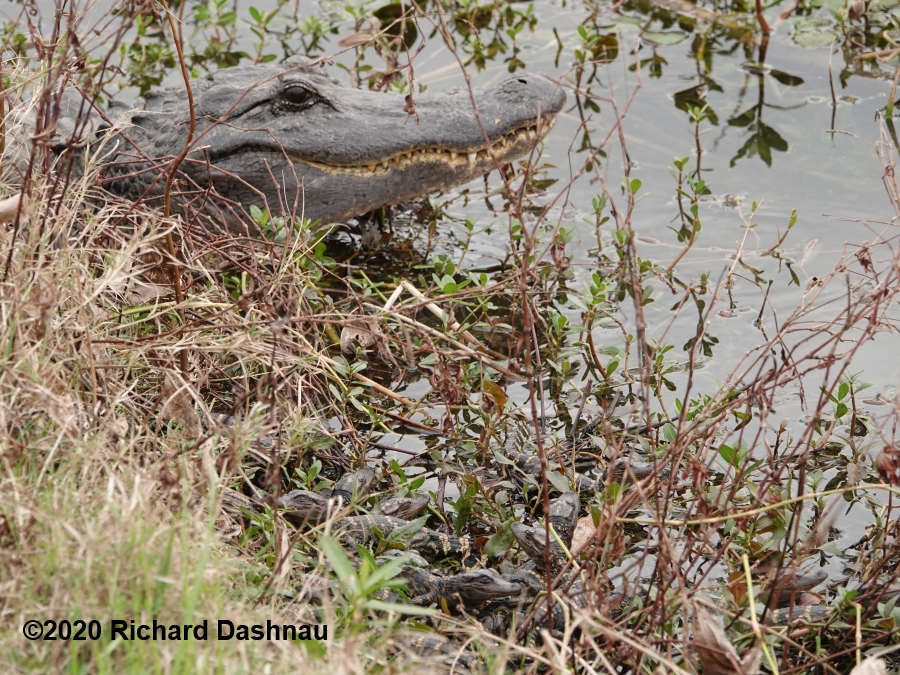
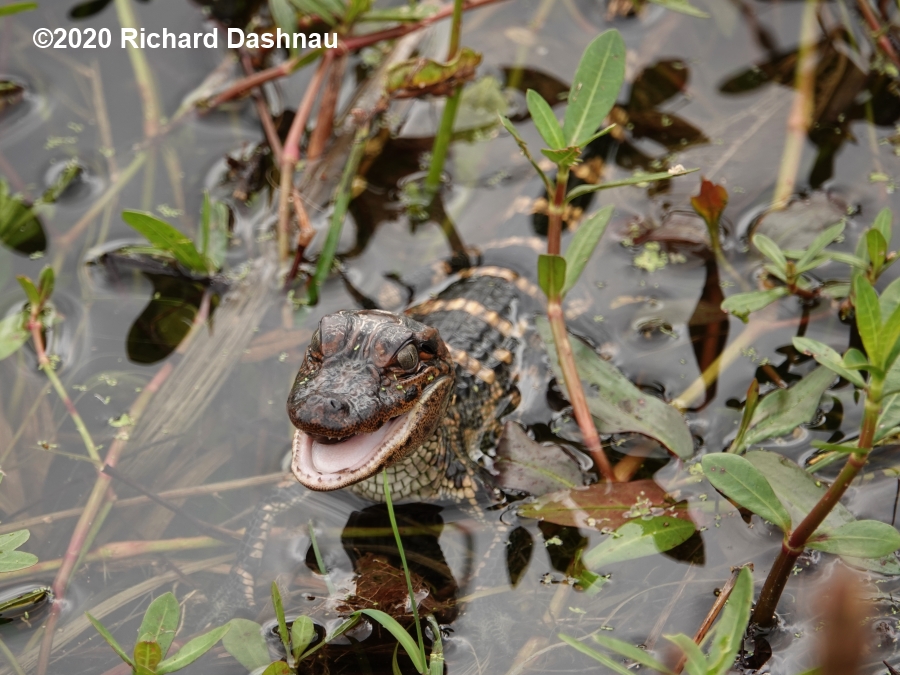
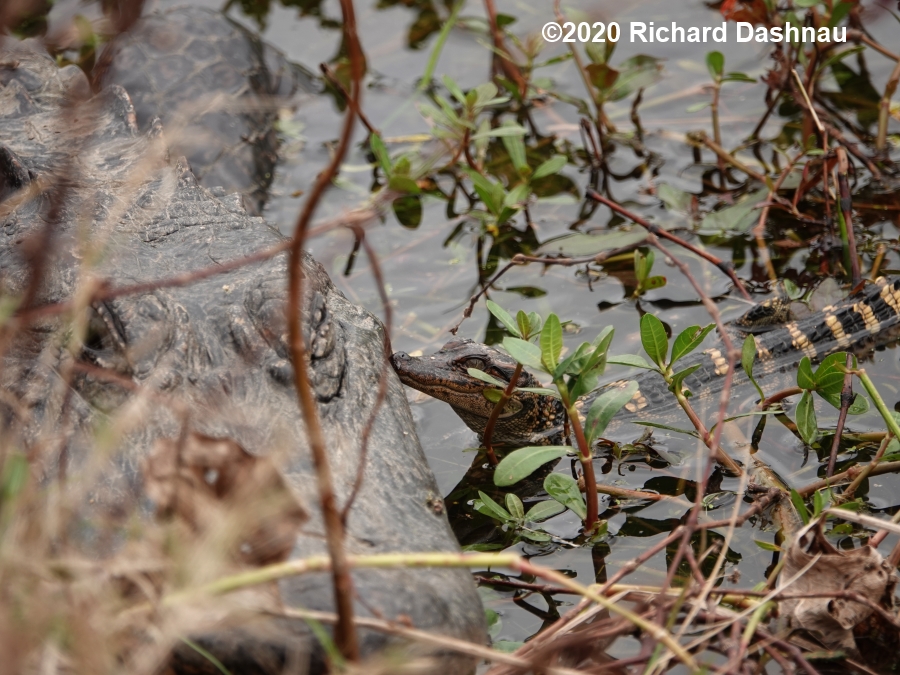
31
32
34
35
03/15/2020
This day was the last day for me to visit Brazos
Bend State Park for a while. With the warnings
about the coming pandemic, and travel and social-
distancing protocols being
put into effect, I had decided not to go to the park. Over
the weeks
that followed, protocols put into effect by the BBSP, and
the state
took the decision out of my hands anyway.
So...this morning I was
walking with 2 new volunteer trainees. I intended to show them the mom
gator and her babies, but she wasn't there! And, neither were
the
babies. That was disappointing. We had passed a large alligator
about 10 yards West of the gator den.(We walked East). While
we were
looking for the babies,
that alligator started bellowing. It was a
male. He bellowed for one bout, and stopped with a nice gape
(they do
this sometimes. I haven't looked closely at the
literature for a
description of this. I assume it's more display and not any
particular threat.) This male has a damaged right eye, and
the bright
pinpoint is that
damage--not a reflection of light.
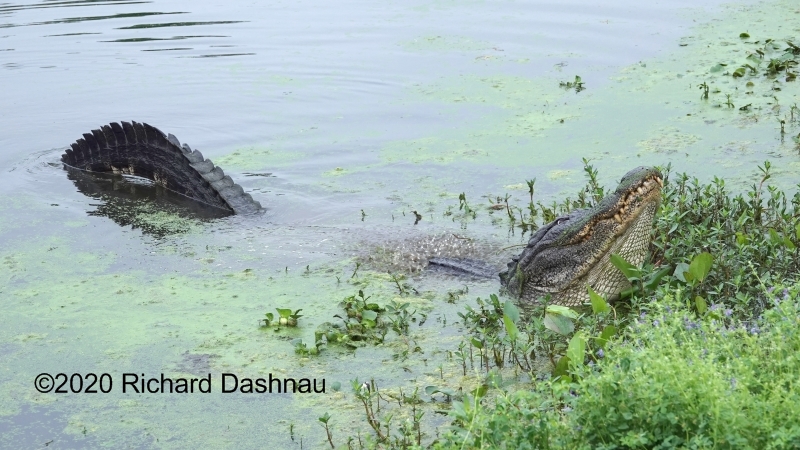
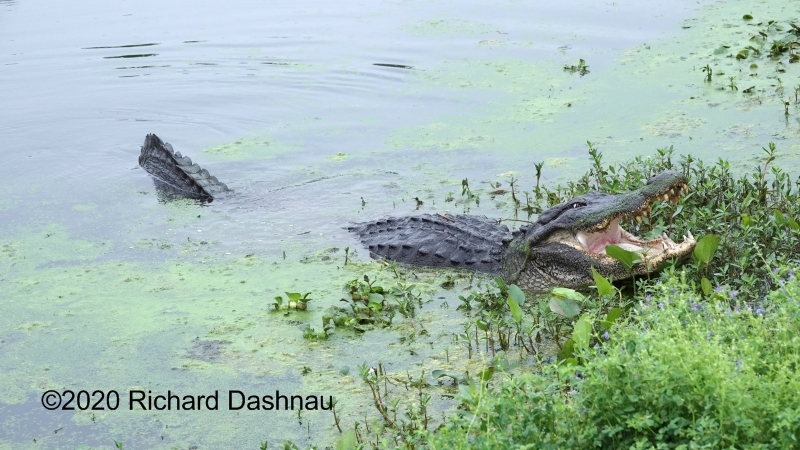
After
the male stopped bellowing, another alligator started. That
one was
about 15 yards further East of the den. Judging by the sound I thought
it was a female.
It was mostly out of the water, and hidden by the
surrounding plants, so I wouldn't have seen water over its back anyway.
I guessed that this might be the female
gator that had made the
den...and which had the pod of babies near it. Just a few
minutes
after guessing this, a park visitor noticed babies near the second
alligator.
I finally found some too, but hidden among the plants as
they were, I couldn't get any photos of them--at least none that would
relate them to the female. I do
have a picture of her bellowing , though. These three
pictures are frame grabs from video that I captured. The video
can be
seen here. That was it for my
time with her. I had the training to do, and left the park
earlier than usual.
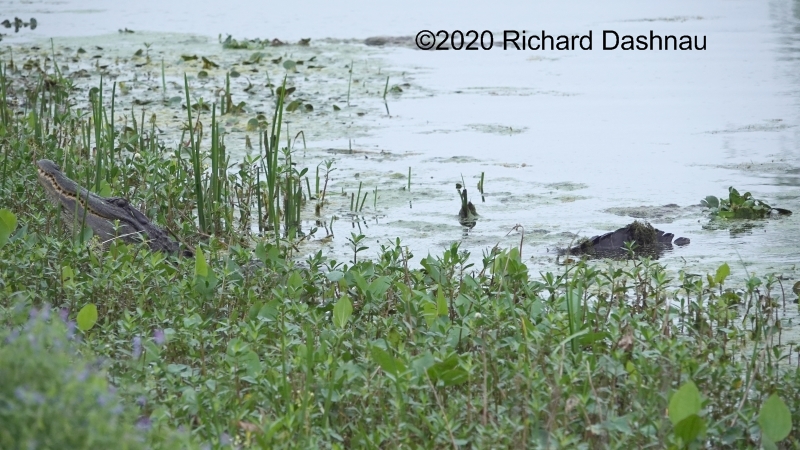
Go to my next alligator
dens page.
Brazos
Bend State Park
The main page.
Brazos
Bend State Park Volunteer's Page The
volunteer's main page.
Here are a few links to more
information on alligators. There's a LOT of it out there.
Crocodilian.com
Adam
Britton's Pages 1
Adam
Britton's Pages 2
Fish
and Wildlife Page (Text)
Fish
and Wildlife Endangered Species
Go back to my main alligator page, Alligators
Go back to my home page, Welcome
to rickubis.com
Go
back to the RICKUBISCAM
page.
Go
back to the See
the World
page.
 --
-- --
-- --
--
 --
-- --
-- --
--









 --
-- --
-- --
--











































































































